CAILLE

- Caille NEW CENTURY DETROIT
- Caille BANKER
- Caille BASE-BALL
- Caille BEN HUR
- Caille BIG SIX
- Caille CENTAUR
- Caille BIG SIX-ECLIPSE
- Caille BULL FROG
- Caille ECLIPSE
- Caille GLOBE
- Caille GOOD LUCK
- Caille LION
- Caille MUSICAL PUCK
- Caille NEW CENTURY PUCK
- Caille OPERATOR BELL DELUXE
- Caille PEERLESS
- Caille PUCK
- Caille SILVER CUP
- Caille TOURIST Counter
- Caille MIXED TRIPLET
- Caille TWIN
- Caille TWIN CENTAUR
- Caille TWIN DETROIT
- Caille TWIN ECLIPSE
- Caille VENUS
- Caille VICTOR
- Caille VICTORY
- Caille Schiemer DETROIT
- Caille Schiemer BUSY BEE
- Caille Blackcat
- Caille Liberty Bell
- Caille Wasp
- Caille Jockey
- Caille Hylo
- Caille Mayflower
- Caille Searchlight
- Caille Loving cup
Caille NEW CENTURY DETROIT
Produced between 1901 and 1905
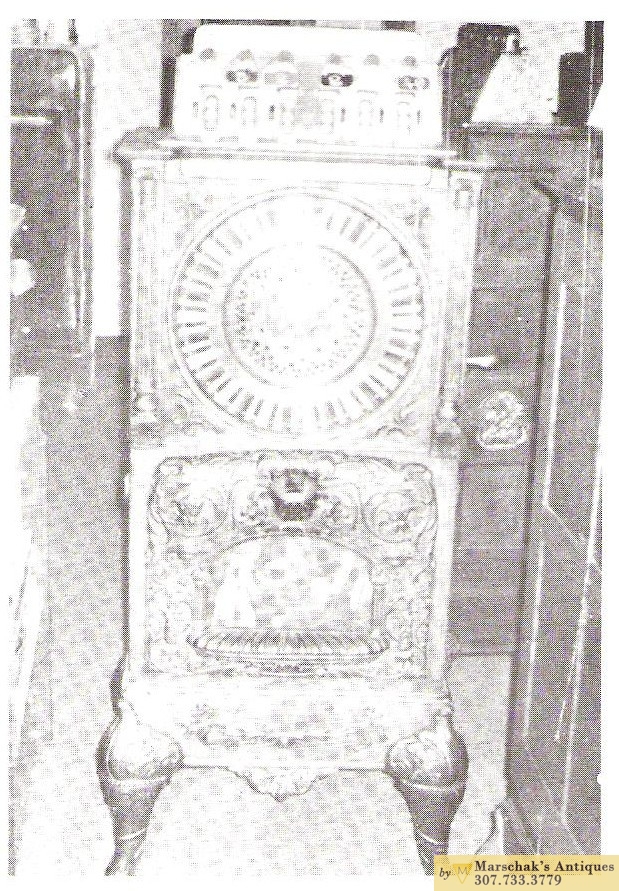
It was as easy to proliferate models way back when as it is today. Back in the forties and fifties we used to add the word “super” to everything to mean a later, improved or larger model. Evidenced are the old World War II Boeing FLYING FORTRESS and SUPERFORTRESS bombers. Post-war Bally and Keeney slot machines added words in much the same way. Witness the Bally DRAW BELL and the later DELUXE DRAW BELL. In our own day, there’s the “Mark II” anything, and the beginning usage of expressions about “21st Century Technology.” We’ve come full circle, proving that people never really seem to change. Well, their things do; but their basic thinking doesn’t.
SO go back to the early 1900’s. You could make a new machine or a new model of an old machine and call it the “20th Century Something.” Mills copped the name fast for their brand new TWENTIETH CENTURY floor machine, so Caille Bros. was caught cold. They’d get killed if they put “20th Century” on an upgrade, so they picked another pop expression of the day for their remakes of 1901, batting out “New Century” machines. The richly decorated NEW CENTURY DETROIT was a lot better looking than the old slab cabinet Caille-Schiemer and later Caille Bros. DETROIT, so it got the new name. The amazing fact is that they were selling the old and newer models at the same time, and you’ll find all four the DETROIT and NEW CENTURY DETROIT, both in “plain” and “music” models in the Caille Bros. ad reproduced elsewhere in this book.
The Caille NEW CENTURY DETROIT is one of the classiest machines you can own, and for that reason it tends to be worth more than a lot of equally good looking machines. Rarity has a lot to do with this, as there are far fewer NEW CENTURY DETROIT machines around then DEWEYS and NEW CENTURY PUCKS among others.
The DETROIT and the NEW CENTURY DETROIT are akin to the Mills ON-THE-SQUARE in that the stopping action can be seen from the players’ side. But the Caille creation is a lot spiffier. See the holes on the disc in the center of the wheel? Well, what happens is that there’s a hole for each color, and when the wheel stops a plunger pokes its way through one of the holes with the appropriate color paying off provided You played it. It’s a heck of a mechanical show. Caille got competitive in their ads, saying “Several imitations of this machine have been made with a bluff’ ratchet wheel on outside but the deception is so thin it fools nobody, making this (NEW CENTURY DEIROIT, by Caille, of course!) the king of all play getters.”
Caille BANKER
Produced between 1906 cud 1916
 You gotta have a gimmick! Back in the days when everybody was vying for the same business and all coin machine makers were pumping out new ideas by the dozens and storekeepers were beseiged by offers for machines that would do more for them than any machine already on the market, it took more than having exactly what the other guy had to put a machine across. It took gimmicks, and lively salesmanship.
You gotta have a gimmick! Back in the days when everybody was vying for the same business and all coin machine makers were pumping out new ideas by the dozens and storekeepers were beseiged by offers for machines that would do more for them than any machine already on the market, it took more than having exactly what the other guy had to put a machine across. It took gimmicks, and lively salesmanship.
What the storekeepers wanted if they wanted coin machines at all was a rent payer. So the profit performance of a machine came first. That’s where Caille Bros. had a gimmick in the BANKER Take a good look at the machine. If you can keep from being dazzled by the nickel plated castings, the new name, and the other elaborate trim you’ll see it for exactly what it is it’s nothing more than an UPRIGHT PERFECTION. But with Canda first, and then Mills and Kelley on the market with the same machine, Caille Bros. decided not to play me-too and took the route of salesmanship. The BANKER mechanism is exactly the same one Caille Bros. used for the GOOK LUCK series (itself a renamed LITTLE PERFECTION), and the cabinet is the same as the UPRIGHT PERFECTION with the addition of elaborate trim so characteristic of Caille Bros. Literally, only the name is new.
BANKER came in four models, and examples of all of them can be found in collections. The BANKER line parallels Kelley’s THE KELLEY line, coming in either plain card, or card machine plus gum vender models. Caille took the machine a step further, providing both models with or without a swivel base, with the stationary models having small rubber feet so that they wouldn’t scratch the counter.
The final sales gimmick was pure Caille. Names like UPRIGHT PERFECTION or THE KELLEY describe the type of machine, or tell who made it. Caille elected to use a name that would help sell the machine and tell the shopkeepers what it would do for them; ergo, THE BANKER. Bankers, as we all know, make nothing but money. They sold a lot of them as the survivors testify.
Caille BASE-BALL Counter Single
Produced between 1911 and 1917
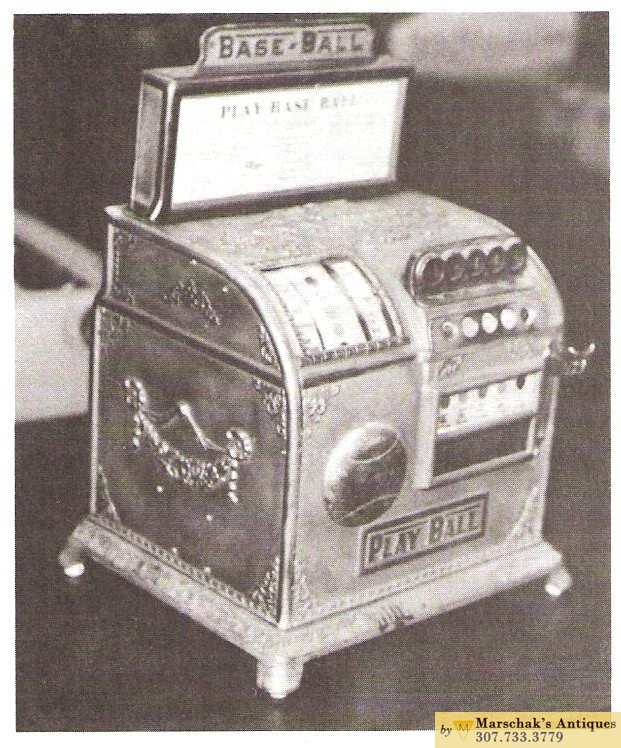 Good looks have a lot to do with the desirability and collectibility of an antique slot machine. Not all coin machines are worth thousands and thousands of dollars, even though it seems like they are. But the ones that look good are generally worth more than the others. In short, good looks often determine a value, often more so than rarity.
Good looks have a lot to do with the desirability and collectibility of an antique slot machine. Not all coin machines are worth thousands and thousands of dollars, even though it seems like they are. But the ones that look good are generally worth more than the others. In short, good looks often determine a value, often more so than rarity.
Then there are those machines that don’t look really bad, but frankly, ain’t no beauties. The Paupa And Hochriem ELK falls in this bunch for my money. It’s cast iron, exciting, mechanically clever and a coin machine classic that is akin to a mud fence. Then the BASE-BALL came along. Well, not exactly in that order. The Paupa And Hochriem ELK with its center pull play lever became the Paupa And Hockriem right pull play, to be picked up and copied by Mills, and then Caille Bros. and then Watling. At Mills, it also became the SPECIAL and a number of variations and over at Caille it became the TIGER and then spun off into a lot of TIGER, SPECIAL TIGER and export LE TIGRE models and by now the ELK had become a herd of other beasts and beings (not the least of which are the as yet maker unidentified GOOSE and DUCK models.). They all have 6-way coin heads (except the French LE TIGRE, which has a 3-way, and the super rare 5-way Caille SPECIAL TIGER with a side crank handle rather than the right front push lever) and they’re quite a bit alike. Until BASE-BALL.
The 5-way Caille BASE-BALL takes a different hit at things, and comes out of the box looking different and somehow nicer. It’s a penny machine and was made for cigar counters and ice cream parlors more so than the customary heavy-hitter saloon and pool hall locations. By 1911 and the teens soon to follow, the game of baseball filled out its shoes as The American National Game. It was bigger and even more popular then than it is now for there was little football and soccer had yet to rear its European head. Baseball was on everybody’s lips — and on candy and cigarette cards — and during the season robbed the headlines on the newspapers. Radio hadn’t yet come along as a public entertainment –it would take World War 1 and the immediate post war years to accelerate its development and open the doors to commercial broadcasting — and television wasn’t much more than a theory. But poster printing was booming and most big cities had ball clubs easily reached by street cars. So the expression “Play Ball” was common (meaning “let’s get started”) and most people had a favorite team (for which they’d be willing to fight for, if someone insulted it).
So Caille made a beautiful nickel plated adaptation of its SPECIAL TIGER called BASE-BALL with the words “Play Ball” on its front casting just below a cast iron baseball art element. New and colorful marquee, reward card and reel graphics make it a different machine. Payouts are in tokens from five payout tubes inside, spitting out checks worth 50 to 300. It was also made in nickel play, but the penny play model is the most prevalent. Even so, it’s a BASE-BALL only skin deep. Unscrew that cast iron baseball and you’ll find a tiger’s head. Keep digging and you’ll find other variations. Industry Novelty Company (later to be O.D. Jennings) modified Caille BASE-BALL machines and put their own name on them, and Silver King in Indianapolis stuck their reward cards on Caille models to operate them. The model varieties are enough to field a whole team.
Caille BEN HUR Counter Machine
Produced between 1908 and 1932
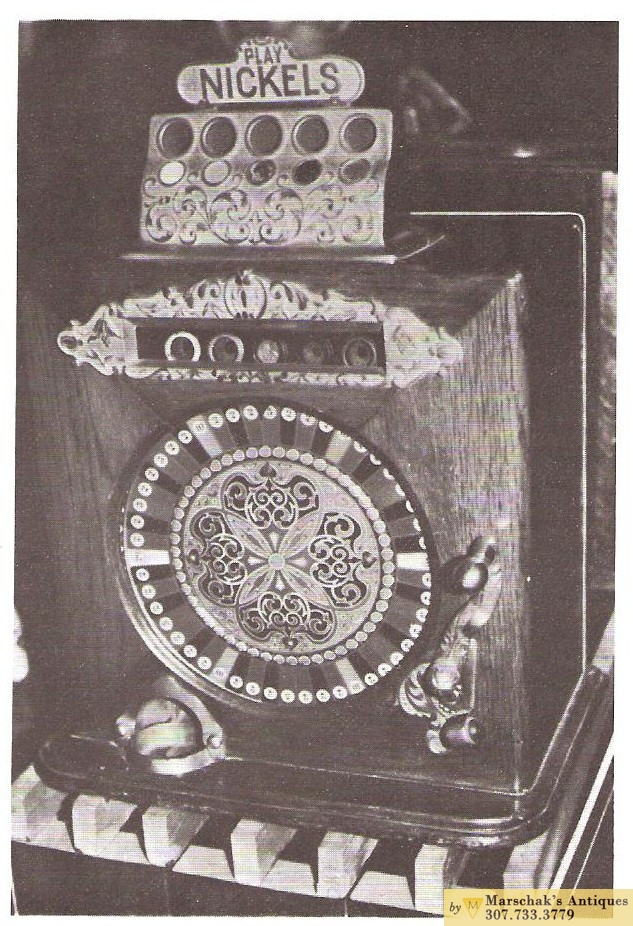
The Caille BEN HUR is a 5-way miniaturization of the upright automatic color wheel machine and its counter counterparts, such as the OWL JUNIOR. BROWNIE and the like. When Caille Bros. first introduced the machine in 1908 they called it the “smallest automatic money paying machine made”. Looking at it today, it doesn’t look so small, but when you compare it to an OWL or a BROWNIE you get the point.
It certainly was the smallest pluggable machine. True to the requirements of the day, the early BEN HURS have automatic percentage plugs behind the wheel. When the machine first came out it sold for $50 in nickel play and $60 in quarter play, going up ten bucks each in the teens. Perhaps the best looking small marquee in slot machinedom graces the top of many of the surviving BEN HURS, saying “Play Nickels” or “Play Quarters”. This marquee has been re-produced in bronze, ready for plating, and has shown up on a lot of restored machines in spite of the fact that it is strictly a BEN HUR item.
Caille Bros. named the machine after the popular biblical novel by Lew Wallace first published in 1880. The book was so popular the chariot race was just as exciting in print as it was in Technicolor four generations later—that the story remained constantly alive in print, on stage and in the earliest movies well into the Twentieth Century.
BEN HUR was sold new well into the twenties, getting a new lease on life with an improved model introduced in 1928. It was the last of the automatic color wheel machines to retain its popularity on slot machine routes all over the country, and as a result examples are located almost anywhere. Most of the BEN HUR machines that collectors believe to be Victorian pieces were actually made in the late 1920’s or early 1930’s. By that time, the prices had doubled, with new BEN HURS selling for Sl 10. in nickel play and $120. in quarter play in 1928.
The BEN HUR is a marvelous looking machine with its natural stained wood cabinet and gilded wheel. In spite of its long popularity it is one of the most Victorian looking machines that you can have in a collection. In its earlier models the cast iron trim could be had in nickel plate or oxidized copper. Most of the surviving machines are in nickel plate so the copper model is regarded as prime. ,There is no count of the surviving examples, but to judge from their collectible popularity somewhere between fifty and a hundred must be around. The number might
even go over a hundred if you count the non-collectors who have them in basement play rooms or bars, usually getting them as family heirlooms when they were saved after the dismemberment of Grand-pa’s drugstore or saloon.
Caille BIG SIX Floor Wheel
Produced between 1904 and 1916
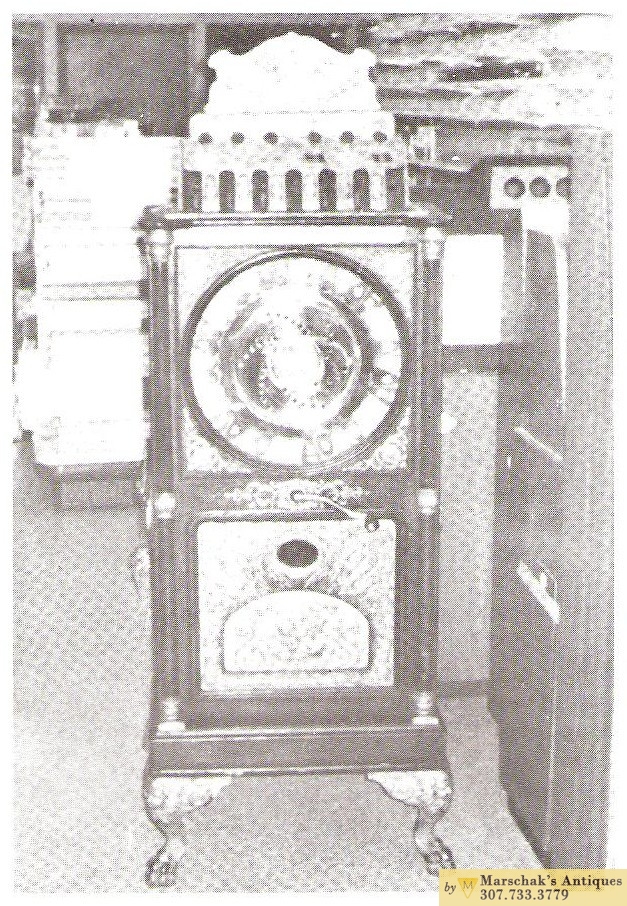
When anyone came up with a new machine name and format that sold, everyone else copied it. Well, the big manufacturers did. So when Watling came up with a machine called BIG SIX it wasn’t long before Mills and Caille Bros. followed suit. And wouldn’t you know, they all had the same kind of wheel. While most collectors feel the Watling BIG SIX is worth more. The reason seems to be the simple fact that it’s a Caille. For one thing, it’s rarer. For another Caille jazzed theirs up a bit by adding their fabulous drilled center disc, permitting a plunger to enter from the rear to stop the wheel. It’s clever. Finally, collectors of the truly elegant Caille machines are generally restricted to the ECLIPSE and CENTAUR, so it’s nice to have something different that matches.
It can almost be said that the BIG SIXES were the forerunners of the liberal slot machines of today. In a day when the wheels were plugged and percentage clips or “bugs” kept machine payouts low, the BIG SIX machines paid 5-for-1 on every color. All you had to do was pick the right one twice in six plays and you were money ahead. If you consistently hit one out of three or four you could make a bundle. For that reason alone, and the fact that the stop action was in full view of the player, the BIG SIX machines were regarded as the most honest of them all. The odds aren’t any worse than they generally are in Las Vegas or Reno today, with the Caille BIG SIX returning 83% of the handle to its players. The question seems to be why aren’t there more around? You would think that a machine this popular would have survived in much greater numbers than it has. Unless, of course, it’s very liberal stance made it unpopular with its owners and operators so it didn’t sell too well.
Speaking of selling well, there’s a very surprising twist to the story of the Caille BIG SIX. Caille Bros. produced it up until World War I, and then stopped. Twenty years later a machine rebuilding outfit in Providence, Rhode Island, bought up as many of them as they could find, fixed them up, and sold them as good as new machines. Their ad, appearing in the December 15, 1934, issue of THE BILLBOARD, had a nice picture of the old Caille BIG SIX floor wheel. The copy said: “Slot Operators. Good times are here again. Caille BIG SIX. 5/25/50 cent. An ideal machine for clubs, inns, taverns, road houses. An old timer, but a proven money maker. Rebuilt and thoroughly overhauled like new.” That would make the Caille BIG SIX the last and longest lived floor machines to go on location. So where are they?
If you feel lucky and want to track these down, look up the ad. Who knows, you might find a restored machine. Restored, that is, almost half a century ago.
Caille CENTAUR Floor Machine
Produced between 1907 and 1916
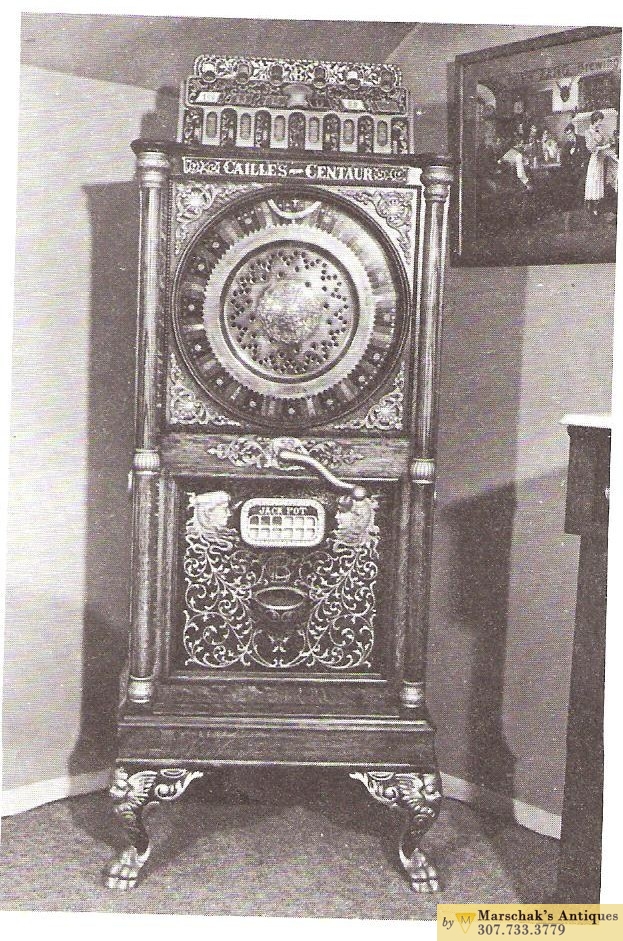 It is perhaps fitting that the last floor machine to be included as a prime collectible is the 6-way Caille Bros. CENTAUR, one of the richest looking and most colorful floor machines ever made. The CENTAUR is a direct development of the Caille ECLIPSE. Just as the Mills DEWEY had been developed into the DEWEY JACKPOT with the addition of a large glass covered jackpot over the payout cup, Caille Bros. modified their ECLIPSE to accomplish the same thing. They gave it the name CENTAUR which, while not as descriptive as using the word “jackpot” in the machine identification gave it an aesthetic quality that was so often characteristic of Caille machines. The Centaur of legend was a man with a horse’s body and legs, in essence a mixture of two successful beings. So was the CENTAUR: It didn’t really matter though. Most buyers, with a pragmatic turn of mind, usually ordered the machine as the “ECLIPSE Jackpot”.
It is perhaps fitting that the last floor machine to be included as a prime collectible is the 6-way Caille Bros. CENTAUR, one of the richest looking and most colorful floor machines ever made. The CENTAUR is a direct development of the Caille ECLIPSE. Just as the Mills DEWEY had been developed into the DEWEY JACKPOT with the addition of a large glass covered jackpot over the payout cup, Caille Bros. modified their ECLIPSE to accomplish the same thing. They gave it the name CENTAUR which, while not as descriptive as using the word “jackpot” in the machine identification gave it an aesthetic quality that was so often characteristic of Caille machines. The Centaur of legend was a man with a horse’s body and legs, in essence a mixture of two successful beings. So was the CENTAUR: It didn’t really matter though. Most buyers, with a pragmatic turn of mind, usually ordered the machine as the “ECLIPSE Jackpot”.
There are probably more CENTAUR machines around than DEWEY JACKPOTS, so it seems that Caille Bros. might have pulled out ahead of Mills in at least one area. Perhaps the answer lies in the construction of the jackpot feature. Many of the DEWEY JACKPOT machines are found with the jackpot window smashed, suggesting that enthusiastic players found a more direct way to go home with the jackpot money. The Caille CENTAUR, on the other hand, put the visible jackpot behind bars, making it extremely difficult to break into the coffers.
CENTAUR cabinets are a marvel of markmanship, with the natural stained wood finish offset by a variety of great castings that were originally available in nickel plate, bronze or “Roman Gold”, a golden or molu finish. In the latter case, the results are just short of garish, with the machine practically visually jumping out of a dark room.
The 1912 price for a CENTAUR was S180. in nickel play; higher for quarter or half-dollar play, with each model S30. higher for music. Throughout its service life the CENTAUR sold for and was worth more than the DEWEY JACKPOT. The CENTAUR was also produced in an export model called GRAN PREMIO, or “Grand Prize,” a name that was retained by Caille for a later line of counter-top slot machines in the thirties.
Caille BIG SIX-ECLIPSE TWIN
Produced between 1904 and 1916
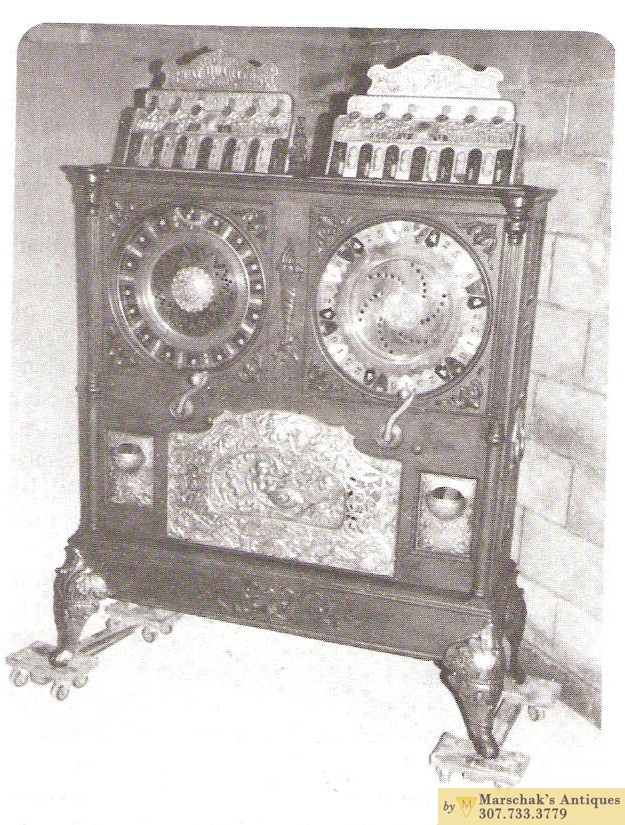 The biggest maker of TWINS, or TRIPLETS for that matter, was The Caille Brothers Company in Detroit. It was a Caille specialty. Lucky for us it was, for the Cailles are the flashiest machines in collectordom. Just look at this fantastic thing! It’s value as an antique reflects this desirability. In fact, everything reflects in it. There’s so much nickel plate on the cabinet, wheel faces and coin heads this machine must have almost glowed in the dark in any dimly lit saloon.
The biggest maker of TWINS, or TRIPLETS for that matter, was The Caille Brothers Company in Detroit. It was a Caille specialty. Lucky for us it was, for the Cailles are the flashiest machines in collectordom. Just look at this fantastic thing! It’s value as an antique reflects this desirability. In fact, everything reflects in it. There’s so much nickel plate on the cabinet, wheel faces and coin heads this machine must have almost glowed in the dark in any dimly lit saloon.
More than anything that’s what this machine is; a saloon collectible. Few of the larger and more professional antique price guides the ones that cover any and all antiques and collectibles list slot machines (or even coin machines, for that matter) as a separate collectible classification. But if you look under saloon collectibles you’ll find the old floor machines and, in the better guides, doubles like these. They are unique, big, beautiful and expensive. But so what! If you can afford one and want one you’d be nuts to pass it by for the simple reason that class tells. I can’t help but believe that no matter what happens to the collectibles market a good piece will always be a good piece and a good investment. A double like this sitting in the corner is like money in the bank at 15% interest. When other prices stabilize, as they say, a prime piece like this will always bring what the traffic will bear. I only wish I had been smart enough to see this years ago. But in the antique business slots in particular you can’t look back (or you’ll shoot yourself!). So if you’re into advice I just gave you some.
If you’ve followed these guides you know the Caille BIG SIX; it’s in Volume 2, Page 70. Ditto for the Caille ECLIPSE, Volume 1, Page 29. Put them all together and you spell awesome. This particular machine has been sitting in a collection for years, has the Caille serial 147 and a piece of paper dated 1909 inside the cabinet. The play is 25¢ ECLIPSE and 5¢ BIG SIX but it could have been the other way around and was indeed preferred that way. Caille also made it in 25¢/50¢ play but I’ve never seen one. It takes a lot of reading of Caille catalogs and sales literature to get a real picture of what goes on here for the combination is tricky as hell. For some reason it was never all written up in one place. That in itself is reason enough for a slot paper collection for such printed knowledge is your only way of knowing what the machine itself can never tell you.
So here are some excerpts from Caille literature.
From Booklet M, 1912: “Great combination. ECLIPSE has percentage which plugs high colors when played and leaves them open when low colors are played. BIG SIX has no percentage but is a sure winner. Trimmings nickel, antique or Roman Gold. Casters on legs. Equipped with music if desired.”
From Caille Catalogue 509, 1909: “The ECLIPSE is an extremely popular machine and when coupled to the BIG SIX the result in an irresistible combination machine that will get a big play in any location. Separately and together, as shown, these have stood the test and have always filled all requirements. The ECLIPSE has the automatic percentage regulator but has a “fixed” system that is always sure of making good. It is advisable to have ECLIPSE for nickels and BIG SIX for quarters.”
Caille BULL FROG Floor Pocket
Produced between 1900 and 1902
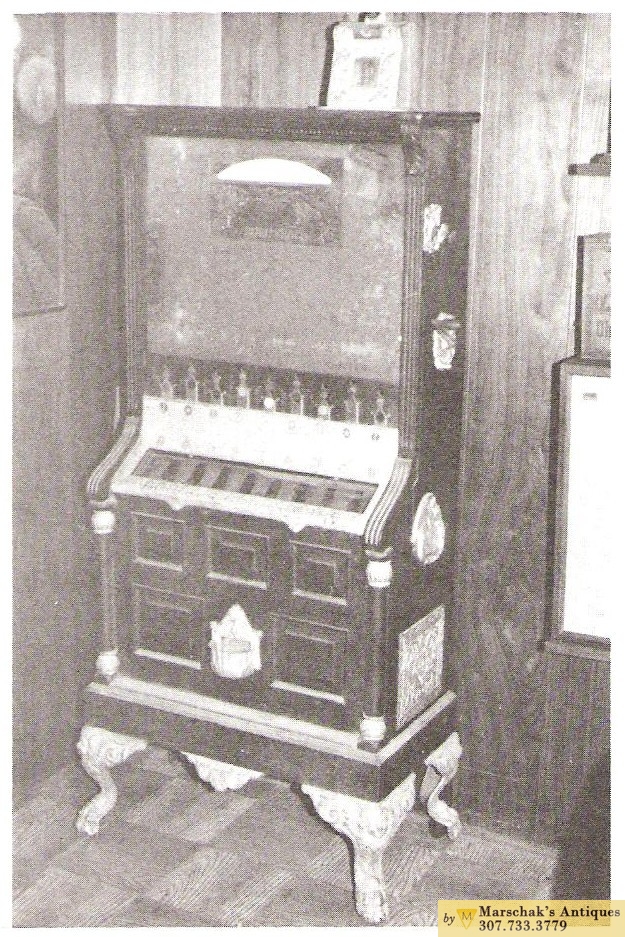
Things sure change fast in the field of antique slot machines. As these words are being written exactly two full years have passed since the volume 1. “An Illustrated Price Guide to the 100 Most Collectible Slot Machines” was published. Two years and six days to be exact. Yet in volume 1, under the description of the Mills CRICKET on page 31, these words are carried: “Caille Bros. made an almost exact copy of the CRICKET, coming out less than six months after the Mills model. They called it the BULL FROG. There have been a lot of rumors to the effect that collectors in Texas, Georgia, Minnesota and elsewhere have BULL FROG machines, but to date none have been confirmed”.
The ink was barely dry on volume 1 when the BULL FROGS began to show up. A collector in Utah had one all along. Then, before the year was out, one of the rumored BULL FROGS surfaced in Texas. In 1979, two more showed up in Wisconsin. So there are four confirmed, and maybe two more, or four more, if the rumors about Georgia, Minnesota, Northern Michigan and that same barn in Wisconsin are true. Instant inventory!
The most interesting part of these finds is that they seem to indicate that the BULL FROG was a line of machines, not just one model. Of the discovered models there seem to be two distinct variations primarily, the coin heads are different with both different than the BULL FROG machines depicted in the old Caille Bros. Co. catalogues.
The Caille BULL FROG, like the Mills CRICKET, is a super overgrown coin drop. But what a drop! They are like enormous TARGET machines (see the trade stimulator volumes) with the added kicker of visible jackpots. If your coin goes into one of the proper holes the jackpot below it can be dumped by turning a handle and you get all the money you see. One interesting feature of the BULL FROG is the ability to regulate the payout percentages. You can set the jackpot gates practically shut so the player has a really tough chance at hitting a pot. If you aren’t careful you can tighten the payout off to zero, leaving you with a no-payout machine. Maybe the old operators did that, and maybe that’s why BULL FROG machines are rare.
The Caille has another unique distinction and that’s the origin of its name. Back in the early 1900’s the motto “Watch us Jump” was known across the country. It was for a new gold mining town in Nevada named BULL FROG. So when Caille made a payout floor machine with coins that jumped, they named it after the gold mine. There’s one thing about that original volume 1 description that did hold up. Comparing the Caille machine to the Mills CRICKET we said “Because of its rarity BULL FROG values, if such machines do exist, would be half again or even twice as high”.
Caille ECLIPSE Floor Machine
Produced between 1904 and 1916
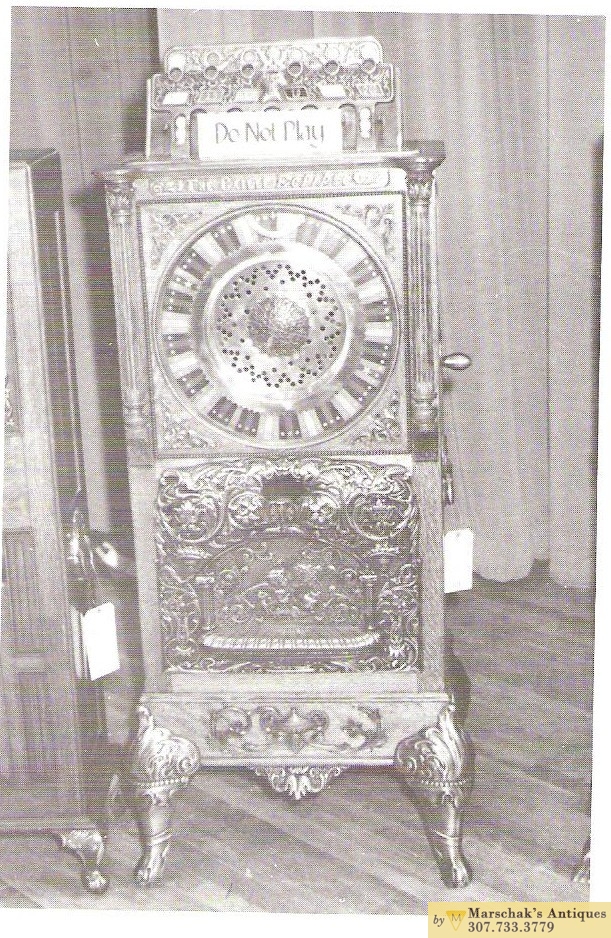
The 6-way ECLIPSE is the crown jewel of the Caille Bros. line of floor machines. It was created as a direct competitor to the already successful Mills DEWEY and virtually paralleled the DEWEY line in modifications and advanced developments. There aren’t as many ECLIPSE machines around as there are DEWEY’S, but its large surviving population makes it the second most numerically important floor machine collectible next to the DEWEY.
The ECLIPSE has a tube payout and a wheel with 92 spaces. There aren’t quite as many variations in the castings and the glass as there are with the DEWEY, but quite a variety is known. Probably the most outstanding features are the castings which are rich in flowing robes, swirls, and detailed trim. But it’s the coin head that first catches the eye. It’s magnificent, and big. The Caille ECLIPSE was made in nickel, quarter and half-dollar models, all 6-way, with music available with any coinage as the MUSICAL ECLIPSE. In 1909, the machine sold for $120 in the nickel model; $150 with music. By 1912, the prices had gone up to $145 plain and $175 musical. CHECK ECLIPSE and MUSICAL CHECK ECLIPSE models were also produced, as well as twin and triplet models. Cabinets were natural stained wood with castings and trim available in nickel plate, bronze, or “Roman Gold”, the latter an artificial golden finish. Most of the surviving machines have been found in nickel plate with bronze running a far away second, so it would seem that most ECLIPSE buyers were somewhat conservative after all.
The Caille ECLIPSE was also the basic component for the best selling line of multiples in the industry. The ECLIPSE TWIN was generally available in two models, mixing 5 cent-play and 25 cent-play and, for the high rollers, 25 cent-play and 50 cent-play. In 1909 these machines sold for $250, and $280, respectively, plus $30. additional for music. By 1912, they were $300. and $335., plus $35. for music. ECLIPSE TRIPLET machines mixed nickels, quarters and half-dollars in a 600 pound device that sold for $480. in 1912, or for $520. with music. If you want a heart breaker, a Duluth operator was selling ECLIPSE TWIN machines in 1946 for $150. to clean out his storage.
Caille ECLIPSE machines are distinctly different than virtually all of the other collectible floor machines, as are the similarly trimmed Caille Bros. LONE STAR, FORTY-FIVE and later CENTAUR floor models. These beautiful machines almost draw a line between “Mills Collectors” and “Caille Collectors”. They do have one drawback for the uninitiated; they are devils to work on.
Caille GLOBE
Produced between 1906 and 1912
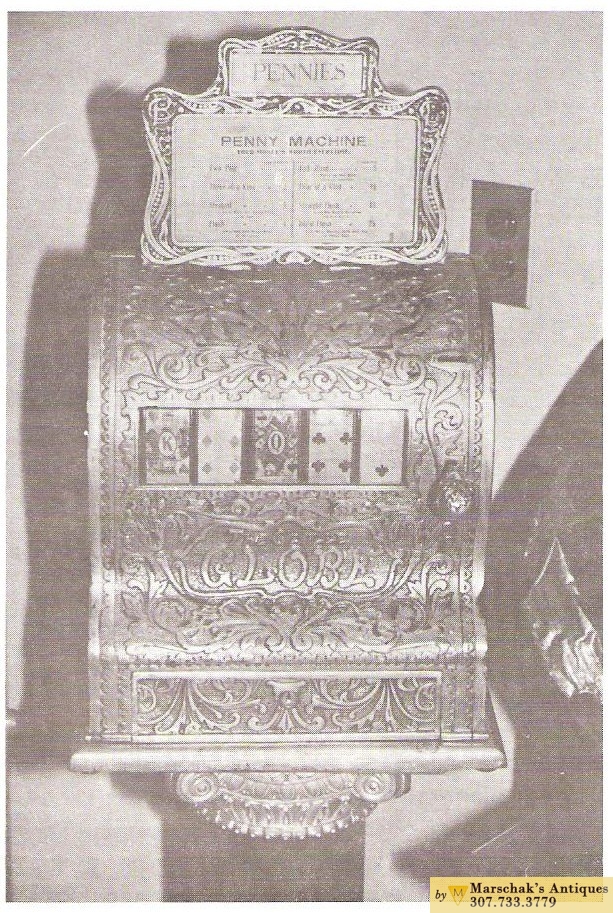
You’re looking at the last of the heavy cast iron card machines, and what a beautiful swansong it is to a departed class of chance mechanisms. The cabinet casting alone is a work of art, and machines like this should be in museums of contemporary and early twentieth century art. Curators haven’t yet caught on to the fact that the public arts are the true art forms of their times. Sure, buildings and monuments and post office murals are public arts, and many are preserved as such. But it is “everymans art” that is missing: the art and graphics of automobiles, advertising, radios, cameras, appliances, pinball games, vending and slot machines. They sold, or attracted play and use, because they looked as good or even better than the promise of their performance. Sure, there are private and even some public exhibits of automobiles, sewing machines, old store and other similar artifacts, but to this day there is no publicly funded open museum of vending machines, slot machines, pinball games or trade stimulators. If it wasn’t for the private collector all these treasures would be lost. The first museum staff that convinces its stodgy board that there’s something in coin machines will have the best chance of building a unique collection and will find themselves with an exhibit so exciting that it could draw visitors from all over the country. They might even be able to charge admission and make money at it. Logical homes for such an exhibit are San Francisco, the home of the three-wheeler; Chicago, long the “Coin Machine Capital of the World,” Detroit, where Caille was located; Cincinnati; the Victorian capital of coin machines; or even the nationally oriented Smithsonian Institution in Washington, D.C. But will they see these words, and would they consider them? If you feel strongly about this, send a copy of this page to your local museum.
The Caille Bros. GLOBE is a more than likely candidate as an exhibit machine because it is so typical of its genre. Cast iron, nickel-plated, heavy, with large card playing symbols, the Caille GLOBE was one of the last machines to be marqueed “Free Cigars.” It’s origins go far back into coin machine history, being based on a very early Card Machine made by the firm of Lewis & Strobell in Philadelphia in the early 1890’s.
Caille GOOD LUCK
Produced between 1902 and 1916
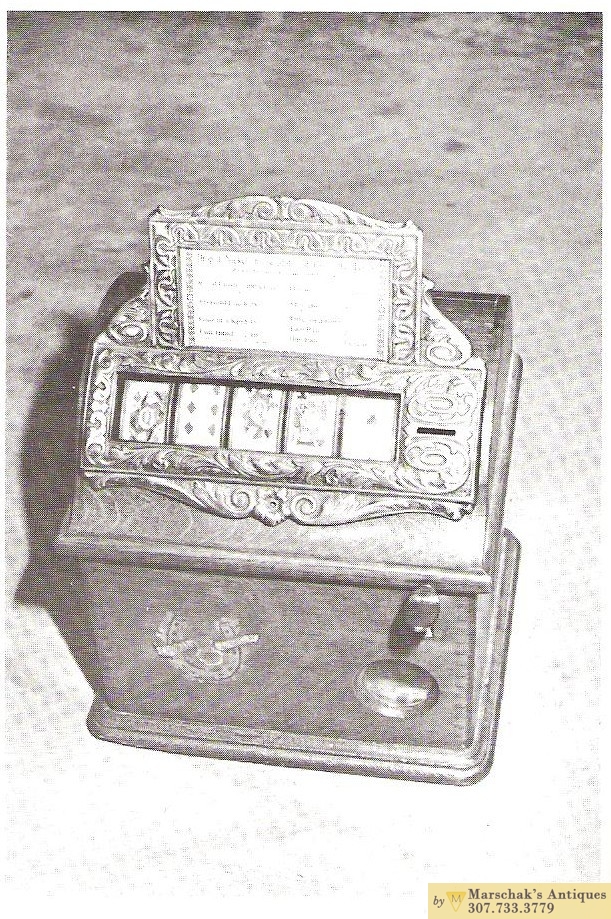
Old “Round Top” rides again, only under a different name this time. As vociferous as Mills, and fighting neck and neck with the Chicago producer to be the largest coin machine maker in the country, The Caille Bros. Company of Detroit also rapidly built their business and their line through acquisition and outright copying. When Canda sold off their chance and trade stimulator machines around 1901 in order to concentrate on arcade, picture and vending machines, Caille picked up some of the same machines Mills did, as well as some Mills didn’t. The Caille touch was typical; in order to make the machines uniquely their own, they changed the names whereas Mills retained the names of their pickups. When made and sold by Caille Bros. the Canda CARD MACHINE became the Caille QUINTETTE; and the PERFECTION CARD the GOOD LUCK. Caille Bros. also changed the cabinet trim, adding castings and decals to create flashier machines, and as a result the Caille models are distinctive.
Caille started unloading the Canda stock of the small counter card machine in 1902 as the PERFECTION, soon calling it the GOOD LUCK PERFECTION. By 1902, with Caille production, the familiar machine was being sold as GOOD LUCK with the adjustable coin slot for penny, nickel, dime or quarter play. Caine called it the “most popular card machine ever built.” which indeed it is when you consider all the models by various producers.
Caille Bros. made a whole line out of the basic machine, and examples of all of them can be found in the hands of collectors. GOOD LUCK came in a countertop model as well as a swivel base model in either poker or “Figaro” numbered reel strips, with the card machine model the most numerous. A much more elegant swivel base version with a simulated inlaid wood cabinet and added trim was put on the market around 1905 as the GOOD LUCK SPECIAL, also available with playing card or numbers reel strips.
Caille sold the various “Round Top” GOOD LUCK models until World War I, leaving the business to Mills after the war. But in the early thirties the name came back when Caille Bros. made a five-reel modern all-metal ball gum counter game vendor with poker symbols called GOOD LUCK. Strangely, the 1933 machine is far rarer than the older wooden GOOD LUCK Card Machines of the past.
Caille LION Floor Wheel
Produced between 1901 and 1906
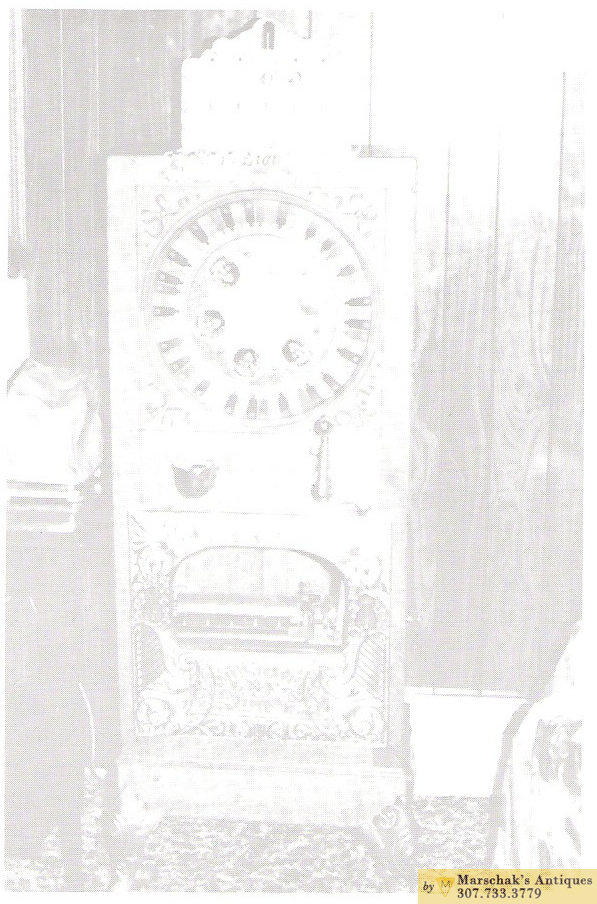
It’s fairly common historical knowledge among slot machine collectors, but a brief recap is in order. The Caille-Schiemer Company in Detroit, makers of floor machines, and The Caille Company in Detroit, also makers of floor machines, joined forces in July, 1901, to become The Caille Brothers Company when brother Adolph Caille of Caille-Schiemer and Art Caille of Caille Company decided to simplify things and be a big company and make a lot of money. They did both, and for the next twenty years or so they and the Mills Novelty Company in Chicago were the two largest makers of slot machines in the country.
Back in the early 1900’s and up until World War I, they were neck and neck, and based on the surviving floor machines around it’s hard to say who sold the most. The competition survives today, but in the antique field. Some slot enthusiasts are dedicated Caille (meaning Caille Bros. Co.) collectors, while others are Mills freaks, with everything else falling in between, or outside of, depending on how you look at it.
Whatever Mills did, Caille matched, and vicey-versy, so if there was a cheap, 5-way Mills floor machine (which there was in the JUDGE!) there was a Caille model to match. And the model was the LION. Sure, Caille-Schiemer and later Caille Bros. made a JUDGE selling new for less than a hundred dollars, the Caille’s reacted in kind with their LION.
The LION was originally made by Caille-Schiemer. so when the two firms got together the LION was one of the first machines made under the Caille Bros. Co. banner. Elsewhere in this book you’ll find the first full page ad run by The Caille Brothers Company, and if you look close enough you’ll find the LION in both the “plain” and “musical” models. Caille Bros. Co. called their machine the “King of all five way play getters.” In later years, at the end of the production run and after they had hyped the coin head to prevent cheating, Caille said: “While we do not recommend 5-slot machines we recommend the IMPROVED LION as being the best 5-slot produced. It is cheap in price only.”
So why should a “cheap” machine be so valuable? Because it’s so damn good looking and because it’s so rare, that’s why. The photographed machine is the original MUSICAL LION from 1901, including an eight tune Swiss music box. Music adds a lot of value to a floor machine, and when good looks go with it the price goes off the top. Just imagine what a TWIN LION would be worth if one could be found. Caille made ‘ern and sold ’em in 1905.
Caille MUSICAL PUCK Floor Machine
Produced between 1900 and 1916
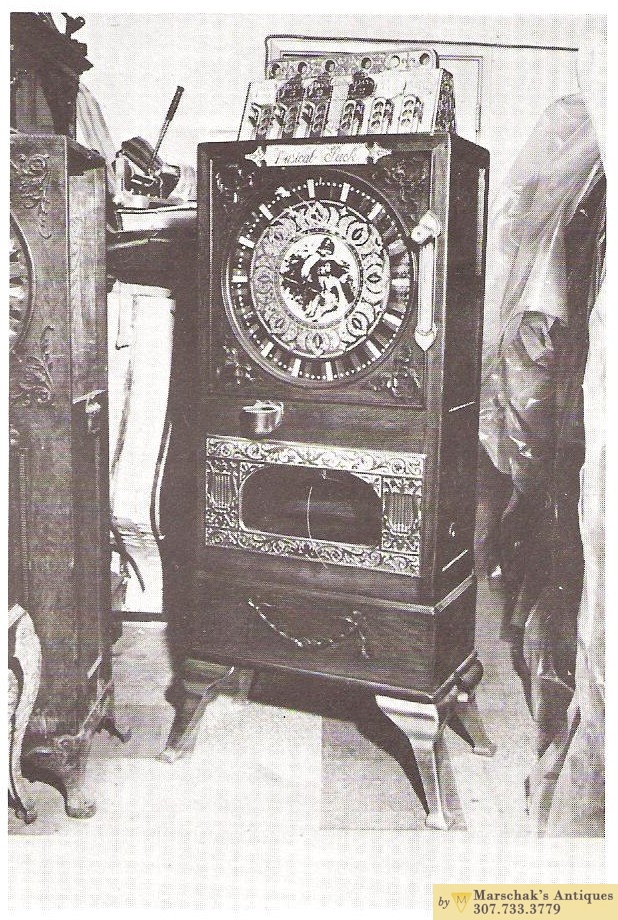
If you know your Shakespeare you know that Puck was the mischievous young hobgoblin that kept pulling pranks in the comedy A Midsummer Night’s Dream. He got everybody all screwed up. In a way the Caille PUCK with a big floor slot machine life second only to the Mills DEWEY did the same thing. When somebody says they’ve got a PUCK, or a MUSICAL PUCK, the more you know machines the more you wonder what they’ve got.
Caille-Schiemer came out with PUCK as the first 6-way machine, in a tall skinny cabinet with bathtub type cast iron legs, as we have seen. In August 1899, a Swiss music box was added below the wheel so that the machine could be run in closed towns. A “Musical Cabinet” nameplate was screwed on to the cabinet. The musical feature didn’t work too well, so at the end of the year, barely making its appearance in January, 1900, Caille-Schiemer replaced it with an improved model in which the music could by turned on and off, and called it the IMPROVED PUCK MUSICAL CABINET. While all this was going on Art Caille, younger than brother Adolph of the Caille-Schiemer Company by four years and much more promotion minded, formed his own The Caille Company in Detroit, and in 1900 was makin you guessed it the PUCK, in both “Plain” and “Musical” models in a somewhat different cabinet. By the next year, the two Caille brothers came to the conclusion that they were running off in too many directions, so they got together and formed The Caille Brothers Company in Detroit in July, 1901, with their first model guess which one? The PUCK and MUSICAL PUCK. The cabinet and castings were changed again. Jacob Schiemer and Robert Yates, both involved in The Caille-Schiemer Company, weren’t part of the deal, so they formed their own Schiemer-Yates Company in Detroit the same year, and started making their own PUCK machines. The only way to tell these models apart is to check the castings and any paper inside the machines. Caille-Schiemer machines have “C-S” castings; Caille Company has “The Caille Company” on its castings and paper; The Caille Brothers Company has “C-B” or “Caille Bros.” castings and paper; and Schiemer-Yates machines have “S-Y” castings. The long term survivor was Caille Brothers, making musical PUCK machines in a variety of cabinets, castings, and colors for many more years. If all that isn’t confusing enough, a dozen other producers copied the PUCK name. So if somebody asks you “What’s a PUCK?”, sit them down for a long conversation.
Caille NEW CENTURY PUCK Floor Machine
Produced between 1901 and 1917
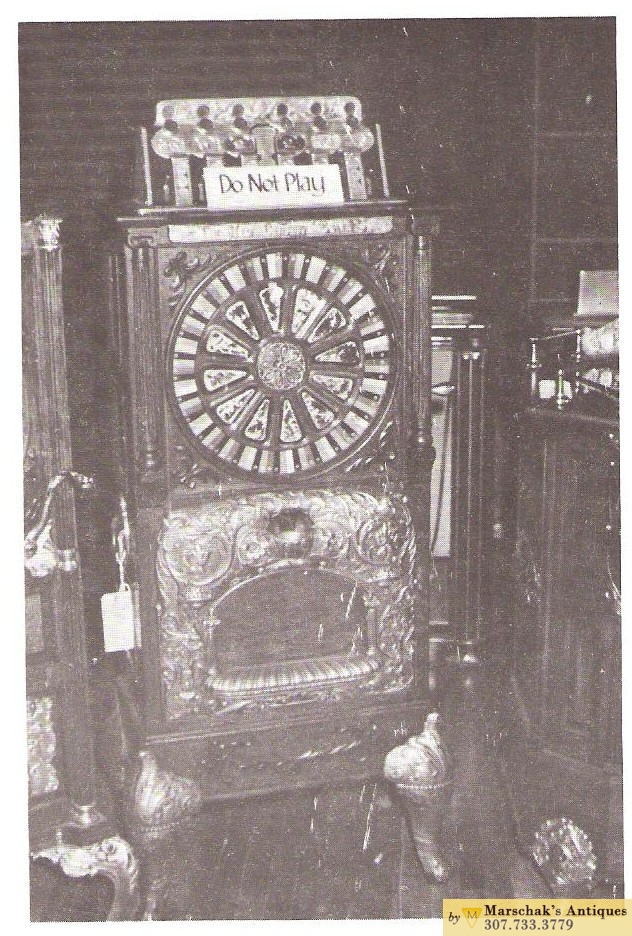
If you thought that we had run out of collectible PUCKS, you’ve got another think coming. Actually, the NEW CENTURY PUCK models and their successors, made by The Caille Brothers Company in Detroit, are the best known and most highly collectible machines in the PUCK series, and carried the PUCK name to the end of its production history. The name “New Century” meant the advent of the Twentieth Century and was in great vogue for virtual every thing the moment December 31st, 1899 turned into January 1st, 1900. For the next two or three years the expression got to be as over used and boring as the tag lines of our lifetime, such as “Space Age”, “Computer”, and other handles that have been stuck on product names. Caille Bros. completely reengineered and redesigned the 1898 PUCK mechanism, glass and cabinet to make the machine more competitive with the Mills DEWEY, sticking the play lever on the front. It was the beginning of the characteristic elaborately trimmed casting and cabinet look that would make Caille machines stand out for years to come. The new color-coded coin head and heavier legs makes the machine look bigger and stronger than the earlier models. The mechanism is also easier to work on, as the filigree parts of the earlier models are replaced with components that are heavier, simplified and fewer. The new machine carried a nameplate saying THE NEW CENTURY PUCK, with original iron castings in either nickel plate or antiqued copper. Nickel and quarter models were produced and later a half-dollar model.
One of the great features of the newer PUCK is that the more the machine is used, provided the parts aren’t worn out, the better they run. A musical model was produced as THE NEW CENTURY MUSICAL PUCK which has nine inch cylinder music box playing eight different short selections. In fact, the top PUCK collectible is this machine with its original music. As the years went by, the straight and music models became known as the CENTURY PUCK and the CENTURY MUSICAL PUCK, available in “plain” or the more elaborate cabinets. By 1906 or so the “New Century” name had been dropped and the machine once again went on to its destiny as PUCK, getting flashier in its old age with a bright green painted cabinet, and in some cases, ormolu castings. Many collectors, believing that richly rubbed natural grain wooden cabinets offset by the patina of antique nickel plated trim are the norm are sometimes shocked by the painted PUCKS. But that’s the way they were.
Caille OPERATOR BELL DELUXE Bell Machine
Produced between 1912 and 1916
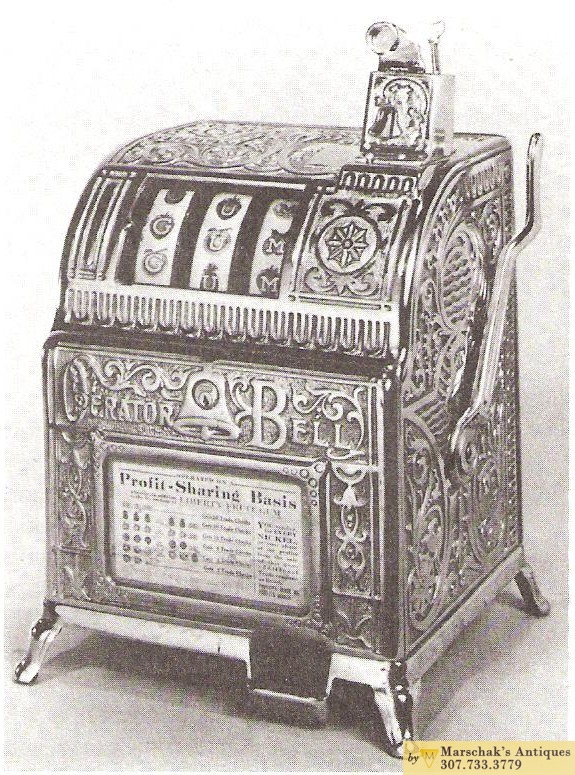
You’re looking at the king! Of all of the cast iron cabinet “Iron Case” Bell machines of the 1906-1916 period with the exception of the original Fey LIBERTY BELL, of course this is the one collectors want most. One look will tell you why. The machine you’re looking at hasn’t been restored; it’s just been cleaned. It’s Caille OPERATOR BELL serial 4,566 (the serial number is die stamped on the front at the bottom, just to the right of the payout cup) and only the second such machine to be found.
As late as July 1977 no Caille OPERATOR BELL machines were known. It was assumed to be a “lost” machine, although collectors knew that quite a number were made as a variety of cast iron models were catalogued and advertised between early 1911 and 1916. But where were they? Literally, the whole country was looking. In the middle of that hot climate of anticipation your author had all but given up on ever finding anything again. It was the steamy summer of 1977 and the date was Friday, August 19th. Worse, even if I found something I couldn’t do anything about it. I had thirty bucks in my pocket and a holiday weekend to get through. I had been at a client sales meeting in Menasha, Wisconsin and had to give the ad agency advertising presentation late Thursday night, then drive for ten hours all the way around Lake Michigan to join my family in Shelby, Michigan the next day. One of the client salesmen said: “Don’t drive. Take the boat over. They book reservations months ahead, but I’ll bet you get in on stand by”. So at 7:00 A.M. on Friday, I pushed the car half way across the state to Manitowoc, got to the boat by 10:00; was first on the waiting list and had an hour to kill before we sailed at 11:00. What to do for an hour? Actually, only 45 minutes as I’d need 15 minutes to get my car on the ferry and buy a ticket. So zip into town to check antique shops. There were three; only one was open. Nothing. By 10:15 the second one opened. Interesting stuff, but nothing. So I drove back to the boat at 10:35, and passed shop No. 3. Open. Nothing. I asked the lady if she had any “vending machines or coin machines”. No answer. I started out the door at 10:45. Late. Half way out she said, “We had one, but we sold it”. I asked; “When?” She said, “Next week”. Next week? I said, “Do you still have it?” She said, “Yes, but it’s too late. We have an offer on it”. I said, “Can I see it”, expecting a Mills “Hightop”. She said “Sure”, and took me into the basement. In a far corner, under a throw rug, was a lump. Sticking out of the corner was a nickel plated cast iron foot. My heart stopped. It was 10:49. I was sure it was a Mills “Iron Case”.
She pulled off the rug. Caine! Keys and all. She asked, ” What do you think of it?” I slowly, unemotionally said, “That’s nice”. She asked, “Well, will you make an offer?” I didn’t answer. She said “Make me an offer!” I asked, “What’s been offered so far?” She said, “Oh no, I won’t play that game and get chiseled. Make me an offer!” My heart stopped again. Thirty bucks in my pocket. 10:52! So I said, “Okay. Eight hundred”. She said, “It’s yours”. So I shook her hand, promised to be back with money in three days, raced to the boat, got on as the last call whistle blew and sat for six hours going nuts as we plowed across the lake. On Tuesday, August 23rd I was back with the money. She was a lady of her word, and the first and oldest Caille OPERATOR BELL yet found was in my station wagon. The serial is 3,210 and the castings are marked “Caille BDL” for “Caille BELL DELUXE”. Since then at least three more have been found.
Caille PEERLESS Floor Roulette
Produced between 1907 and 1922
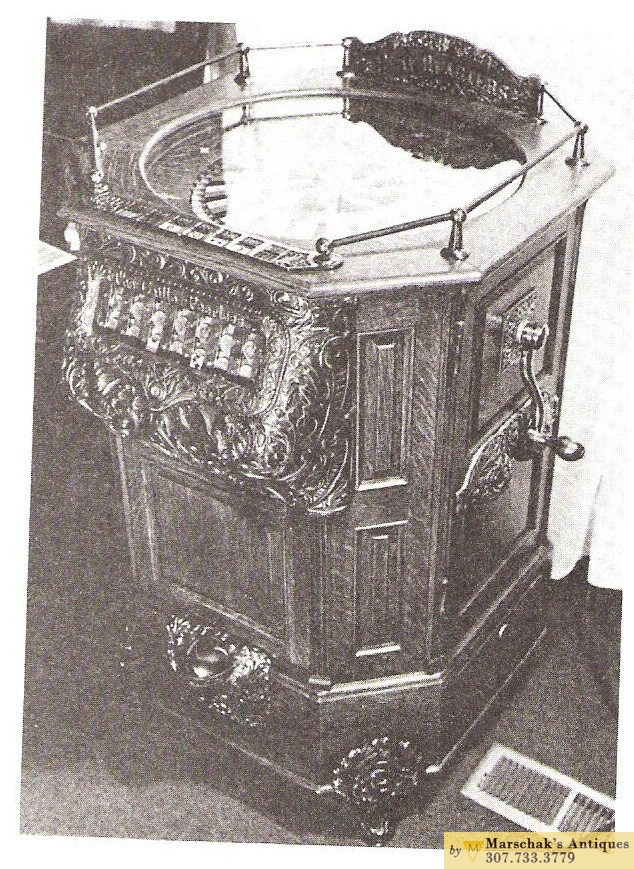
PEERLESS is its name. Peerless is its fame. And fortune, because that is what it’ll take to own one of these machines. As it stands today, this is the top of the line in slot machine collecting. There are rarer machines a lot of one-of-a-kinds. There are even more valuable machines whatever the Caille PEERLESS is worth an original Fey LIBERTY BELL would go for at least 20% more these days. But if you’re a “Major Collector” (that’s usually anyone that owns any form of early 1900’s automatic payout roulette floor machine) this’ll be the machine you brag about.
It was never any different. Even back in 1978, when the first volume of this series of price guides was printed, the Caille ROULETTE and Fey LIBERTY BELL were neck-and-neck in value (see pages 30 and 33 of Volume 1). Volume 1 featured the Caille ROULETTE, an 80-pocket 7-way automatic payout roulette floor machine first made in 1904. This time around we’re featuring the Caille PEERLESS, a T-way 60-pocket machine of 1907 that has major mechanical improvements over the earlier model. Both machines are of currently equal value rank, but the PEERLESS is a bit more fool proof in its play.
As originally delivered, both of these machines had an elaborated trimmed, silvered and gilded glass with the Caille Bros. and machine name on it. But you can just imagine how long that lasted as a flat glass top that people leaned on to watch the play. El Cracko! Even the short nickel plated fencing around the covered wheel designed to protect the glass from abuse didn’t solve the problem. In a way it created one. The old saloon players yearned to set their steins on the top of the machine but couldn’t because of the rails. So players and observers balanced their brews in their hands, and often dropped bottle, beaker, whiskey glass or schooner smack dab in the middle. As a result, most of the surviving machines are already on their third or fourth glasses, by now crystal clear sans graphics. A few of the original have survived the years and will probably be reproduced in quantity to bring all the other old machines up to snuff, but to date the generally missing glass graphics don’t seem to have hurt the values a great deal.
The way the PEERLESS works is astounding. Little fingers below each pocket await the reception of the free spinning ball. If the ball falls into a pocket for which the color has been played there are seven possibilities: Black pays 2, Red 2, Yellow Crescent 4, Single Star 10, Double Star 14, “0” pays 20, and “00” pays a whopping 40 the payout is automatic, from 10(C to $2.00 on the nickel machine and 50(C to $10.00 on the quarter machine. Caille called the PEERLESS “The only large successful roulette made” adding that “This machine represents years of careful study and work”. It shows it.
Caille also made a CHECK PEERLESS model that had an extra payout cup and dispenser for trade checks. Only two of them are known. Caille listed the standard PEERLESS in its 1915 Catalogue 311 as a”Discarded Machine”, selling them off at low prices. That doesn’t seem to have worked, because they were back in a Caille catalogue and direct mail flyer in 1921. Seems they had a hard time unloading them. They wouldn’t today.
Caille PUCK Floor Machine
Produced between 1898 and 1901
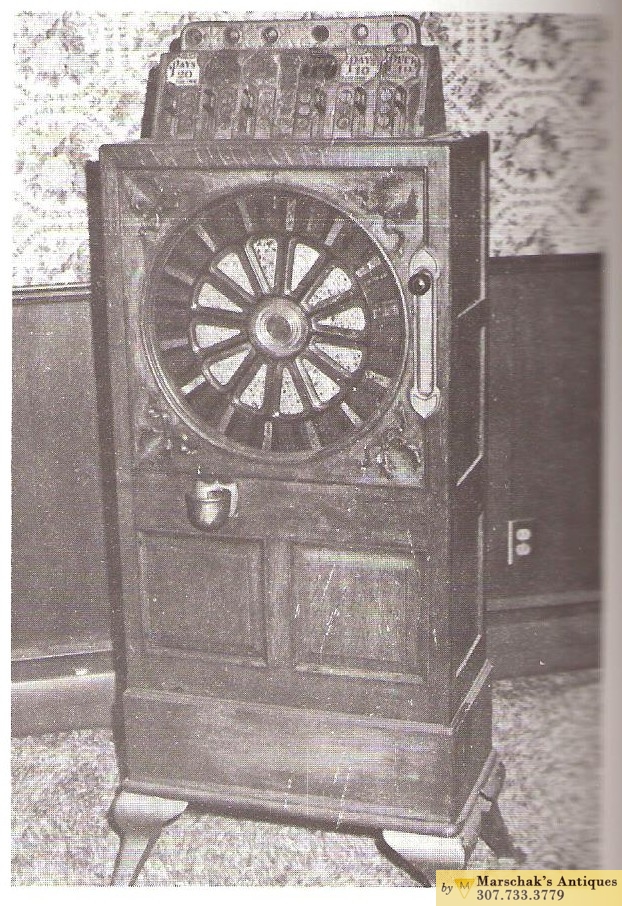
In the slot machine business it was always impossible to keep a good idea to yourself. It wasn’t long after the Mills OWL began to run away with most of the sales in the industry that a company half a mile away began to crank out a similar machine with a 6-way coin head. The first PUCK was made by The Illinois Machine Company at 147 Fifth Avenue, (now it’s called Wabash Avenue) in Chicago early in 1898. Adolph Caille and Jacob Schiemer from Saginaw, Mi., already in the store and saloon fixtures business, formed the Caille-Schiemer Company in Detroit to make the machine and take over a big piece of the booming gambling machine business.
Where the OWL had a crank on front, the PUCK had a heavy push down wooden arm. Instead of a 5-way coin head, with a top payout of a dollar, the PUCK could take up to six coins with double the top payout. The result was instant success, and led to the same form of flattery Mills’ experienced; everybody else started making PUCKS.
It was on July 15, 1898 that Caille-Schiemer started using the name PUCK on their machines, even getting a registered trademark for the name and logo style. If you want to frame one on the wall behind your machine look up trademark 32,567 issued on March 7, 1899. The machine name was taken from a popular humor magazine called PUCK WEEKLY to pick up on an already wellknown name, and to suggest that the machine was fun to play.
It’s fairly easy to tell the early PUCK machines apart. The Illinois Machine Company model has the lettering “IMCO” on its front casting while the Caille-Schiemer version has “C-S” all over it, inside and out. There are quite a number of surviving early PUCKS around, with the Caille-Schiemer model outnumbering the Illinois Machine Company version by about four-to-one. They face the same problems the OWLS do; the coin heads are often cracked or missing. If the head is cracked, the problem can be solved, but it takes a careful welding job. Missing heads are a bigger problem as there’s not enough to go around. Some times a correct head will cost almost half as much as a machine, but if you want a complete machine it’s worth the money, otherwise you’re stuck with an “Incomplete”. Someday, someone will make a good business out of recast and properly machined reproduction coin heads. As of now, it hasn’t been done, at least not in volume.
The PUCK is the oldest form of six slot floor machine made. It was also the first popular floor machine to sport a music box in its PUCK MUSICAL CABINET model of 1899.
Caille SILVER CUP Counter Machine
Produced between 1912 and 1917
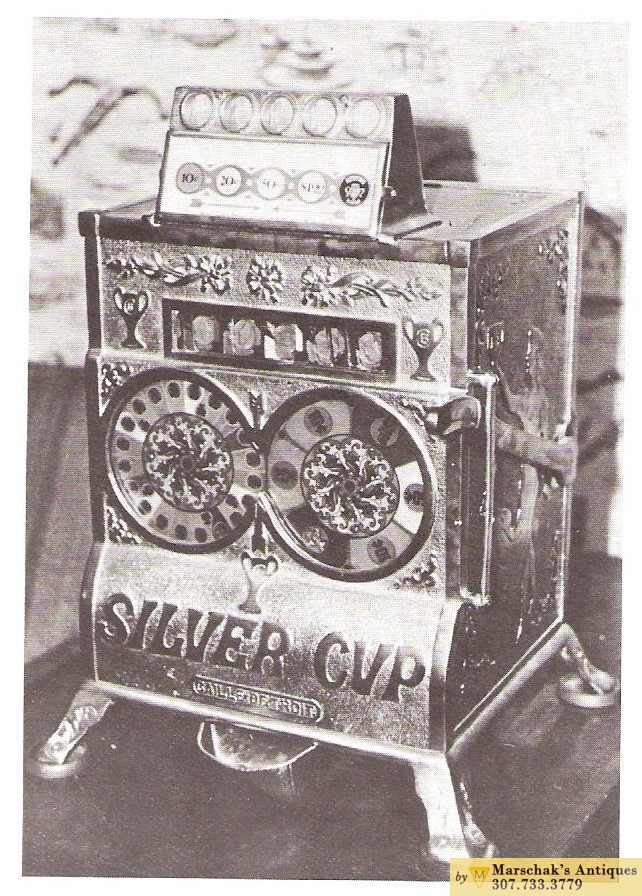
Perhaps the greatest asset the gambling machine industry of the early 1900’s had going for it was the imagination of Charlie Fey. Sitting at the workbench in his San Francisco shop with new, old, unfinished and recently modified slots of all kinds and surrounded by a small army of young boy apprentices to run the routes, do the hard metal filing, and generally learn the coin machine business from the ground up, Fey batted out machine after machine, with just about every idea brand new.
Fey created the 5-way cast iron SILVER CUP around 1910 or so, as an advance development of an earlier machine he made called THE DUO, and ran it on his routes in nickel and quarter play. Boldly displayed in its cast iron case was the name “Chas. Fey & Company”. Two or three of the machines are known, with one of them unearthed as late as 1977.
Fey must have made some sort of deal with Caille by that time Charlie Fey and Adolph Caille were old buddies—because Caille Bros. came out with the same cast iron machine around 1912, with the only visible change in the front casting nameplate. Now it said “Caille-Detroit”. No one else made anything like it. Caille also made a side vender model called SILVER CUP VENDER. Until the early nineteen-seventies only two or three of the Caille models were known to exist. But in a blaze of discovery another four or five suddenly came out of the woodwork in as many years, and they keep showing up. No venders yet, but who knows what’s out there? Caille also made a similar machine called LOVING CUP, including a vender model. Not to be outclassed, Mills jumped on to the double-dial idea by converting its BROWNIE into a two disc machine, splitting the power drive of the wooden boxed DOUBLE DIAL BROWNIE mechanism to spin two smaller color wheels. The idea apparently didn’t take hold, and only one of the machines survives. So far, that is! By 1915 Mills had given up on this direction and was selling the machine as the SILVER CUP. Not to be outdone, Mills also converted its CHECK BOY cabinet into a SILVER COP, sticking two color wheels on top of the already massive cast iron cabinet. None are known.
Caille SILVER CUPS retained a long. period of active use. There was an active market for used and rebuilt machines for operators in the early 1930’s, and SILVER CUPS may well have run on location until World War II. Why not it’s a great looking little machine, and a lot of fun to play.
Caille TOURIST Counter Single Reel
Produced between 1912 and 1916
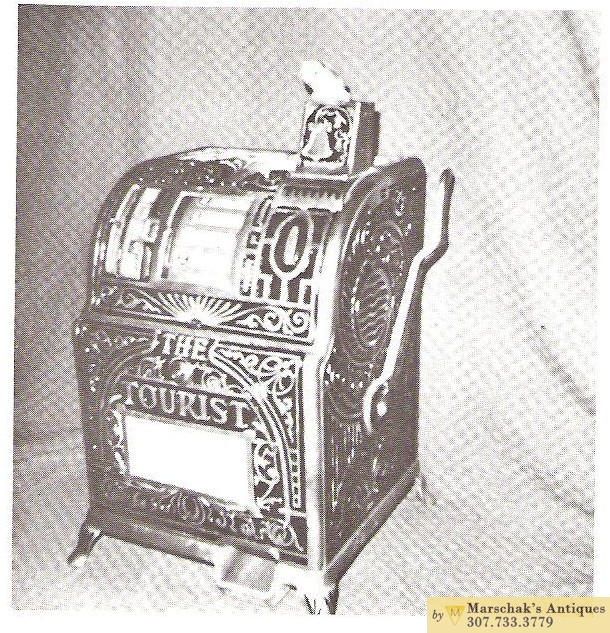
Does it seem logical that a single reel counter machine made after 1912 can be worth a lot more than a substantial number of the older color wheel floor machines? It certainly is to the collectors that favor the Caille TOURIST, and one look at the machine will go a long way to telling you why this is so. The problem is, it’s difficult to see.one as they never seem to make it to the open market. This is a machine that is traded and rarely sold. Apparently only two or three of them are known to exist. There might be more, because it is the kind of machine that “secret” collectors like to hide.
In appearance the Caille TOURIST is splendiferous. It’s cabinet is an exact match to the Caille OPERATOR BELL of 1913, the only difference being that the TOURIST is a single reel machine while its counterpart has three reels. Both of the machines are heavily nickel plated, and literally glow in the dark once they are cleaned up and polished. The heads, sides, backs and feet are practically duplicates, and side by side the two machines look like twins. But there the similarity ends, for the TOURIST is completely different from a Bell in concept. It works practically the same way as the Eagle SQUARE DEAL GUM VENDER. The single reel has 31 spaces, divvied up into five countries: United States, Germany, Ireland, England and France. Some countries have more reel stops than others, permitting a variety of payouts of from 2 to 20 coins. The player sets the lever at the color for the country he wants to play for when the coin is dropped. Pushing down the coin plunger at the top and pulling the handle locks the selection and the reel spins. Hit a winner and the coins spit out just like a regular three-wheeler. It’s a terrific show.
It’s interesting to know that the Caille TOURIST was a collectible before any example of the Caille OPERATOR BELL had been found. Looking at old catalog sheets didn’t reveal the fact that the two machines were so much alike; it took the discovery of an OPERATOR BELL to make the point. Hopefully more TOURISTS can be found. Caille also made it with city symbols in place of countries, with the selections including Detroit (where Caille was, of course), Boston, Toronto, Chicago and Denver. Both versions were also made with side venders. But the real treasure, if it can ever be found, is the cabinet vender model. It had a music box in the cabinet.
Callie MIXED TRIPLET Floor Machine
Produced between 1903 and 1916
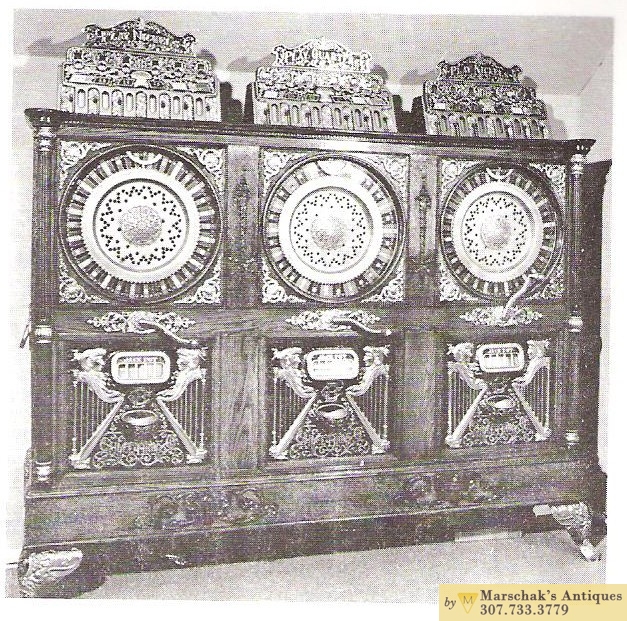
Speaking of “Triplets!’, there is a group of machines that are available in some numbers, although their trading prices belie their existing population. The whole idea of a double or triple floor machine was to get around the growing tax laws and slot machine licensing fees. With a double or triple you could get two or three machines licensed for the price of one. When music was added, the customer always got something for their money, win or lose.
There are more Caille triplets around than any other kind, suggesting that Caille Brothers made most of them, probably because they did a good selling job in putting them over. A few Watling and Victor triples also survive, but the big trading is on the Cailles’. In the early seventies only five Caille triplets were known to exist. Since that time, more have been found at the rate of about one every two years. Most of the surviving examples are Caille MIXED TRIPLET machines, both plain and musical, in which a variety of Caille floor machines of the same basic size are joined together. A typical mix consists of Caille CENTAUR, ECLIPSE, and LONE STAR machines in 5 cent and 25 cent play, with nickel play models at each end, although these were generally later models made after 1907. Earlier triplets mixed PUCKS in 5 cent, 25 cent and 50 cent play models, while later triplets included the CENTAUR TRIPLET, ECLIPSE TRIPLET and a variety of MIXED TRIPLETS.
The Caille triplets are nowhere near as large and heavy as their Mills and Watling counterparts. A Caille MIXED TRIPLET weighs in at around 600 pounds and is sixty-two inches wide. According to the Mills catalogue sheets the DEWEY TRIPLET was eighty-five inches wide and nine inches taller than it’s Caille Bros. competition. That may be another reason why the Caille models were more popular. A typical re-action to advance notice of a police raid on resorts or saloons with gambling in the early 1900’s was to turn the face of the floor machines to the wall. Moving 600 pounds was probably tough enough; but 900 pounds, that’s all but impossible. The sheer bulk of the triplet machines suggests you won’t find them in attics or basements. They probably never left the ground floor, and that’s just where most of them have been found.
CailleTWIN Floor Wheel
Produced between 1911 and 1915
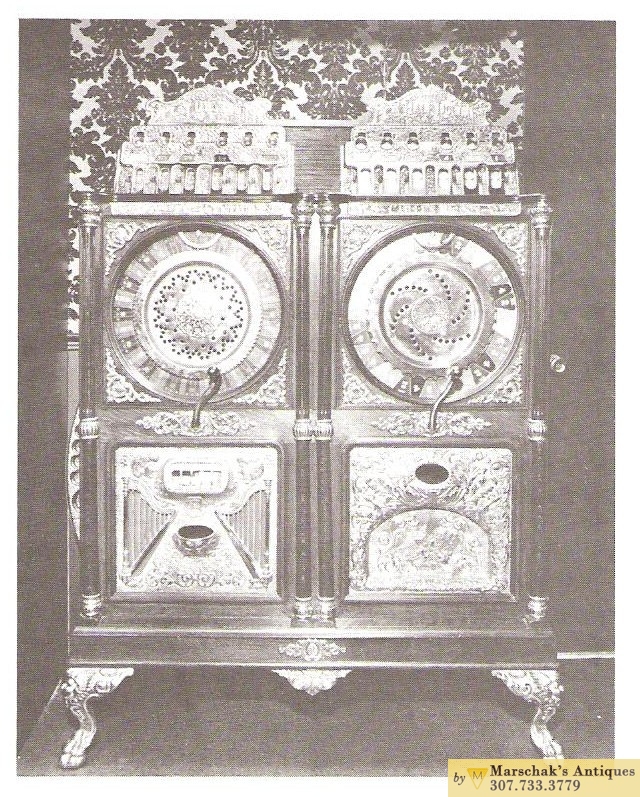
A number of Caille “doubles” were covered in Volume 3 of this series of books, with the TWIN DETROIT of 1903-1916, TWIN ECLIPSE of 1904-1916 and TWIN CENTAUR of 1907-1916 getting the treatment in its pages, all highly rated for their elegance. But here comes the capper, the Caille Bros. TWIN of 1911-1915. What makes the TWIN different is the fact that it is made up of two different machines.
Caille “doubles” are rated as the prime double machine collectibles. It’s their flash and detail that makes this so. Never let it be said that Caille couldn’t take the same class of machine made by half-a-dozen other makers and gussie it up so completely that its owners and players thought they were working something completely different than the competition offered. The casting details are so excessive and the appointments so lush that the Caille floor machines almost looked bathed in light even when they were hiding in the dark corner of some old pre-prohibition saloon. There was always enough flickering light to make a Caille visible. This was doubled when two machines were put together as one. The result was even greater flash covered by one tax stamp.
Caille’s standard “double” was two models of the same machine with different coinage, usually stepping a nickel up to a quarter for modest players and heavy hitters alike. Playing two bits on a single spin of the wheel back in 1912 must have been scary because it was a lot of money then. But the step up from nickel play to quarter play was easy and comfortable as both machines in the same cabinet were generally alike. It was just a matter of moving a little bit to the right, taking the bigger coin out of your pocket and going for it.
But not the Caille TWIN. It wasn’t two of a kind at all; it was two diverse machines of the same frame size, and often of higher denominations. Generally, the base machine was Caille CENTAUR or ECLIPSE at the left and a more unique machine at the right so players could move from the conventional and comfortable to a higher risk or more complicated machine. The models were seemingly endless, with CENTAUR-ECLIPSE TWIN, CENTAUR-BIG SIX TWIN, CENTAUR-LONE STAR TWIN, ECLIPSE-BIG SIX TWIN and even LONE STAR-FORTY FIVE TWIN and BIG SIX-LONE STAR TWIN models known. Caille Bros. sometimes catalogued these machines as MIXED TWINS and even had “THE CAILLE TWINS” glass on some. They were all offered in both plain and musical models, the latter having only one music box, left or right, to avoid conflicting tunes.
The machine shown here is a Caille Bros. CENTAUR-BIG SIX TWIN in ” Quarters” (CENTAUR) and ” Half Dollars” (BIG SIX) play, making it a big money machine
indeed. At the time this photograph was taken around 1968 by the late Dan Adams the machine was owned by Roy Arrington, subsequently to be auctioned. The detail and condition is marvelous. The jackpot model CENTAUR is covered on Page 37 of Volume 1, although the jackpot, front castings and coin head on this CENTAUR differ considerably from that earlier version. The BIG SIX is covered in detail on Page 70 of Volume 2, with cabinet, castings and coin head identical in both models.
There is another interesting point about this machine. The CENTAUR at the left uses the elaborate MUSICAL CENTAUR front castings, yet no music box had been fitted. A similar 25(/50 machine in the Jonas Silber-stein collection, it may even be the same one carries the serial 120/2-3-45. The Caille Bros. Catalogue 509 of 1909, describing the CENTAUR-LONE STAR TWIN, provides an insight into the location popularity of the Caille TWIN machines when it says; “The leading operators admit that ‘Twins’ will take in more than three single machines and we have seen this demonstrated time and time again. Operators must have them.” Time has proven the point in an altered manner, for today a Caille TWIN is still worth more than three single machines.
Caille TWIN CENTAUR Floor Wheel
Produced between 1907 and 1916
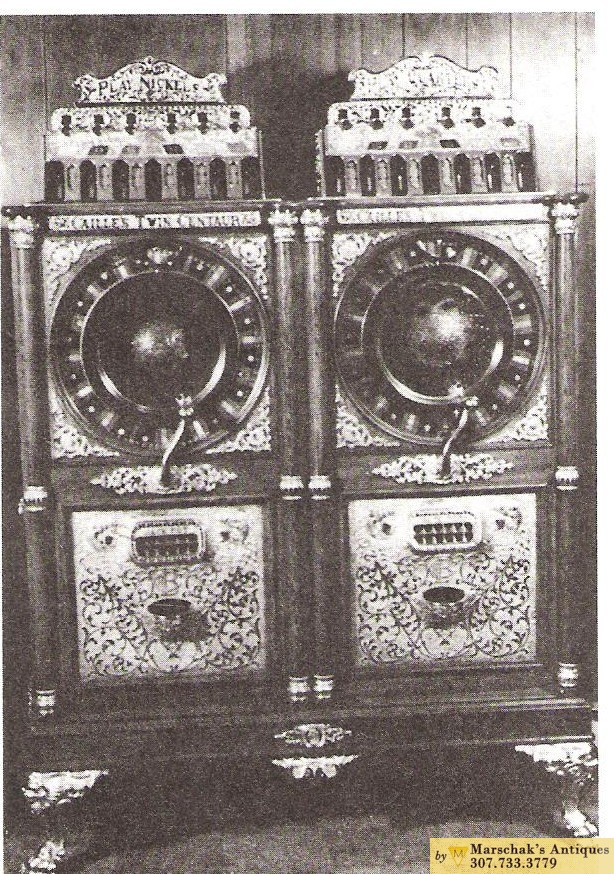
Double your pleasure. Double your fun. And more than double your value. Here’s a super hot collectible that until now has never been touted in print. In fact, floor machine “Doubles” have been sadly ignored with none appearing in either of the first two volumes of the “An Illustrated Price Guide to the 100 Most Collectible Slot Machines” series. But we’re making up for that in one big rush in this volume with four doubles in one presentation. And there’s more coming up in later volumes, so we can meter them out in print now that we’re caught up.
The Caille TWIN CENTAUR is…gorgeous! The only thing that tops it out is the Caille MIXED TRIPLET described on page 27 of Volume 1 in this series. Actually, that’s a misnomer, for the machine illustrated in Volume 1 is really the Caille CENTAUR TRIPLET, with all three machines in the cabinet sporting CENTAUR jackpots. So here it is in a double as the TWIN CENTAUR, and showing off something you rarely see on a Caille TWIN. Look at the cast iron and nickel plated nameplates above the wheels on the cabinet. They both say “Caille’s TWIN CENTAUR”, a point of detail missed on many of these machines and one that hypes the value of the examples that carry it. All the things that make Caille collectors drool over their machines are here, only doubled. The elaborate coin head, fantastic wheels, and unmatched front plates. There’s quite a bit of variety in these machines as they were made long enough to mix and match and modify their parts and trim.
The dating of the Caille TWIN CENTAUR is fairly precise, something that can’t be said for a lot of floor machines. The intelligence comes out of the 1909 The Caille Bros. Co. Catalogue No. 509 which does a good job of describing the machine, to wit: “This fine machine has been on the market only about a year and has met with a very large sale. The jackpot feature is an attraction that is sure to take and persons who ordinarily do not play will be induced to try their luck. The pots fill automatically after a winning is made. An automatic percentage device, similar to that of the ECLIPSE, is embodied in the CENTAUR and has proved a great feature because of the Jack Pots. Cabinets can be had in quartered oak or mahogany finish. We furnish the ornamental parts in nickel plate, Roman Gold (Note: To date collectors don’t know what that color is as it doesn’t seem that any of the so called Roman Gold plated machines have survived the years) or Antique ( Second note: this is assumed to be antiqued copper).
Poking around old catalogues tells us other interesting things. A 1915 Caille price list No. 311 quotes the TWIN CENTAUR at $375 for 54/250 play and $405 for 250/500 play. But the interesting item was the “Discarded Machines” list that says that “Twin machines equipped with music box” would no longer be available, thereby precisely dating the time when the major makers discarded music for floor machines. Incidentally, the values below are for the MUSICAL TWIN CENTAUR Without music, subtract $3,000 across the board.
Caille TWIN DETROIT Floor Wheel
Produced between 1903 and 1916
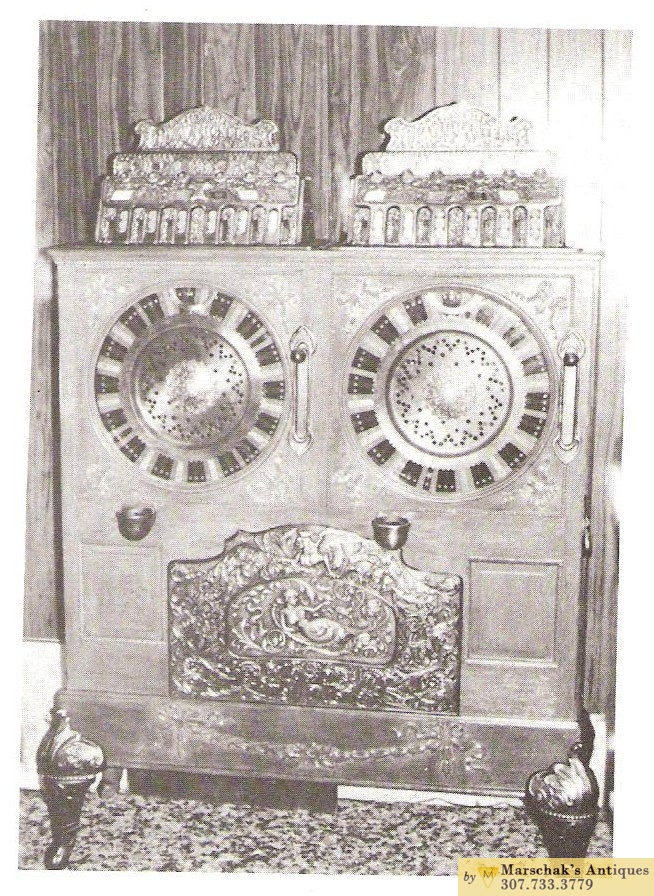
As long as we’re on the subject of twins machines (most collectors call them “doubles”) lets keep the wheels spinning with that idea for awhile. These are machines that hardly anybody sees unless you’re a “friend of the collector” or something. They don’t move around the country much because they’re just too big to move a lot. Finally, their written history and pictorial record is scant because most of them seem to be in the hands of “secret collectors”. You’ve got to remember that just a little over four years before this writing it was illegal to own an antique slot machine in every state of the union except Nevada. The fact that thirty states have legalized antique slot machine ownership since then (the exciting story of this collector movement is carried in detail in volume 2) hasn’t affected the doubles much. Their owners, for the most part, got them when they were illegal and have just kept them ever since. Therefore, if you’re a slot machine historical nut you can’t just go out and look for the doubles; they’ve got to find you!
That singular fact of life put your author on “doubles duty”. Everybody was asked “Who’s got a double?” and once that was determined a trip to see the actual machine was made, or the owner was asked to send a photograph. And oh how the doubles rolled in. There’s a lot more doubles out there than you’d guess, and the variety is as surprising as hell. We won’t plop them all in this volume but we will throw in enough to give you an idea of the variety of this genre.
The Caille TWIN DETROIT is just about the oldest form of double we’ve run across. The DETROIT is an exposed-stop variety of the Caille PUCK named after the home city of Caille Bros. Co. products (just as the Mills CHICAGO is an exposed-stop version of the DEWEY and named after its home city). At least two examples are known. This model in the hands of an anonymous collector and has an enormous casting over a covered area that could be used for a music box. A second MUSICAL TWIN DETROIT model was sold at auction at Harrah’s in June, 1975.
Caille made the machines in 5(C/250 play, as this PRICE GUIDE example is, and in 25(C/50(P play. None of the higher denomination machines are known.
Caille TWIN ECLIPSE Floor Wheel
Produced between 1904 and 1916
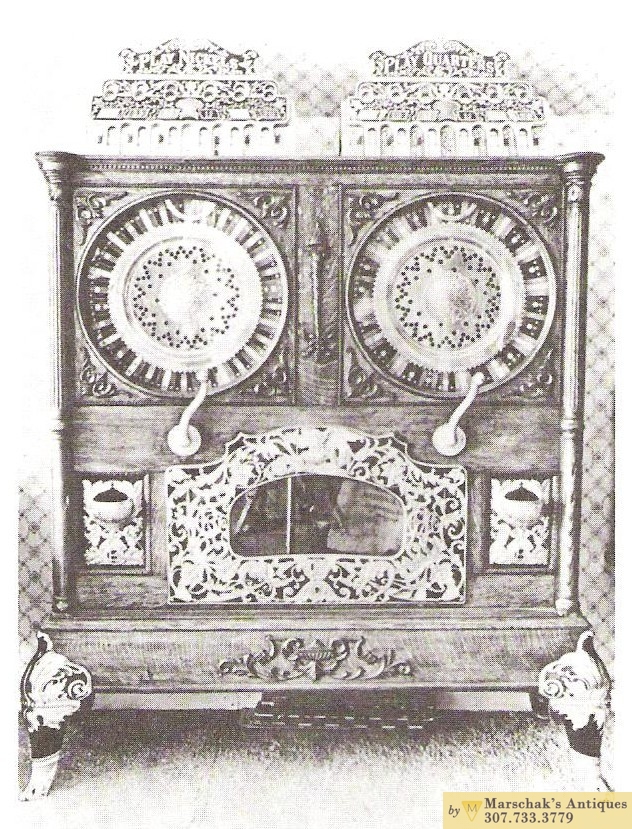
The Caille floor machines are probably the ones most collectors across the board want the most. It’s the trim, castings, colors and carvings that make them the things of beauty that they are. They don’t look as utilitarian as Mills machines do, as weird as the Watlings, or as potently plain as most of the off-brand models. The Cailles have a distinctive sit and vista. In short, they’re smashing.
That claim to fame goes double for doubles, and redoubles for music. So you’re looking at a super prime machine. And its always been that way. Caille TWIN ECLIPSE machines were collectibles long before slot machine collecting was a fad. In fact, the man that had the first slot machine collection, if you can believe those in the know and old coin machine industry hands, had a TWIN ECLIPSE. His name was Alden Scott Boyer and he had a small cosmetic chemicals company on the near south of Chicago in the 1930’s and 1940’s. In a write up on the Boyer collection (you’ll learn a lot more about Boyer and his collection in volume 5 of this series) in the March 1940 issue of AUTOMATIC AGE, one of the two major trade publications of the coin machine industry when slot machines were in their prime, the TWIN ECLIPSE was mentioned. In an article entitled “Another Group of Boyer’s Old Timers” they said “Of particular interest is the Caille twin console. Mr. Boyer….was so impressed with the beautiful woods used in the cabinet of this machine that he cheerfully spent about one hundred dollars to enhance the original appearance by having the cabinet rubbed and polished and having all external metal parts replated in gleaming, lustrous bronze”. Imagine that! A restoration for a hundred bucks! Everything was a lot cheaper then.
This characteristically precollection boom naive approach to TWIN ECLIPSE values hung around a lot longer than you might suspect. As late as 1971 antique columnist Joel Slater, in his copyrighted column “Antiquing With Joel Slater”, wrote; “Caille Double, originally with music, 1906 (is) valued at over $2,500 and can be seen as part of the decor at The Handlebars Saloon, Pasadena, California”. By 1975, at the Harrah’s auction, a TWIN ECLIPSE went for $5,600, and by the time of Roy Arrington’s 5th Annual Victorian Casino Antiques auction in Las Vegas in February, 1978, one went for $37,500. From $2,500 to $37,500 in seven years? What other form of investment has appreciated that fast? The values are somewhat stabilized since then, and the prices for a musical model at current values are shown. For a “standard” model, sans music, subtract 10%.
Caille VENUS Floor Wheel
Produced between 1907 and 1910
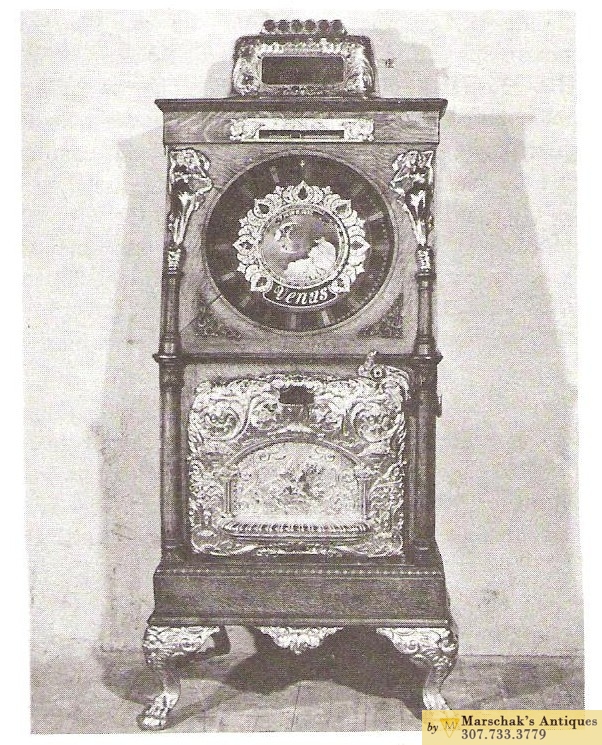
Here it is, the top of the slant front line, and the quintessence of Caille collecting to many “Advanced Collectors” (If you ever wondered what that meant when you saw it in ads or auction lists, it means people with a lot of money that are willing to drop a big chunk of it on a single piece) across the country. Part of the super turn on of the VENUS is the over abundant plated trim, particularly the lightly draped ladies above the columns on the front.
VENUS is a VICTOR, plus. The glass is almost the same, only now the Caille name has been clearly added, as well as the VENUS name on both the glass and nameplate. Both VENUS and MUSICAL VENUS models were made, with the “Plain” VENUS shown with pricing for the musical model. Current values are the same for both VICTOR and VENUS, yet the VENUS is the preferred model. You can get approximate current values for both without music by subtracting $3,000 from each listed price range.
Alden Scott Boyer of Chicago, the first true slot machine collector (Long dead! Machines dispersed!) had a VENUS back in 1940. He said, in the February 1940 issue of AUTOMATIC AGE, that the “VENUS 6-way color wheel machine (was) manufactured by Caille Brothers in 1897”. That started the dating screw up. It wasn’t straightened out until Catalogue No. 509 of the Caille Bros. Co., dated 1909, was discovered. In it, at last, was the VENUS, with some interesting comments about the machine. Caille calls it “A six Slot.The only single nickel or quarter machine. Adjustable for either nickels or quarters”. That’s a pretty unique comment, so the catalogue goes on to explain: “The VENUS is a decided departure in slot machine construction. Besides being the original bevel cabinet (Note: Aha! They weren’t called slant fronts. They were “bevel fronts”), it is the only machine that can be changed in a few minutes into a 25-cent play or vice versa (i.e. back to nickel play). But another reason why we designed the VENUS (Note: Pure puffery. They didn’t design it; Schiemer-Yates did!) was to have a machine with a cut out that throws out one coin at a time. In all the preceding machines in this catalogue (i.e. the Caille-designed machines.) the coins are cut out in lump sums. This is approved by our patrons, but the VENUS principle serves to satisfy those who prefer the single payout method. The coin detector of this machine is also different from any other. It has a shutter which closes the coin chutes when the front is unlocked. No chance to rob it. Nickel and quarter play (Note: Only one basic model for both coins. Neat.) $135.00″.
So that’s what makes the Schiemer-Yates and Caille machines so different! The convertible playing coin feature, the one-at-a-time payout mechanism and the anti-stealing lock and shutter. Then your author had a hunch. If Caille Bros. made both the VICTOR and VENUS were they advanced developments of the GIBSON GIRL, or were they picked up from Schiemer-Yates whole cloth? So I had a number of VENUS owners take a close look at their machines to check their castings. Some were standard “CB” with the Caille Bros. Co. name all over them. But two VENUS machines, one in the John Herman collection in California, and a second found in Louisville, Kentucky by Pete Hansen of Illinois have “S-Y” castings. Schiemer-Yates! So we have three possibilities: one, Schiemer-Yates made the VENUS first; two, Caille Bros. sold VENUS machines originally made by Schiemer-Yates; or three, Caille Bros. used up old “S-Y” castings on their VENUS production. More likely it’s all of the above.
Caille VICTOR Floor Wheel
Produced between 1907 and 1910
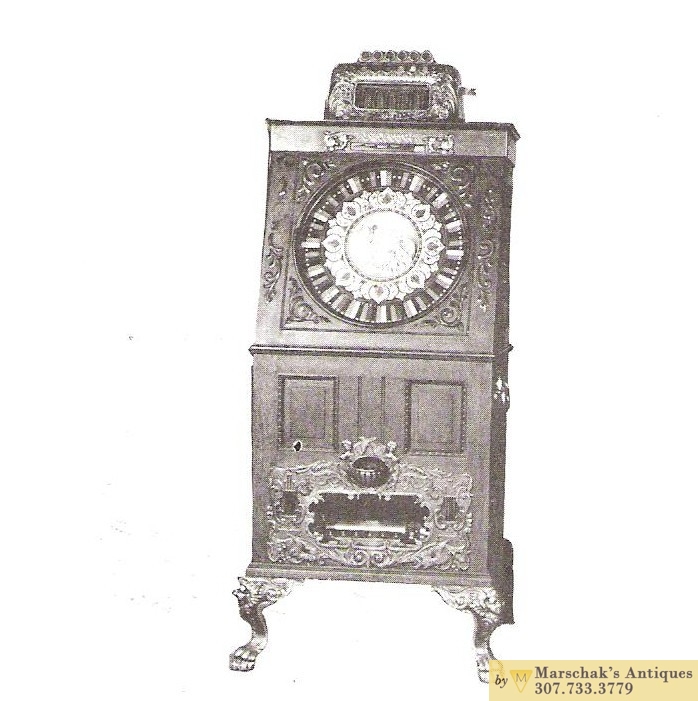
Shades of Schiemer-Yates! Back up four pages and compare this Caille VICTOR with the Schiemer-Yates GIBSON GIRL. Now if they just ain’t like two peas in a pod. Same basic cabinet with frilly wooden trim and corner insets, right down to the lower front castings, legs and coin head. These machines are just short of look alikes and run alikes. If it wasn’t for the VICTOR nameplate, the unique glass, and the fact that the wooden trim and cabinet panel work is slightly different you’d swear that this was a Schiemer-Yates machine. Hold that thought for a while; we’ll get back to it on the next page. When the first slant front Caille VICTOR showed up years and years ago — known examples were in the hands of a few pioneer slot machine collectors even before the 1960’s, it was thought to be a very early example of a Caille Bros. Co. floor machine, and dates like 1897 were freely quoted. At the time it was thought that the slant front came before the tall, straight up and down floor machines. It wasn’t until historical tracking by the author at the end of the 1960’s revealed the fact that The Caille Bros. Co. wasn’t formed in Detroit until July 1901, that a previous company called The Caine Schiemer Company started making a machine called the PUCK on July 15, 1898, and that yet another company called Schiemer-Yates Company was formed at the same time The Caille Bros. Co. was founded with both Schiemer-Yates and Caille Bros. Co. making the PUCK (Are you lost yet? It gets confusing. This whole historical track is explained in greater detail on pages 14 and 19 of Volume 1 in the “100 Slots…” Price Guide series) that the idea that slant fronts came first was blown sky high. So, if the slant fronts weren’t first, went the popular logic, they had to be last. That led to a lot of thought-to-be knowledgeable comments that the slant fronts (by that time yet another Caille slant front called the VENUS it’s described next had been recognized) were the last floor mamachines made by Caille as the final and ultimate development of the automatic color wheel. The truth of the matter is hardly as glamorous as that. The real answer is that they came in the middle. Where they came from wasn’t known until the fairly recent discovery of the Schiemer-Yates GIBSON GIRL. In one lucky find a collector came up with a truly unique machine, and taught the rest of us that the 1907 acquisition of Schiemer-Yates by The Caille Bros. Co. gave Caille its slant front line. With that bit of knowledge everything else falls in place, so you can see that the machines themselves can often tell us a lot if we know what we’re looking for and how to use the information.
Caille made the VICTOR in both “plain” and MUSICAL VICTOR models, with the musical version shown and priced. Back in 1969 an antique dealer in Lexington, KY put a plain VICTOR on the market for $1,000 and took months to unload it. One of the dumbest things I ever did was pass it at that price because I thought it was too high. In November 1977, at the famous Kruse Auction of the S.H. Mitchell collection, conducted on a mountaintop in Vesta, Virginia, a VICTOR minus its legs went on the block at $11,000 and people thought the buyer was nuts. Like a fox! That machine taught us something, too. It carries a red decal that says: “B. Sicking. Manufacturer of Slot Machines. 1931-1933 Freeman Ave., Cincinnati”. A lot of people thought it was a Sicking machine some still do but obviously Sicking jobbed it as a distributor or ran it on his own routes. The small detail of that decal confirmed the dating of the VICTOR at 1907, because that’s the first year Sicking ( See the first “Blue” volume of “An Illustrated Price Guide to the 100 Most Collectible Trade Stimulators” for more details about the Sicking Manufacturing Company in Cincinnati) started to use the double-number address.
Caille VICTORY Bell Machine
Produced between 1920 and 1925
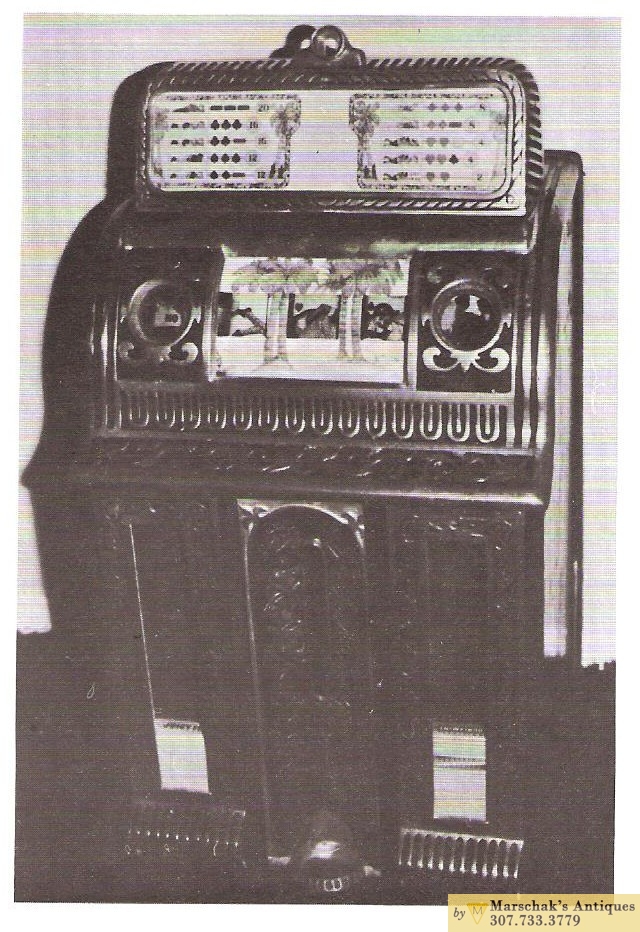
You have to be pretty sharp of eye and keen of wit to tell the difference between the Mills, Caille, and Watling Bell machines of the late teens and early twenties. They all have their distinctive qualities, but once the oak cabinet came into fashion, the machines began to look a lot alike. The Great War, that early and optimistic name for World War I, had a lot to do with it. Mills started the oak cabinet in 1915, Caille Bros. in 1916, and Watling by the end of the year. 1917 was a non-production year, because America was at war, with the 1918 Mills OPERATOR BELL looking a lot like the 1916, only it had a redesigned mechanism. To help identification out, each year for a decade most of the Mills machines had the. model year in the front casting. By then, Watling machines looked like Mills machines, and a bunch of new post WWI producers made similar Bells.
Only the post war Caille Bros. machines looked different, and how! Caille had a hard time getting back into production after the war. Losing momentum and trying to break away from the pack and come to grips with the staggering head start competition from Mills, Caille Bros. tried a trick. By that time, the Bells had a ten year history of side handles. So Caille put the pull in the middle. They did it by attaching an upside down “U” shaped piece of steel to the handle shaft on the right side and added a bearing on the left. A handle was welded to the center of the bridge with the shaft coming out of the front of the machine at the top of a tall pull slot. No other Bell before or since was put together the same way. The machine had a modest success when it came out, but not nearly the success it now has over half-a-century later. Because it is so different from other Bell machines it is regarded as an eminent collectible.
Caille called it the VICTORY model, then a popular expression because of the victory of the Allied Powers of England, France, Italy, America, Japan, and the others over the Central Powers of Germany, Austria, Hungary and Turkey in The Great War of 1914-1918. Two basic models were produced: The VICTORY BELL, with an elaborate cast iron cabinet front on an oak case showing lightly clad women in swirling robes; and the VICTORY GUM VENDER holding packaged gum in vending columns. By 1923, the VICTORY BELL, was being called the OPERATORS BELL because that’s what everybody else called their straight gambling Bells and the vender model had been redesigned to hold rolls of mints in two vending columns instead of gum.
A variety of reels specifically fruit, fortune and card symbols were used on the machines. By then, the Vender was called simply VICTORY and was known as the “Victory Mint Vender” or “Victory Counter Vender”. The machine was being sold until the end of the twenties, later models having cast aluminum fronts. Some examples of all models are known.
Caille- Schiemer DETROIT Floor Wheel
Produced between 1898 and 1901
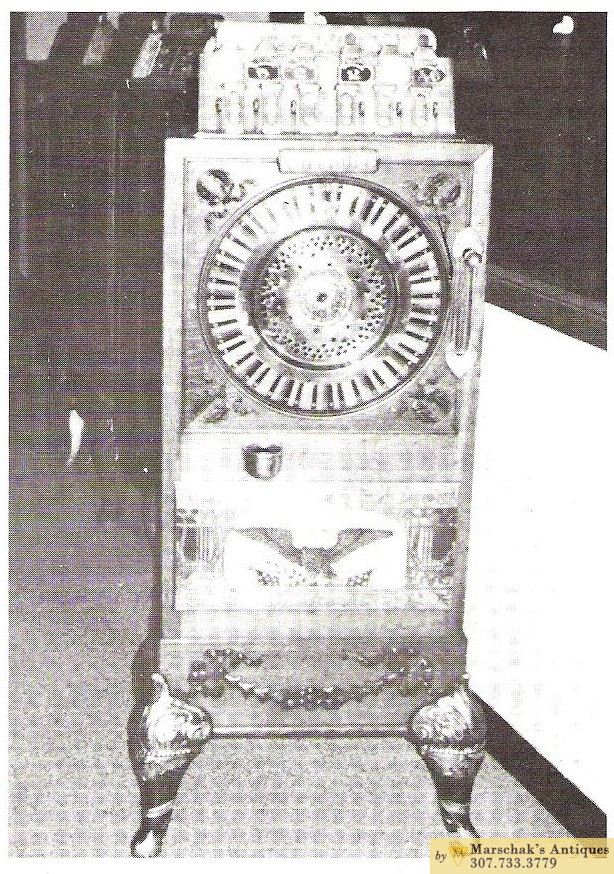
If you’ve studied the history of slot machines at all you probably know that the first popular mechanical floor model automatic color wheel machines were the 5-way Mills OWL and the 6-way Caille-Schiemer (out of the Illinois Machine Company) PUCK, both brought out in 1898. After that, whooshl All sorts of people jumped into the act and mechanical floor machines were being cranked out by the bunches. You’ll see soon, for this volume touches on a lot of these machines from the well known to the oddball.
This brief review of floor machines will also prove a point: to the winner goes the spoils. The fact that the Mills Novelty Company of Chicago was first in the field, and The Caille-Schiemcr Company of Detroit was a hot second, literally made the future of both companies. Ever afterward, for the next third of a century, the names Mills and Caille were the big ones in the business. When Caille conked out in the depression, Mills even kept that top rank for another third of a century after that.
These two big outfits got that way because they started out with a good machine, and then added to it. Both Mills and Caille pumped new models into their line as fast as they could once it was obvious that their first floor machines were off and running. Suddenly, the slot machine business was a tale of two cities, with Mills and a growing list of imitators in Chicago facing Caille-Schiemer and a smaller but similar cadre of copy-cats in Detroit. Even the city names ultimately had meaning to the slot machine buyers. If a floor machine was made in Chicago it was presumed to be a practical, hardworking device probably made by Mills. . .and the price was right. If it was made in Detroit it was probably very ornate with a lot of decoration and trim and was made by those Caille fellows and cost more.
The Caille-Schiemer Company went right along with the act and revamped their PUCK to create a new 6-way machine called the DETROIT, adding a new feature that had a lot of player appeal. As Caille described it in their catalog: “The pay wheel of a DETROIT actually stops dial and causes the payout works to operate. On account of the DETROIT being the original machine showing the pay wheel in full View of the players, it became known far and wide as ‘Honest John’. Everyone believed it could not be plugged whereas it actually has a percentage regulator of unique design that is only found on the DETROIT machine.”
Caille-Schiemer BUSY BEE
Produced between 1899 and 1916
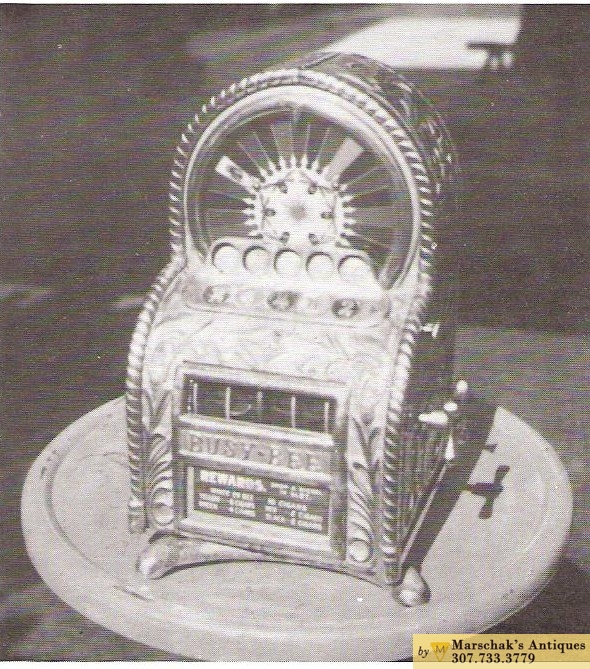
The BUSY BEE introduced what would become one of the leading names in the slot machine industry to the field of trade stimulators. The Caille-Schiemer Company of Detroit started out by making the PUCK automatic color wheel floor machine in 1898, adding the countertop BUSY BEE trade machine the next year. Looking like a roulette wheel the disc of the BUSY BEE spins Vertically giving it the appearance
of a miniaturized color wheel in a highly omamented, nickel-plated cast iron cabinet. BUSY BEE is 5-way play, permitting the player to pick a color to win 2, 5, 10 or 20 cigars for a nickel, with red, black, green, yellow and the “Busy Bee” having the same reward rates as a larger floor model 5-way color wheel. When Caille-Schiemer dissolved and the Caille Brothers Company was formed in Detroit in the summer of 1901, BUSY BEE became a Caille Bros. machine, continuing in a series of follow on developments. Caille Bros. BUSY BEE NO. 2 is a 3-way machine for penny play, with players getting 3 cigars on white, 2 cigars on yellow and 1 cigar on green, or just losing outrigit. The apparently good chance of winning a nickel cigar for a penny kept up the play, with Caille advertising saying that “one of these little machines on your counter will sell as many cigars as a salesman back of your counter,” not mentioning the fact that the salesman had to be there anyway to make good on the winners
Probably the best seller was BUSY BEE N0. 4, a 5-way nickel play machine that gave at least one cigar for every nickel played, with a chance to win a total of 2, 3 or 4 cigars on each play. It’s promotional literature claimed that “the use of one of these trade stimulator machines will stir up your business to a degree you cannot appreciate until you actually get one,”
BUSY BEES are regarded as classic cast iron pieces. As such, they command high collector prices, with the Caille-Schiemer models regarded as the most valuable.
MILLS

- Mills 50 CENT CHICAGO
- Mills BEN FRANKLIN
- Mills BIG SIX JACKPOT
- Mills BROWNIE
- Mills CHECK BOY
- Mills CHICAGO
- Mills COMMERCIAL
- Mills COUNTER O.K.
- Mills CRICKET
- Mills DEWEY JACKPOT
- Mills DEWEY TWINS
- Mills DEWEY
- Mills DUPLEX
- Mills THE JOCKEY
- Mills JOCKEY Card Machine
- Mills JUDGE
- Mills LIBERTY BELL
- Mills ON-THE-SQUARE
- Mills OPERATOR BELL
- Mills OWL JUNIOR
- Mills PURITAN
- Mills ROULETTE
- Mills SCARAB
- Mills SILVER CUP
- Mills SPECIAL GUM VENDER
- Mills SUPERIOR
- Mills TWENTIETH CENTURY
- Mills YOU'RE NEXT
- Mills Hylo
- Mills Draw Poker
- Mills Bulls Eye
- Mills Monte Carlo
- Mills Little Monte Carlo
- Mills Little Scarab
- Mills King Dodo
Mills 50 CENT CHICAGO Floor Machine
Produced between 1903 and 1916
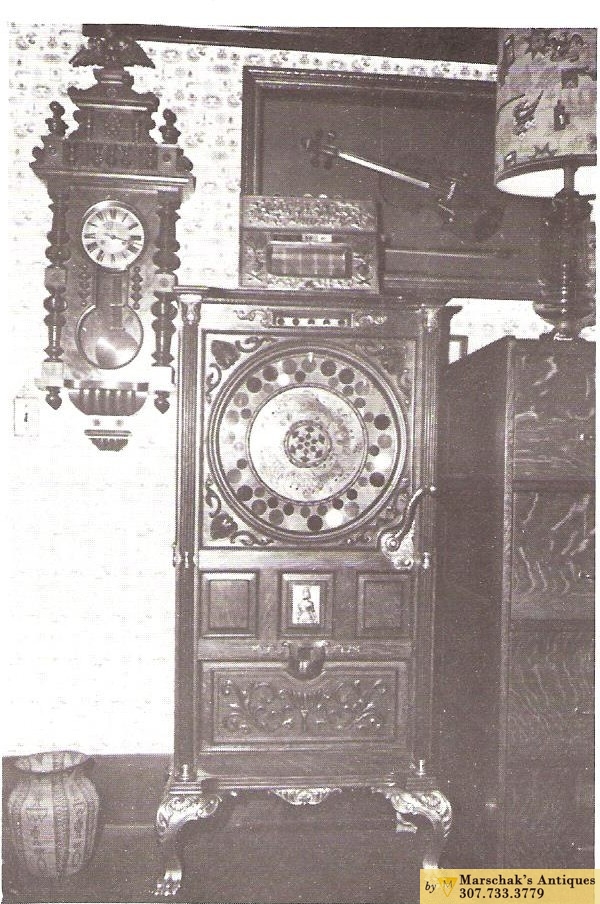
Success with the high returns of the TWO-BIT DEWEY and CHICAGO machines of 1902 led to bigger thinking, and the most unique collectibles of them all. Mills called it the 50 CENT CHICAGO. You can spot one in a collection a mile away by its spots. The 50 CENT CHICAGO as well as the 50 CENT DEWEY, have pastel colored polkadot wheels and glass. For a long time, the collectors that had them wondered if they could be original, but as more machines showed up the same way it was soon obvious that they were.
Because of the large size of the coin the machine was re-designed for a 5-way coin head that was also flatter in addition to being wider. It made the 50 cent machines look a lot different than their nickel and quarter cousins. The top payout was 20 coins, or $10.00. The large coinage playing 50 cents in 1903 would be like dropping $5.00 on a single handle pull today suggests that the 50 cent CHICAGO and its companion 50 CENT DEWEY were not made in large numbers, so it’s probably lucky that any survived at all. By the time the 50 CENT CHICAGO was being made at the end of 1903 Mills had already sold 15,000 CHICAGOS and DEWEYS of all models. Guesstimates would suggest that, in all, some 30,000 to 40,000 of these machines were made and sold over the years, so if somewhere between 300 and 400 still exist, that would suggest an overall antique slot machine survival ratio of 1:100, or 1% of production. The same ratio seems to hold up for the OWL, and perhaps the JUDGE. Optimistic collectors like to believe that at least one of every machine ever built exists some where. All they have to do is find them.
In a way the 50 CENT DEWEY helps prove the point. The arrival of the 50 CENT DEWEY made it possible to create another unique machine, the 5 cent, 25 cent and 50 cent play Mills DEWEY TRIPLET, a 950 pound monster with seventeen coin chutes, three handles and three spinning wheels, each operated by a different coin. To date, no DEWEY TRIPLET has confirmed as found, although rumors continually abound about one in a collection, or the creation of one out of three existing DEWEYS. Unless a shy, or publicity phobic collector has one hidden away, the DEWEY TRIPLET remains a “lost” machine. So find one! And while you’re looking you might see if you can locate one of the DOLLAR DEWEY machines created out of nickel machines by Charlie Fey of San Francisco for local operators in the late nineteen-twenties. None of those have shown up either.
Mills BEN FRANKLIN
Produced between 1901 and 1915
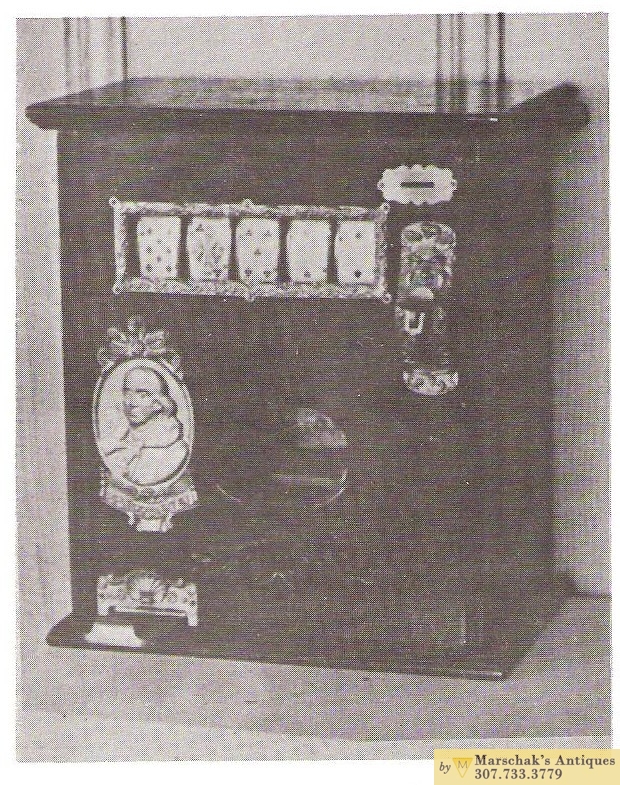
The gum vending Mills BEN FRANKLIN has a developmental history starting with Canda that parallels that of the LITTLE PERFECTION. For one thing, the mechanism is the same. Canda produced an alternate “humpback” PERFECTION CARD machine around late 1896 with numbers on the reels instead of poker symbols. They called it PERFECTION FIGARO. Then they made a tall boxed vertical cabinet machine in 1897 with a token payout using the same number reels, adding a “jackpot” or “prize” window a pocket watch was usually hung in it as the top trade prize calling it the FIGARO CHECK MACHINE. Without the trade check vending attachment the machine was called UPRIGHT FIGARO, and with poker reels it was once again a card machine as the COUNTER PERFECTION, also called UPRIGHT PERFECTION, with the reward card offering “Free Cigars.” They also made the check payout model as a card machine. The lines had come full circle.
Mills picked the COUNTER PERFECTION up from Canda with the smaller PERFECTION machine and continued to call the tall version the UPRIGHT PERFECTION, selling it in 1 cent, 5 cent and 10 cent play. Its nicknames were “Upright Card” or “Square Top” (as opposed to “Round Top”). The descriptive difference still hold, with collectors often calling the UPRIGHT PERFECTION a “Square Mills,” while the smaller machine is called a “Round Mills.” For a brief period Mills also called this machine the UP-RIGHT CARD MACHINE, going back to the UP-RIGHT PERFECTION name by 1907.
The me-too producers had a field day with the UPRIGHT PERFECTION just as they did with the smaller card machine, only in the main there were fewer and different makers. Surprisingly, Watling never made the machine, while Caille Bros. spun it off into a whole series of newer machines, including MERCHANT, BANKER and others. Mills did the same thing, modifying the machine to create BEN FRANKLIN for one. But it was the newer producers that were the most interesting, notably The Kelley Manufacturing Company of Chicago. Kelley made the machine in 1903 for gum or cigar payouts, calling it the COUNTER PERFECTION just as Canda had. The Canda, Mills and Kelley machines look so much alike it’s hard to tell them apart except by their “paper”.
Mills BIG SIX JACKPOT Floor Wheel
Produced between 1906 and 1920
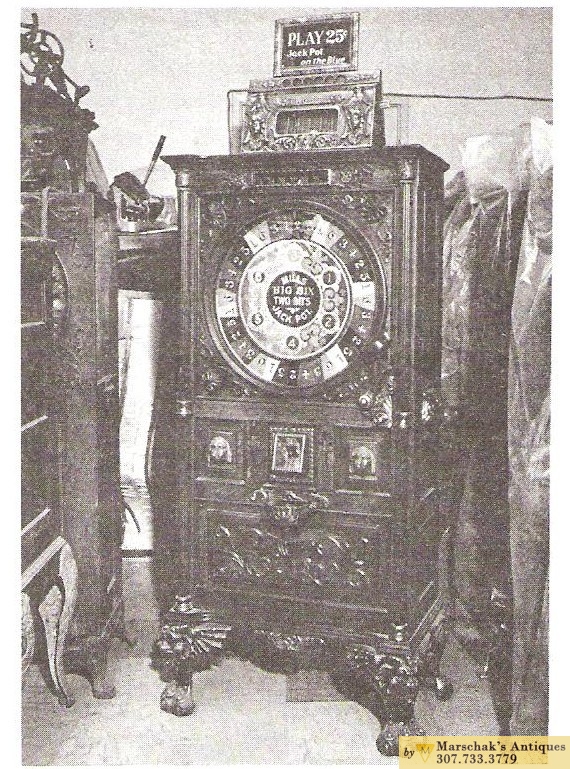
This series of illustrated price guides has covered the BIG SIX floor machines of other makers, with the Watling BIG SIX (see Volume 1, page 28) and Caille BIG SIX (see Volume 2, page 70) gathering the initial share of attention. But here comes the heavyweight of them all, the Mills BIG SIX. To be more specific this is the Mills BIG SIX JACKPOT model, and when we say heavy weight we mean it. While Mills seems to have been a late corner to the BIG SIX sweepstakes, with Watling and then Caille coming fast, Mills made up for the delay in sheer bulk. Taking the basic DEWEY/CHICAGO cabinet, the basic Mills BIG SIX weighed in at 290 pounds ready for shipping. Add the jackpot feature in the Mills BIG SIX JACKPOT model and that weight gets bumped up to 320 pounds. Now let’s just assume that you’re tooling along in your brand new Datsun or Honda or Ford MUSTANG and you run across one of these things for a couple of hundred dollars in a small town 600 miles from home. What the hell would you do? Trade the nejcar in for a beat up old rusty van on the spot, that’s what you’d do! Few people get more than one shot like that in a lifetime, and you know damn well — or at least believe — that every collector you ever met is only six miles behind you on the same road, driving a pickup.
What a monster! What a beauty! Mills made the BIG SIX as a classy and and artful machine, with a 5-for-1 payout on all colors. Actually, all flags, for the original Mills BIG SIX had the colorful flags of six nations on its wheel. Pick any one, and if it hit you’d get five coins back. The odds to the player were pretty good because all flags and colors payed the same rate. On raw count, for every six coins at once your odds to win were close to fifty-fifty. It’s a good crap game bet: five for three, on an even chance to win. So the house made its take on the sixth coin.
The Mills BIG SIX JACKPOT model has some distinctive features of its own. It was made in nickel and quarter play, and sold for twenty percent more than the standard model. The 1918 Mills catalogue lists the BIG SIX at $125 in nickel play and $150 in quarter, with the BIG SIX JACKPOT models selling for $150 and $175. The 1910 Mills catalogue makes some interesting points about the machine. It says: “Pays five for one on any color. Straight percentage play. No plugs used. Gets continuous patronage because players know it gives a square deal. Can’t repeat on any color. Dial revolves at a different speed each play. Clogging prevented by device which automatically vibrates tubes each play. Certain coins played in go into the jackpot instead of into the money bag and the contents of this pot is automatically tipped out to the player when the jackpot flag wins”. That last line is interesting because it flags two models. According to the 1910 catalogue the wheel had “six different national flags arranged in 36 spaces on dial. All flags except jack pot pay five for one”. Later machines dropped the flags for colors and numbers ala Watling and a straight gambling approach without the aesthetics of foreign flags. Number “3” was also “Jack Pot”, so you either got 5-for-1 on 1, 2, 4, 5 and 6, or whatever was in the glass-walled jack pot box on a 3. Here’s another interesting comment out of the 1910 catalogue: “Finish: Quartered Oak, Mahogany, Black or Green; trimmings nickel or oxidized. Black cabinet with oxidized trimmings always shipped unless other-wise specified”.
Mills BROWNIE Counter Machine
Produced between 1900 and 1922
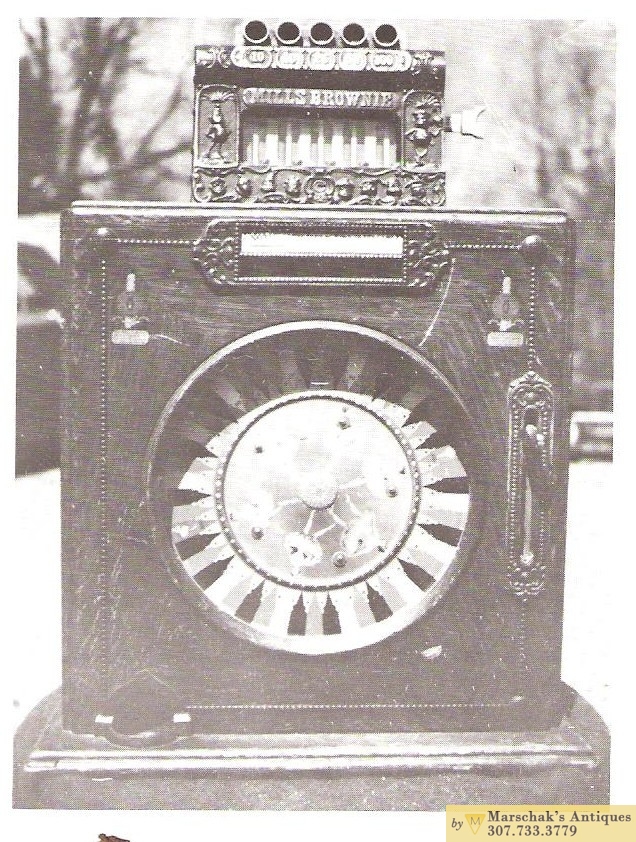
The 5-way Mills BROWNIE was one of the most popular counter slot machines ever produced. Naturally, as a result; it had a raft of imitators. They are equally collectible, although the early Mills machine is generally regarded as prime over the Watling, Caille or other models. The BROWNIE was the natural development of the OWL JUNIOR, although somewhat simpler and slightly smaller. The name came from the elfish characters created by artist and writer Palmer Cox for a series of articles first appearing in the children’s magazine St. Nicholas. starting in 1882, and later in a series of Brownie adventure books widely read in the Victorian years and well into the 1900’s. A syndicated Brownie comic strip even lasted until the 1950’s in a number of major metropolitan newspapers.
Mills BROWNIE coin heads range from mundane to marvelous. The coin heads from the 1905-1907 period show the miniature Brownie people scampering all over the countryside depicted on the castings. One of the machines, dated 1906, has the serial 249. Earlier and later heads are identical to the current OWL and JUDGE floor machine and other counter wheel machine heads with a scroll design and they aren’t quite as charming. BROWNIE dating is often confused by the “Pat. Nov. 8, 1898” marking on some of the heads for the machine didn’t see the light of day until 1900 and thereafter. The dials also differed greatly over the years ranging from strict color wheels to absolutely terrific dials with running and jumping Brownies and even Brownie faces. The variety in the heads, cabinets and dials has barely been plumbed and there may be many more than most collectors are aware of. The BROWNIE was made in BROWNIE, IMPROVED BROWNIE, CHECK BROWNIE and BROWNIE JACKPOT models by Mills, the latter having a special glass-boxed payout for hitting the high color. A short run was even made of a BROWNIE model with two dials side-by-side, first called the DOUBLE DIAL BROWNIE and later the SILVER CUP. Only one of these double dial machines is known to have survived the years.
Mills made the original BROWNIE until the early 1920’s. So did Watling. After that the Watling machine was modified and placed into a much less elaborate cabinet, going on in sales as the O.K. BROWNIE VENDER and BROWNIE JACKPOT well into the early 1930’s.
Mills CHECK BOY Counter Machine
Produced between 1907 and 1916
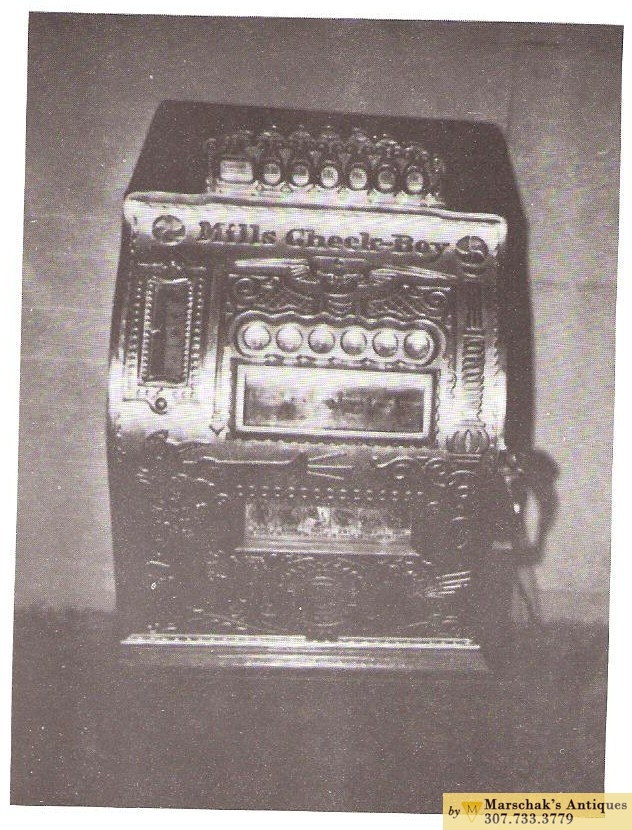
The Mills CHECK BOY is an advanced development of the earlier ELK and PILOT machines, adding increased payout capability, a much larger cash box to make operator collection times longer, and stabilizing the onereeler at 6-way play. As a result, it is a much bigger machine than the other two. While it doesn’t look that way in a photograph, it’s surprising to see its added bulk when single reelers are placed side-by-side. Mills brought it out in 1907 as the counter machine equivalent to its highly successful 6-way DEWEY. They even called the machine the “Minature Dewey” and claimed that some operator owners were taking in as much or more with the CHECK BOY as they were with the DEWEY. The machine came with a thousand payout trade checks that were “Good for 5 cents in Trade” and on up to two dollars. The checks alone are worth a few bucks each these days. The trade checks gave the machine its name: CHECK BOY. It quickly became a front runner, really earning its spurs just as the LIBERTY BELL and OPERATOR BELL were beginning to carve out their place in the market. Because of its successful albeit short survival after the introduction of the three-reelers the machine is covered out of sequence even though it was initially produced before the Bells.
It probably seems illogical that a single-reeler would still be in production after the introduction of the Mills LIBERTY BELL and OPERATOR BELL. But that’s not the case at all when you relate the machines to their place in time. By 1910 the single reeler was an already popular gambling machine format while the Mills Bells were still an unknown quantity. True, they showed early promise, but at the time, no one knew that the Bell would overpower the trade for years to come. So Mills covered both bases. Caille Bros. did too, for they copied the CHECK BOY very closely with their own model. By 1910, Mills Novelty Company was telling operators that it took two different machine formats to serve a gambling machine route, and recommended LIBERTY BELL and CHECK BOY. The bloom never really wore off the CHECK BOY until the coming of the oak cabinet Bells, with some operators running CHECK BOYS well into the twenties.
An early Mills CHECK BOY serial is 925. By 1914, they had gone to 7640, and probably went higher. Mills machines seem to survive over Caille machines at about three for one. A side vender model was also made, and an elaborate lashup with two spinning wheels added was sold as SILVER CUP. None of the latter are known.
Mills CHICAGO Floor Machine
Produced between 1900 and 1916
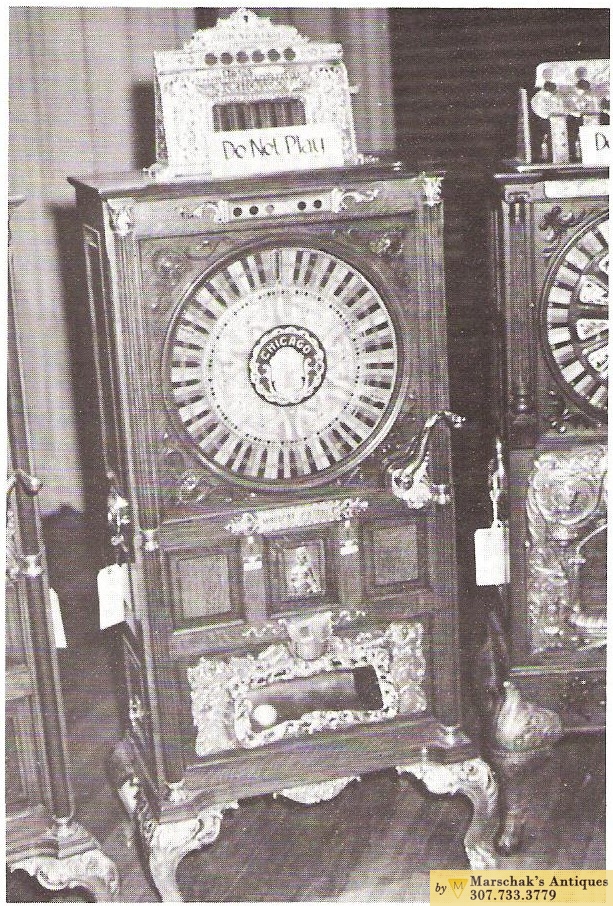
If you look at a Mills DEWEY, and then a Mills CHICAGO, and then begin to wonder which is which, you’re not alone. They’re virtually the same machine. The only real mechanical difference is that on the CHICAGO the stop arm and ratchet wheel are both out in front where you can see them. It gave the players a feeling of confidence to know that the wheel wasn’t bugged. If you’ve ever taken to a look at the stop drum behind a DEWEY wheel you’d know what they meant: all you have to do to gaff the high colors on a DEWEY is snap the spring mounted percentage plugs in place and the wheel won’t stop on the plugged colors.
The CHICAGO machine has other virtues, mainly a stunningly beautiful dial with the female figure of the “I will” lady and the City of Chicago seal colorfully displayed. An interesting touch is that the CHICAGO dial, the DEWEY dial, too was made and so marked by The American Can Company, which just goes to show that they didn’t always just have their eye on the grocery shelf. In place of the bust of Admiral Dewey below the wheel, the CHICAGO has the standing figure of the “I will” lady once again, only the city motto is written out on her waistband. That must have led to a few laughs and some raunchy jokes in the saloons and billiard parlors that characteristically ran the machines.
The differences between the CHICAGO and the DEWEY are really only skin deep. The same maintenance and repair manuals were used for both machines. The other difference is that the CHICAGO wasn’t produced as long as the DEWEY. But there most differences end. Even the cabinets for the CHICAGO were marked as DEWEY cabinets, a typical serial being 10964 for a machine made in 1903.
Like so many machines before, the CHICAGO name was copied by other manufacturers. But not many. Mills also made the CHICAGO in musical, check-play-and-pay, a 50 cent play model, the latter around 1904, and an export model for France. There are quite a number of CHICAGO machines around, but nowhere near the surviving DEWEY population.
Probably the best known competitive machine carrying the CHICAGO name was a model made by Watling, although Automatic Machine & Tool Company also produced a number of models as the HULL’S CHICAGO.
Mills COMMERCIAL Card Machine
Produced between 1905 and 1914
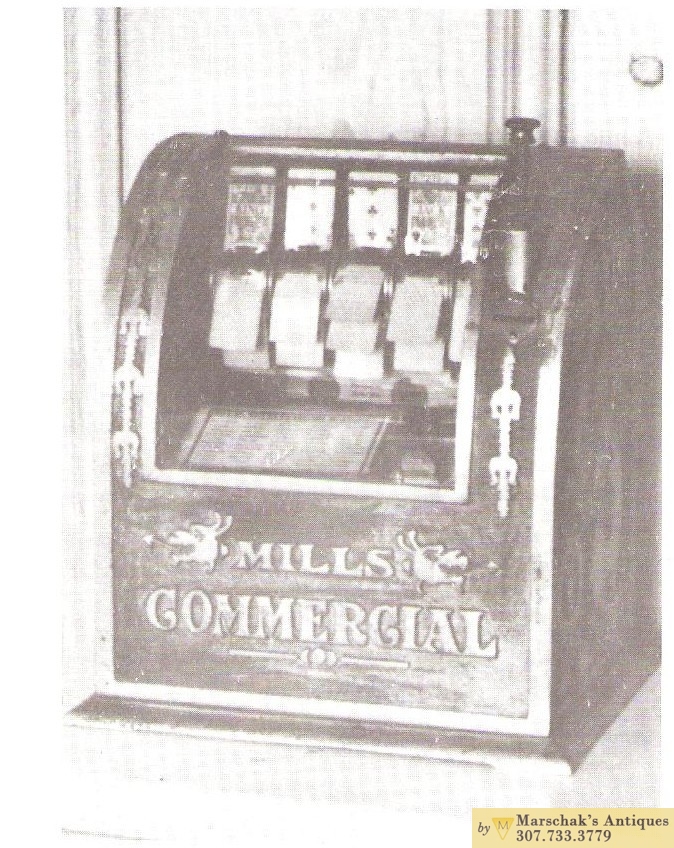
Here they come; the cast iron counter machines! The Mills COMMERCIAL certainly wasn’t the first, but it is early with enough examples around to be regarded as a collectible. The first cast iron machines were made in the early 1890’s, but it was in the 1905-1915 period that they were in their glory. The purpose of cast iron was to make a slot machine both heavy and good looking. The weight made it difficult for a player to pick up and shake the machine to manipulate it. The good looks came from the fact that casting permitted intricate cabinet design while the iron willingly took nickel, brass, copper, bronze or ormolu plating as well as a rich looking oxidized finish, so a machine could virtually be any metallic color desired, or even painted.
The COMMERCIAL was not originally a Mills machine. It was first made by W. H. Clune, an early Los Angeles producer of slot machines for the local market. When the Mills Novelty Company opened up a San Francisco office in 1901 one of the main purposes was to beg, buy or steal regional machine ideas for Mills production in Chicago. The COMMERCIAL was one of the first of the California machine ideas to be so purchased, with Mills production soon far surpassing the earlier Clune machine population. By 1906 over 10,000 of the COMMERCIAL machines of both producers were in use in California alone. The machine display is interesting, using actual playing cards as the show symbols. The cards were attached to drums at their base, flipping in rotation as the five drums were revolved following the play of a coin. The idea originated in the early 1890’s as one of the first forms of spinning reel machines. They were generally known as “Card Exhibiting” machines, with many different kinds made before the COMMERCIAL.
Mills variants include the flat and wooden cash box versions, as well as side vender model with a vertical stick gum vender cabinet of cast iron. This is one of the very first uses of a side vending attachment on a counter slot machine. One of the side vender models was found in an old country store in Ohio,
Most of the Mills COMMERCIAL machines known are nickel plated although some oxidized finish examples also exist. Due to a large viewing window, you can also watch the mechanism at work when the machine is played. A typical Mills serial is 1496.
Mills CRICKET Floor Machine
Produced between 1911 and 1916
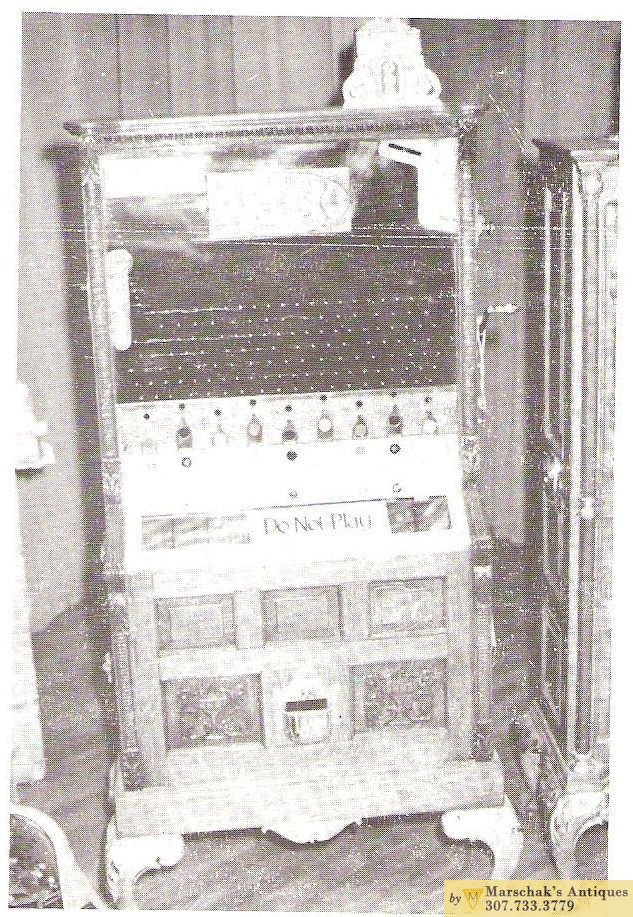
The first time I saw one of these early wooden cabinet Mills COUNTER O.K. machines at a Chicago area slot show the collector that had just found it in Wisconsin said, “Not too shabby, eh?” He related the story. He didn’t really know what he had when he first found it with a bunch of other old coin machine junk, mostly because it was grimy and dirty with over sixty years of accumulated glop on its cabinet and castings. Everything was the same dark and gloomy color. It was just another Bell.
Then he started cleaning it. Whoa! What’s this? A shiny, super big coin head at the top? Jeez! What’s next? A working O.K. window? Holy Mackeral! Original paper? With every swip of the cleaning brush and wood treatment the bucks went up. They stayed right there for the Mills COUNTER O.K. is a bloody jewel.
This machine is not a direct line derivative of the cast iron Mills LIBERTY BELL (with card symbols) or OPERATOR BELL (with fruit symbols) “Iron Case” machines but rather a development of the floor model cabinet Bell gum vending machines, confirming exactly what Harvey Carr said about the gum selling function of early Bells. It’s almost as if Mills had taken the top portion of their NEW GUM VENDER ( See Volume 3, Page 63) of 1911-1914 and added a large cash box behind the metal panel and payout cup across the bottom to create a whole new line of counter machines. Well, that’s exactly what happened, with Mills even retaining the enormous coin head of the floor machine. There were logical reasons. First, it looks great all nickel plated and gave Mills their closest brush with the elegant Caille Bros. look. But foremost, the new coin head did a lot to prevent slugging, something that was quite difficult to control with the old straight line gooseneck on the “Iron Case” models. Stamping presses were just entering industry in large numbers and the press operators were not above setting up to punch out a couple of thousand nickel-size slugs for themselves and their friends for a little extra curricular use in telephones, vending machines, cigar machines and slots to add a little joy and petty crime to their lives. It drove the coin machine makers and operators batty for years with literally hundreds of ideas for combating slugs being patented and put on coin machines over the next half a century. It wasn’t until the electrical coin acceptor came into common usage in the 1950’s and 1960’s that the battle was finally won.
Among the early all mechanical, non-electrical slug detectors the coin head on the Mills COUNTER O.K. was a pace setter. Borrowing from even earlier experience with the floor model Mills OWL and DEWEY coin heads, the new 1-way head was submitted for a patent on October 5, 1911. A quick three months later, on January 9, 1912, it received Patent No. 1,014,320. Its patent description states it was developed “to provide a novel construction of coin controlled device for use on vending machines in preventing such a machine from being operated to deliver merchandise by the insertion into the device of other than a proper coin of predetermined denomination”. In practice that meant that nickel size slugs, or lower denomination pennies, were easily seen and removed, or the playable nickel put into action, by the use of a push bar. Copy in the casting says, “Insert 5 (C and receive a package Liberty Bell Gum Fruit”, which seems a little bit like inverted German word order. But the players got the message, even though they didn’t get the gum from this venderless version. At least they got their fortune told, somewhat, by the O.K. feature, with copy on the award card below the O.K. window saying., “This Tells Your Fortune”.
A tall side vender model was also produced and more commonly used as the MODEL NO. 7 COUNTER O.K. GUM VENDER, later to become known as the 1916 O.K. GUM VENDER Other than the vending feature on the left ( and non-handle) side and the necessary trip coupling to the mechanism it is virtually the same machine, only it even glitters a little more.
Mills CRICKET Floor Machine
Produced between 1904 and 1930

A lot of collectors believe the Mills CRICKET to be the most entertaining coin machine ever made. In a way, the player is part of the play action. The coin certainly is. Once the coin is dropped and the handle pulled, the player shoots the coin across a pinfield to hit the pay holes at the top, or bounce down the board on a zig-zag course to hit one of the jackpots, or disappear as a loser. It’s like a gigantic Pachinko game or an incredibly fast vertical pinball game. The coin does all the work, and the player can watch every twist and turn until the end.
Most collectors that have CRICKETS keep them and play them. Enthusiasts that try the machine will often search high and low to find one for themselves. Because of this, it’s surprising that CRICKET prices haven’t run way ahead of floor machines; but they haven’t.
Mills brought the CRICKET out early in 1904. It is a large floor mounted machine based on one of the oldest coin game principles ever invented, with a heritage of the hundreds of different coin drop pinfield machines that were made between the early 1890’s and the 1900’s. The CRICKET was made in penny, nickel, dime and quarter models, although in later years only the nickel and quarter models were produced. CRICKET production lasted until around 1930 with new machines being sold from stock well into the thirties. Operators ran them in Wisconsin resort areas into the middle forties,
On location in the early days the CRICKET had to be watched. Cheaters learned that an iron slug the size of a nickel could be played, with a powerful magnet then grabbing the slug through the glass to work it down the course into a jackpot pocket. In less than five minutes the magnetic player could clean out the machine. Players also had a tendency to kick or shake the machine while the coin was in play in order to control its course. The electric tilt mechanism of the pinball game hadn’t been invented yet, but no matter, as the problem was solved in a most pragmatic manner. Owners just bolted large chains to the floor, attached to a ring on the underside of the CRICKET cabinet. Some of the surviving examples still have these rings. Caille Bros. made an almost exact copy of the CRICKET, coming out less than six months after the Mills model. They called it the
BULLFROG. There have been a lot of rumors to the effect that collectors in Texas, Georgia, Minnesota and elsewhere have BULLFROG machines, but to date none have been confirmed. CRICKET values are hard to pin down, mostly because the machine is generally traded rather than sold. Because of its rarity BULLFROG values, if such machines do exist, would be half again or even twice as high.
Mills DEWEY JACKPOT Floor Machine
Produced between 1902 and 1926
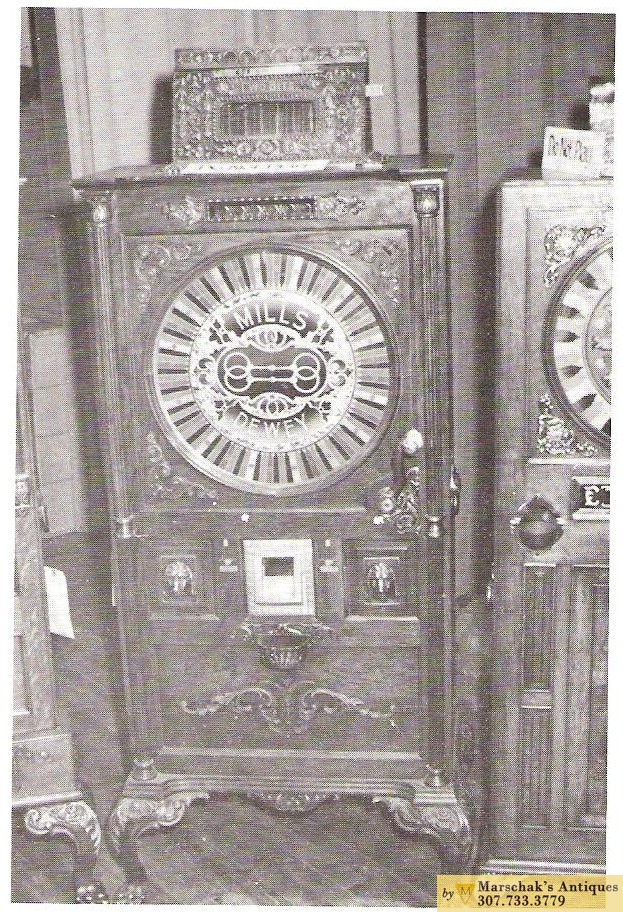
More modifications were made to the Mills DEWEY than any other floor machine ever produced, and a collection of known DEWEY variants would run even the biggest collector out of money in a hurry. One of the best liked by collectors is the DEWEY JACKPOT, and at the top of this list is the TWO BIT DEWEY JACKPOT.
It all started with a quarter play model of the regular DEWEY made in 1902. The quarter coin had long been called “two bits”, originating with the early United States use of Spanish coinage. A Spanish “bit” was worth one-eighth of a peso, so “two bits” was one-fourth of a peso when the peso was equivalent to the American dollar, therefore, a quarter-dollar. When Mills made the TWO-BIT DEWEY they etched the picture of a double horse bit into the glass two rings joined by a bar to signify “two-bits”, or 25 cent play. A typical serial for this machine is No. 1072. Mills also made a musical model.
Next came the DEWEY JACKPOT, first in nickel play. The highest tube paid payout on the wheel was replaced by a jackpot payout of a bunch of coins in a windowed casting right over the payout cup. On the nickel machine this was around $2.00 or more. When the 25 cent DEWEY JACKPOT model was added to the line, there was $10.00 or so showing under that glass, or enough to make a bulldog break his chains. There are a lot of variations in the glass and castings of the TWO BIT DEWEY and DEWEY JACKPOT machines, with the words written out, symbolized, or just ignored. To add to the original factory built variations, the machine operators themselves would switch glasses and parts to keep their DEWEYS running, ending up with lash ups that ran okay, but didn’t look anything like the factory originals. Years later, with collectors trying to make some sense out of the mixed and matched machines that show up from time to time, it’s often hard to figure out what the originals might have looked like.
DEWEY JACKPOTS were still being produced and sold in 5 cent and 25 cent play models as late as 1926, with new machines sold from stock into the thirties. By 1925, the 25 cent play DEWEY JACKPOT was selling for $475 new, a far cry from its 1918 price of $175. Musical models went for more. The pricing that hurts is that of the forties, with a Minneapolis slot machine dealer trying to unload a 5 cent-25 cent DEWEY JACKPOT TWIN in 1942 for $150. Just find out who bought it, and what basement it’s in, and you’re on your way to a room filler.
Mills DEWEY TWINS Floor Wheel
Produced between 1903 and 1916
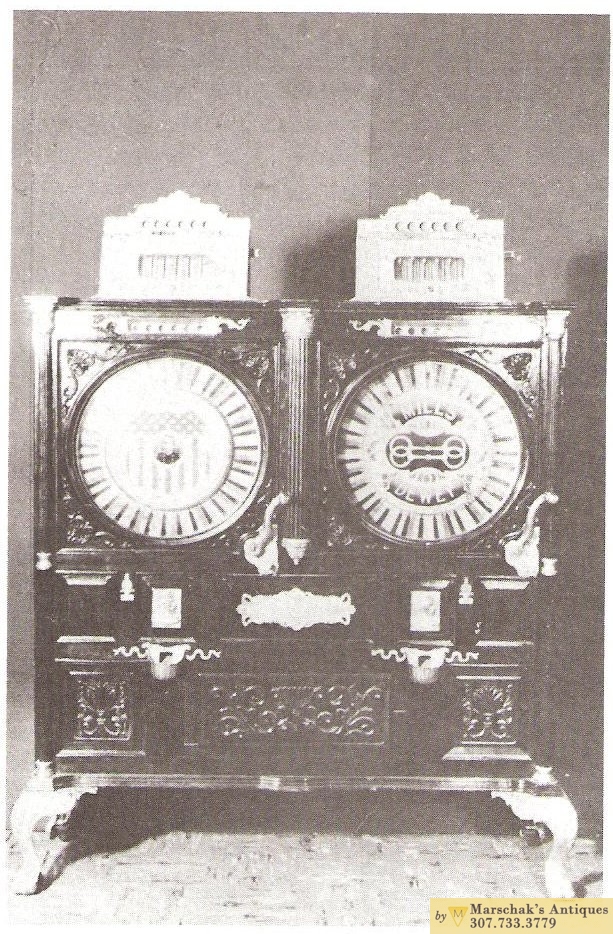
There was a time not so long ago when Mills DEWEY TWINS machines were thought to be among the rarest of the rare. They aren’t common machines by any means, but there’s more of them around than collectors first thought there were.
This is a big machine, weighing in at 600 pounds. That’s a lot of wood and hardware to move around in a saloon, much less ship out from Chicago to a god forsaken spot out west. And that’s just where a lot of these machines ended up. Most of the examples that have been found have showed up west of the Mississippi River, stuck away in some old saloon building or in someone’s home. Imagine moving these things from the Railroad Express office to its location back in 1903, back before there were automobiles and trucks and everything had to be moved by hand with only the help of dray horses.
The DEWEY TWINS were made in a wide variety of models as evidenced by the old Mills Novelty Company literature. A 1913 catalogue says that they made up “any combination of CHICAGO or DEWEY machines”, adding that ” This winning combination is made up of two splendid machines, the DEWEY and CHICAGO. We furnish this machine either as the plain DEWEY, the DEWEY JACKPOT, DEWEY TWINS or DEWEY TRIPLETS and with or without the musical attachment”.
As far as tracking down these machines is concerned, there’s some very interesting current history that goes along with that, too. One had been used in the movies for years with “funny” glass. One side was a Mills TWO BIT DEWEY while the other was marked “LUCKY PLAY” with a star in the middle. Somebody in Hollywood must have made that up because no DEWEY TWINS was ever produced that way. This example was put on the block at the famous MGM auction and was sold to a Ft. Lauderdale, Florida, antique dealer who resold it to a Des Plaines, Illinois dealer who restored it to original condition and sold it again. Another was sold at the first Harrah’s Pony Express Auction in Reno in 1975 for $7,000. That’s pretty darn cheap and that’s not that long ago for a DEWEY TWINS MUSICAL. The S. H. Mitchell Auction conducted by Kruse in Vesta, Virginia, in November, 1977, produced one at $21,000 once the bidding was straightened out; a Texas collector has one, and there’s another one in California.
Then the author found one! But no one can touch it. Writing to Western state historical museums in 1978 looking for old saloon photographs with slot machines in them, the State Historical Society of Colorado replied to the author’s letter by asking if a recent photograph of an old slot machine they had in storage would do. Five dollars was sent for a print of negative No. F-8,488 and the picture above came back.
Mills DEWEY Floor Machine
Produced between 1899 and 1926
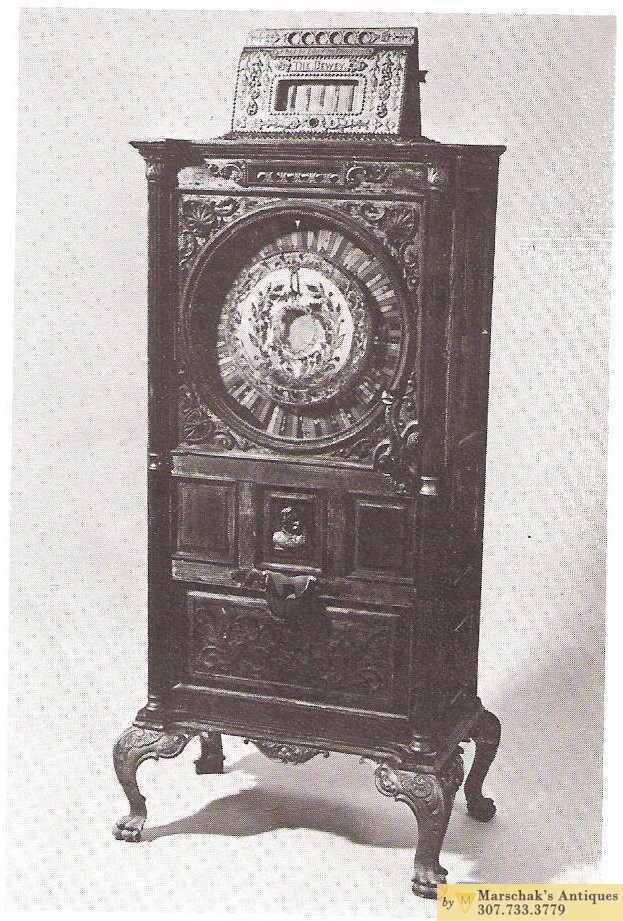
If a single machine could be said to be the prime Victorian slot machine collectible, that machine would be the Chicago made Mills Novelty Company DEWEY. These are the showpiece machines of many collections. There’s a lot of them available. They’re big, colorful, have marvelous mechanisms, and their value is continually increasing. Educated guesses place the surviving machine population at somewhere around 200 machines, although some estimates go as high as 800. Whatever the number, the DEWEY has and will always have a high level of snob appeal. As the number of slot machine collectors climbs and that seems to be the trend the demand for the DEWEY will increase. While there seems to be enough to go around, when things get tight somebody will get the bright idea to reproduce the machine if and when the antique value gets to be twice the marketable price of a replica. But no matter. Having a DEWEY around the house will always be a treat, whether it be original or repro.
The DEWEY barely tipped itself into the 19th Century. It wasn’t the first machine with the Dewey name some counter-top games and vending machines by other producers already used the name nor was it originally conceived as the DEWEY. H.S. Mills had the new automatic color wheel machine developed as a bigger and more attractive 6-way than the competitive Caille-Schiemer models already on the market. Mills probably planned to call it PUCK. But just as the machine was ready for introduction in September of 1899 Admiral of the Navy George E. Dewey was on his way home to America to be welcomed as “The Hero of Manila”. So Mills stuck his name on already available mechanisms, tying in with three months of banner headlines, and the most famous slot machine of its day was launched into the 20th Century.
The DEWEY was continually improved over the years, and at least a dozen variations of the machine are known, with changes in the cabinet, castings, or glass, or in all three. This isn’t surprising as the machine was in production for well over twenty years and was sold new from stock as late as 1932. Some collectors believe they have early DEWEY machines made in 1898 based on the notation “Pat. Nov. 8, 1898” in the castings of the coin head. This is misleading as the date refers to the coin head patent, No. 613,844, and not the DEWEY machine. DEWEYS were originally made for nickels only, coming out later in models for every coin of the realm. The fantastic variety of coinage, musical, check play, double, triple and other models makes the Mills DEWEY.
Mills DUPLEX Floor Wheel
Produced between 1899 and 1916
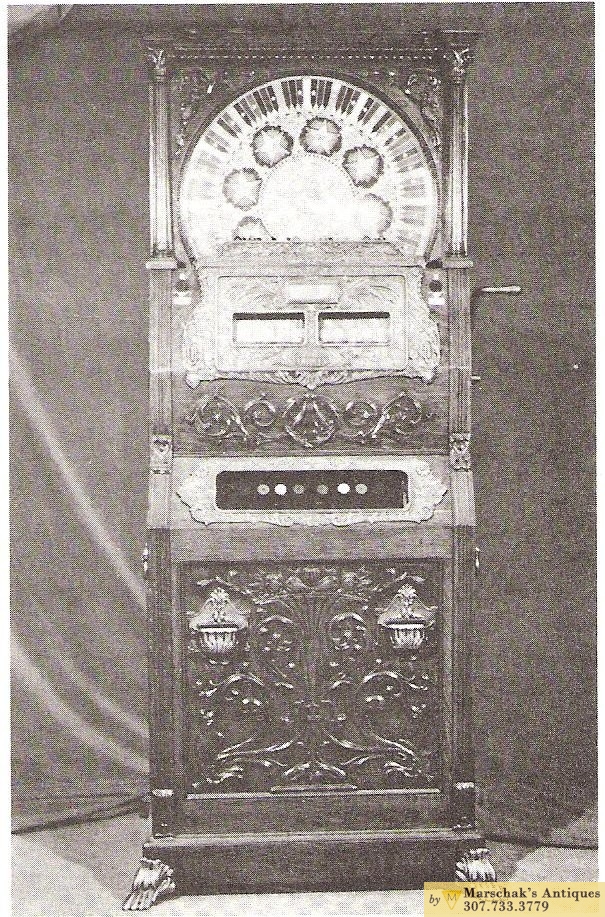
What is the largest, most imposing automatic payout slot machine a collector can have? What slot machine is rated the “most desirable” and immediately indicates a “significant collection”? What’s the number one “premier” slot machine in the country? The answer to all of these questions is the Mills DUPLEX. It is now, anyway. It wasn’t always that way.
“How come?”, you might ask when there’s at least six or seven of these machines around maybe more? That takes us right into one of the most lopsided aspects of antique slot machine collecting. Rarity has something to do with value, of course. But rarity alone doesn’t set a price. Desirability does! And to make a machine desirable to a number of people its got to be reachable. In short, there’s got to be more than one. Based on past experience it would seem that top desirability starts at a population of about four or five machines and begins to taper off at a dozen machines. There are exceptions, of course, but many a collector has a one of a kind machine that can’t match the value of a “War Eagle”, the latter a fairly common machine. They’d be better off if there were three or four of them. Then you can go the other way. There are so many Watling ROL-A-TOP and TREASURY machines around, one wonders why they’re worth so much. But they are, no matter what their population, and its desirability that makes the difference.
Fads make a difference too. By the end of the 1970’s the most wanted machine was a Caille ROULETTE or PEERLESS. The much rarer Mills ROULETTE wasn’t as desirable for some reason. The word was that if you had a Caille ROULETTE floor machine you were Big Time. You still are if you’ve got one of these terrific machines, but by 1980 the Mills DUPLEX had gotten even Bigger Time. Maybe that’ll change; maybe not. But as of this writing you’re looking at the king!
Marvelous machine; It looks a bit like a Berger or White OOM PAUL or AMERICAN BEAUTY, only it’s bigger. 10-way play no less, and two payout cups. It’s like a twin in a single cabinet. Pick one or more of five colors, left side or right or both, and crank down. You’re playing for ten jackpots and you get whatever’s in them. The red and black pockets empty fast but up at white or green the full pockets are a constant temptation. So you hit green. Now aren’t you sorry you didn’t play both side? On actual location, take a look at that saloon photo elsewhere in this book, there were often two players.
These machines are still being found. One showed up in 1979, another in 1980. They’re worth so much it’s like finding a gold mine. But, prime or not, there’s still one more machine that beats it as “most desirable”, and that’s the original Fey LIBERTY BELL. But more have to be found to make it popular.
Mills THE JOCKEY Floor Wheel
Produced between 1899 and 1901
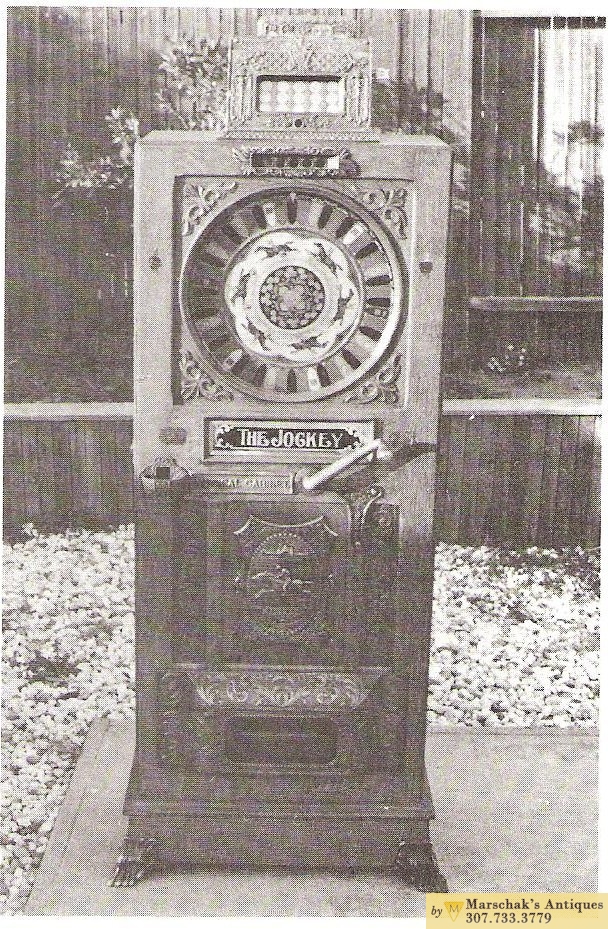
In the first volume of this “100 Most Collectible Slot Machines” price guide series we started out with the Mills OWL as machine number one, saying that it “made the whole idea of antique slot machine collecting possible” because of its high surviving population as the “first successful all mechanical floor machine”. That’s true, of course, but we’ve all gotten a lot more sophisticated since the initial publication of that first Coin Slot price guide. At the time it looked like it would be the only volume published, so off-beat machines were avoided and only the better known and moderate to high population machines were included.
It was soon obvious that collectors wanted to know about the more obtuse machines, including model variations. So we’re right back to the Mills OWL, only this time it’s called THE JOCKEY. The differences are obvious. The coin head is still 5-way, but that’s a different casting. The nameplate is also different, identifying this model as THE JOCKEY. Ditto for the design plate on the front. Instead of the normal OWL it shows a racing horse and jockey, and carries the name JOCKEY. The really obvious change, however, is in the color wheel. Gone are the owls, to be replaced by jockey ridden race horses, six of them around the disc. It’s one of the best looking wheels on any automatic payout color wheel floor machine.
When the first of these machines showed up in the early 1970s their owners thought they just had a different disc, but nevertheless were still OWL machines. The first one your author can remember was an OWL top-to-bottom with OWL coin head, OWL nameplate and front panel, and the horse riding disc. The serial number was 9713M, and the machine had been found in Wisconsin. At least two others have shown up the same way with OWL castings and nameplate and the horse race wheel. A serial for the earliest one of these to be found so far is F637.
It wasn’t until the THE JOCKEY MUSICAL shown in the photograph showed up, found in a western state that the true nature of the horse race color wheel became evident. It is indeed a separate model, based on the OWL, but having its own name and identification. No known Mills catalogs or ads show this variation, so we had to learn about it from the machines themselves. What seems to have happened is that THE JOCKEY floor machine (not to be confused with a five-reel poker trade stimulator called JOCKEY)
Berger, and later White, made THE JOCKEY too. But even the owner of the only example your author knows of doesn’t know he’s got it. Marshall Fey says he has an old Berger OWL along the back wall of his dining room in the Liberty Belle Saloon And Restaurant on Virginia Street in Reno. Check it out. It has a racing horse wheel. Surprise, Marshall!
Mills JOCKEY Card Machine
Produced between 1900 and 1935
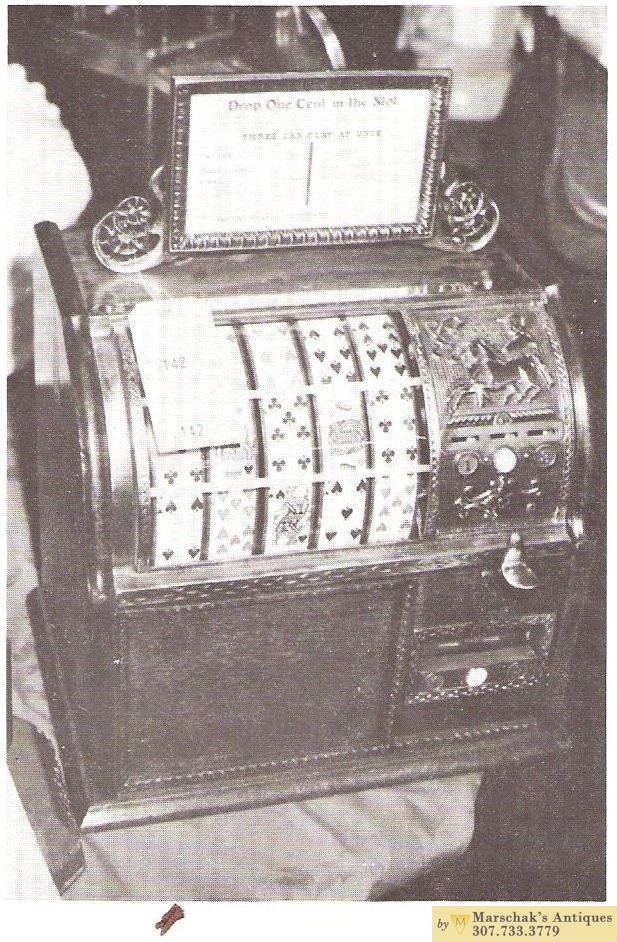
It’s easy enough to come to the mistaken conclusion that most of the slot machines in use at the turn of the century were the big floor model color wheel machines as shown on the previous pages. But that’s wrong. There were always far more counter machines around than floor machines, mostly because there were many more locations that could handle them. Unless you are a counter machine aesthete that specialized in these early wooden case machines, or just got lucky and found one or two, you probably won’t see many of them that were made prior to 1900. But around that date the machines began to take off, ultimately leading to high production figures and the eventual replacement of the floor-model color machines.
One of the earliest and most popular forms of counter-slot machines it goes back to 1889 was the “Card Machine” in which five reels display a poker hand. Payouts were over-the-counter in “Free Cigars” although they were just as often made in drinks or cash. They started out small, but got bigger and bigger. The Mills JOCKEY (not to be confused with THE JOCKEY, a floor machine adaptation of the OWL) is a classic Card Machine, available as a counter machine or on a matching pedestal. [t has a big, wide window over the reels large enough to show three rows of poker hands, backed up by three coin chutes. Up to three players could play against each other, or one player could play against the house. Quite a number of the nickel play machines exist, with the penny machines much rarer. They are well liked because of their fine wooden cabinets and elaborate castings. A typical serial for a machine produced in 1902 is No. 1780. The Mills machines are the best known, although JOCKEY was first made by the Chas. Molitor Novelty Mfg. Co. in January, 1900, and starting in 1901, by The Automatic Machine and Tool Company, both of Chicago. While most collectors feel that the JOCKEY is strictly a Mills machine, some may be surprised to learn they have a Molitor, or an Automatic Machine model, thereby a rarer machine. Automatic Machine even made a counter-top MUSICAL JOCKEY with a Swiss music box in a taller cabinet, but none of these have shown up yet.
The JOCKEY was a steady seller for Mills for years. In 1928, in order to reduce the production cost, Mills redesigned the cabinet, creating an uninteresting boxy machine with a single aluminum race track casting on the front. While still very collectible, it’s not as prime as the earlier model.
Mills JUDGE Floor Machine
Produced between 1899 and 1917
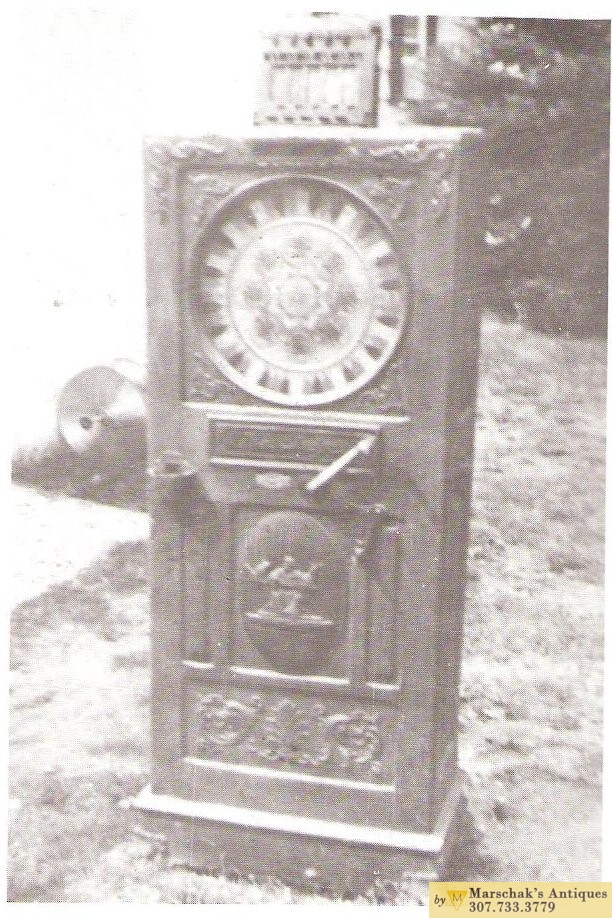
A lot of collectors believe that the JUDGE is an original Mills machine name. It isn’t. The first JUDGE was made by Caille-Schiemer in Detroit in the Fall of 1899 as another 6-way machine, with the name coming from the masthead of a humor magazine, just as PUCK had. But H.S. Mills was known to copy a thing or two himself, and it was only a few weeks after Caille-Schiemer announced their new machine that Mills put his own 5-way JUDGE on the market. It wasn’t long before the name was practically all his own.
The Mills JUDGE is virtually an OWL in judicial clothing, coming out two years after the original OWL as a further development of the same basic machine. There are almost as many JUDGE machines around as there are OWLS which attests to its location popularity. Together, the Mills OWL and JUDGE followed the same pattern of development. The early models had a somewhat complicated coin head, later replaced in the IMPROVED OWL and IMPROVED JUDGE with a coin head patented in 1898. There is a profusion of models with changes in the cabinets and glass, with at least three different castings of the coin head known to exist.
Mills promoted his machine as “The only original and genuine Judge” in the early 1900’s. By that time he had to, for the name had been picked up by many of the floor machine producers, with most of the machines being made as 5-way OWL developments. Mills made his own developments such as the DUCK and THE JOCKEY, similar machines with new dials and cabinet trim, starting with serials in the 9700 range. The JUDGE was also made in check play and musical models, the latter in the early 1900’s, with the ultimate development of the line known as the OWL AND JUDGE TWINS, a double that put the companionable machines together to combine nickel and quarter play. Find one of these and you’ve got a rare bird.
Because there are almost as many Mills JUDGE machines around as OWLS, it suggests that just as many JUDGES were made as were OWLS. On the surface, that seems illogical logic often plays an important part in finding old slot machines, as well as tracing old machine histories so the answer must lie elsewhere. What may have happened is that Mills, and other producers, lumped their OWL and JUDGE production together because the machines were virtually alike, often using the same works and cabinets. If that’s the case, that fabulous ten thousand production run of ills OWLS might well have included OWL. JUDI DUCK, JOCKEY and other machines that have.
Mills LIBERTY BELL Bell Machine
Produced between 1907 and 1909
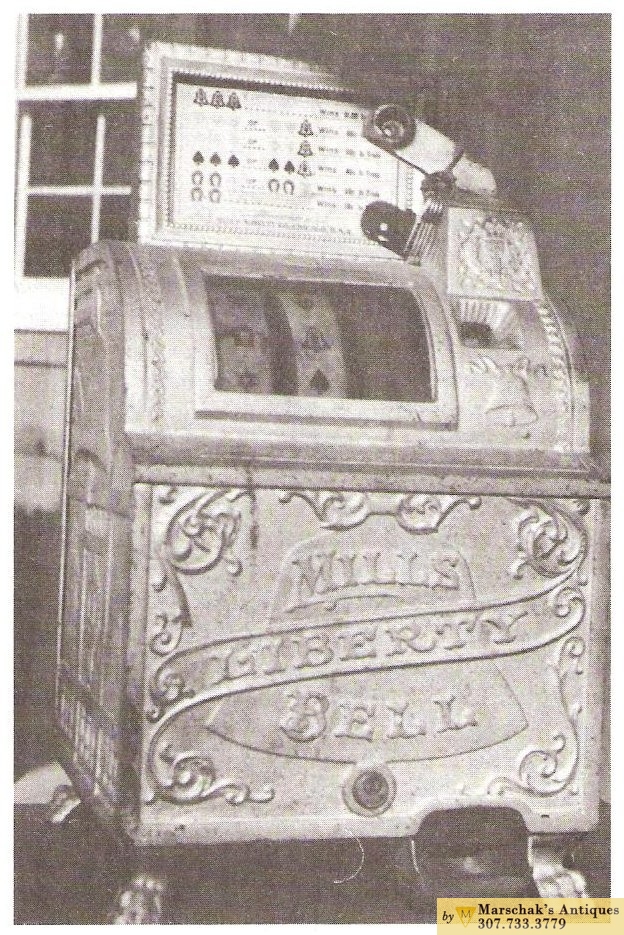
After the publication of the first volume in this series of price guides there was an antique slot machine information explosion. Everybody likes to tell the writer what was done wrong, so they did. A lot of knowledge was added. While the added data about most machines was movement in the right direction, the plus knowledge picked up on the Mills LIBERTY BELL was a massive gain. What had been thought to be three or four model variations between 1909 and 1916 based on old Mills catalogues and advertising turned out to be dozens of models between 1907 and 1918. The models may be similar, but the differences can practically make up a book. They have, in fact. The Coin Slot Guide series of historical books and maintenance and repair manual reprints includes Guide No. 29 for the Mills LIBERTY BELL/OPERATOR BELL and covers all of the “Iron Case” models and their mechanisms. They’re astounding, and different.
You can only touch the high points in illustrated price guides such as these, as miniscule model variations often make little difference. Not always, of course, but in the case of the Mills LIBERTY BELL this is generally true. But major differences can often have a heavy impact on model desirability and value. This Mills LIBERTY BELL of 1907 is a classic example.
The 1907 Mills LIBERTY BELL really is different. It has toed feet like the Fey LIBERTY BELL original and the long left leaning gooseneck. Compare this to the straight legs and horizontal slide coin head of the LIBERTY BELL in Volume 1, page 39 and you’ll see the differences right away. More subtle are the reels. That second generation Mills LIBERTY BELL in Volume 1 has the later Mills-type playing card reel strips with Spade, Club, Diamond and Heart card spots, colorful Jack, Queen and King face cards, Stars and Horseshoes. This machine is earlier, having the original Fey symbols of card spots only, plus Stars, Horseshoes and Bells. So you’re literally looking at the first Mills LIBERTY BELL of 1907 and soon thereafter, coming before the all-Mills card symbol LIBERTY BELL model of January 1909 on page 39 of Volume 1 and well before the Mills SPECIAL GUM VENDER of 1911 with its G-U-M symbol reel strips shown on page 74 of Volume 2.
Why did it take so long to pin down that 1907 date and the many model differences? Well, we all had to wait until people opened up and were willing to talk about their machines. Volume 1 did that, and opened the verbal flood gates. Once the pipelines were opened this is one of the machines that poured out.
Mills ON-THE-SQUARE Floor Wheel
Produced between 1900 and 1912
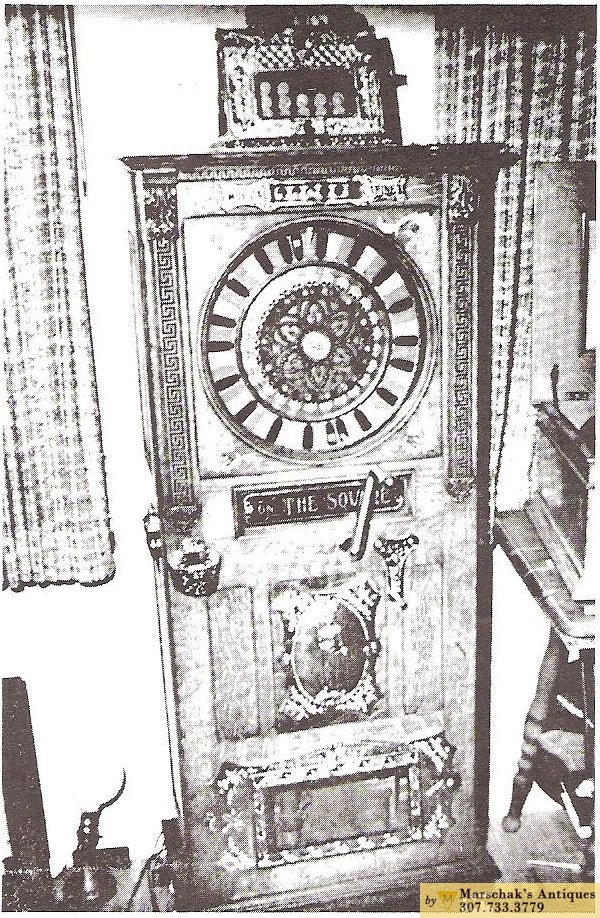
There aren’t a lot of Mills ON THE SQUARE floor machines extent, and it’s not really a popular machine. But to its owners it’s one of the most favored of all Mills automatic color wheel machines. Reason: it’s different. The Mills ON THE SQUARE is absolutely loaded with gingerbread carvings, castings, figures, a jazzy nameplate and a rich looking wheel. It’s the wheel that gives the machine its name. The basic idea is that the ratchet wheel and the stop arm are out in front of the wheel right where the player can see them. You play, and you see the mechanism work. What could be fairer, or more on the square? Get it?
Ha! You only think you see what’s happening. What’s really happening is behind the wheel where it should be. While the ON THE SQUARE looks as clean as a bean it could really be as crooked as an Irish walking stick, but only if a sharp operator wanted to make it so. There was enough mechanical latitude to screw around with the payouts, and one of the thrills of finding an old machine is discovering the ways the old codgers used to stick it to the marks.
According to Mills, in their promotion, the machine was clean. They use some nice words to describe the ON THE SQUARE in their 1902 catalog: “It shows the wheel and stop arm on front of the dial, thereby convincing the operator (meaning player) that the machine is not plugged, and is strictly `on-the-square,’ as its name implies.” The M. O. Griswold & Company of Rockford, Illinois, which also made the machine and made it before Mills did, so Mills obviously wasn’t adverse to copying a machine name or two used even better words in their March, 1900, advertising for their version. According to Griswold, their ON THE SQUARE had “no plugs, no kickers.” They added that “This machine will secure the best stands in your town.”
Seemingly, the ON THE SQUARE machines didn’t get anywhere near the stands, the more popular OWL, JUDGE, DEWEY, STAR, PUCK and other machines did, for far fewer of them survived. Maybe people liked to get screwed.
The Mills ON-THE-SQUARE can be found in four model variations: straight play (for nickels or quarters), check play, with or without music for both. The cabinet looks older than its 1900 date, as well it should. Mills originally made the machine as the STANDARD only one known to exist and changed its name to ON THE SQUARE after it had been on the market for a while as the STANDARD. As far as the Griswold version goes, it’s a plum, as none have shown up.
Mills OPERATOR BELL Bell Machine
Produced between 1910 and 1914

If any single machine created the slot machine boom of the teens, twenties and thirties, it was the old Mills “Iron Case”. It’s official name was the OPERATOR BELL and it was the first in a long line of Bell machines with fruit symbols that are most sought after by collectors.
The Mills OPERATOR BELL was a re-engineered LIBERTY BELL created for the heavy play that the earlier model had initiated. It’s name was it’s own advertising. It was a Bell machine made for operators, a new form of independent business man that owned machines, placed them on locations on routes, and split the take historically 50/50 with the location, replacing the location machine ownership of the past. The operators started calling the new machine the “Iron Bell” or “Iron Cabinet Bell” but settled on “Iron Case”.
The idea of fruit reels was created to beat the laws. Caille started it with it’s “GUM” reel copy of the Mills LIBERTY BELL, with symbols showing strawberries, grapes, pears, apples and crowns. A gum vending attachment was made part of the machine so that a nickel played was a stick of gum paid, plus any lucky winner. H. S. Mills was far more pragmatic. He packaged a stick of gum called “Liberty Bell Fruit Gum” and substituted less complicated fruits for his card and owl symbols to denote the flavors of his Bell Fruit gum. He copyrighted the symbols in 1910, but soon everyone was copying him. The gum idea started out right, with gum vender side attachments, but soon the feature was dropped from the straight gambling machines while the fruit symbols stayed.
There are quite a number of cast iron cabinet variations of the “Iron Case” with LIBERTY BELL and OPERATOR BELL graphics applied in a number of ways. Watling made a virtual duplicate of the Bell machine while Caille Bros. matched Mills model for model with a somewhat more refined cast iron cabinet. The Mills serials seem to start in the 6000 range with a 6356 a typical serial for a machine produced in 1910. By 1911 the serials had reached 8860, and by 1912, a typical number was 17208. These were straight line numerical serials in the “MLB” (for “Mills Liberty Bell”) series starting with the very first Mills LIBERTY BELL of 1909. The numbers were applied in numerical order to any Mills Bell mechanism. They’re still in use, with recent Mills Bell O Matic mechanical machines running serials over 600,000.
The “Iron Case” was made until the end of 1914, when it was replaced by the newer Mills oak cabinet.
Mills OWL JUNIOR Counter Machine
Produced between 1899 and 1912
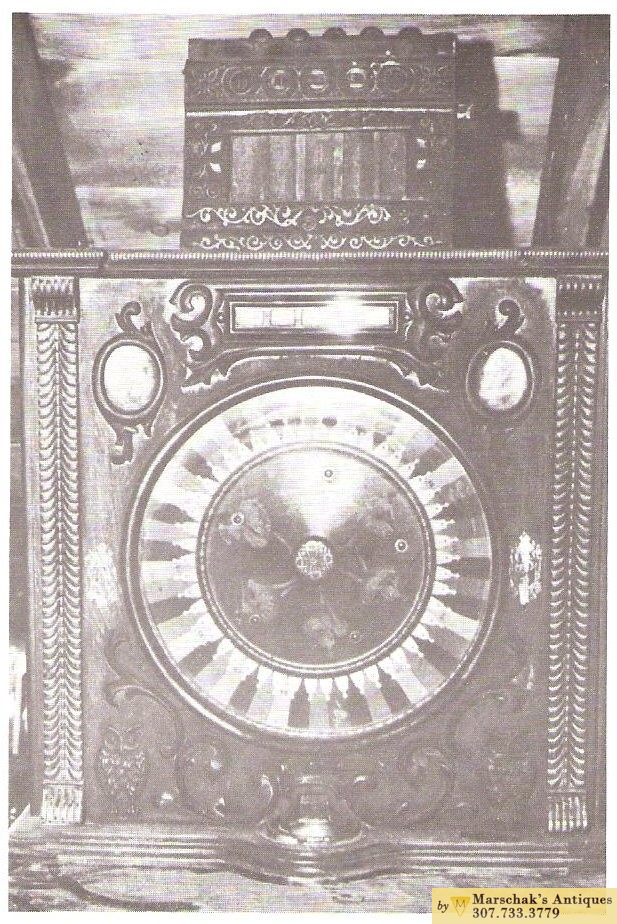
Slot machine development has had a confusing back and forth and back history, mostly because the machines were very faddish. The original mechanical color wheel payout machines were counter machines with runways to hold the payout coins. They jammed all the time. It was to get away from this, and make something bigger, that Mills made the OWL, with winners sliced out from a payout tube. Mills also made a 5 way counter machine about the same time called the KLONDYKE, named after the then current gold strike. While popular, it was the OWL that boomed the business. So Mills put the OWL coin head on the KLONDYKE and called it FANCY KLONDIKE, quickly changing the name again to OWL JUNIOR to capitalize on the name popularity. In three short years the development had carried the slot machine from the counter to the floor and back to the counter again.
OWL JUNIOR also sported a new cabinet with carved OWLS all over it. Mills popped it on the market in the Spring of 1899, calling it “a chip off the old block”, adding that “it does all that the Owl Sr. will do except sit on the floor and look big.” Later on, as the coin head was changed and the payout tube improved, the machine was reissued in a much plainer cabinet as the IMPROVED OWL JR. The original machine was only made for nickels, while the new model was made for nickel or quarter play.
The original OWL JR. counter machine had serials in the 6100 series, with later models running much higher. A matching pedestal was also made for the machine but few of these seem to have survived. OWL JR. also paved the way for a bunch of Mills automatic color wheel counter payout machines, ending up with the BROWNIE. An export model of the counter OWL was also produced for Italy and the continent as CIVETTUOLA or “Little Owl.” The coin head was a lot different, and much flatter. Most collectors aren’t hip to foreign machines you can’t get the coins to play them but a CIVETTUOLA would sure look nifty next to an OWL JR.
Most of the OWL JR. machines in collections have been unearthed in the last five years or so. It’s amazing how knowledge begets machines. Hardly anyone knew what an OWL JR. was or what it looked like until a Mills Novelty Company catalogue of 1904 was reprinted in the early seventies. With that, OWL JR. machines began to show up in modest numbers, as well as other machines in the reprint catalogue. The recent rash of rare catalogue reprinting may well have the same effect on future finds. If you know what something looks like, you’ll know what to look for.
Puritan (Mills) PURITAN
Produced between 1905 and 1933
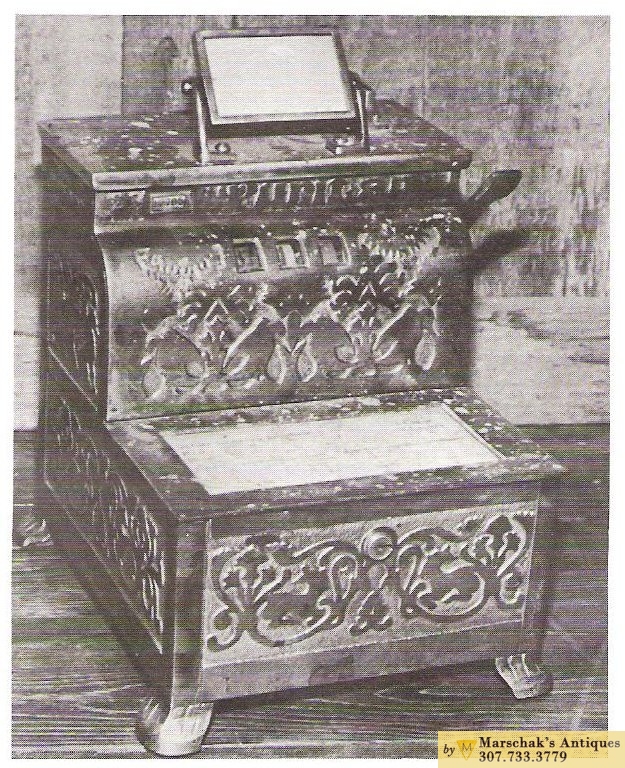
If any trade machine can be said to be the most significant ever created, in a developmental and historical sense, it is the Puritan PURITAN. That isn’t a redundancy. The machine was created in 1904 and manufactured by the Puritan Machine Company, Ltd., of Detroit. Its neat cast iron good looks for its day and very early use of three reels with number symbols wasn’t the prime reason for its success. That credit goes to a mechanical gimmick whereby every fifth or seventh coin the setting was made by the operator was tossed into a separate cash box inside the machine. The operator could use this extra cash box as the merchant split, either 20% or just short of 15%, or let the pot pile up as a “Pool” or “Jackpot” to be paid to the lucky top winner player instead of a box of cigars.
The Puritan machine was so clever, Mills Novelty Company bought or borrowed it and started producing it as the Mills PURITAN. By 1907 Mills was making it as the IMPROVED PURITAN with larger number symbols and cabinet improvements. The problem was that Caille Bros. did the same thing, making an almost identical small symbol machine as the PURITAN and an equally similar larger symbol version as JUMBO PURITAN. They must have sold a lot of them for a typical Caille PURITAN serial number is 5327. Caille Bros. carried the idea even farther than Mills by adding a token payout version sold as the CHECK-PAY PURITAN, giving the player a token saying “Good for 5 cents In Trade” (Token collectors call all similar tokens “Good Fors”) plus a chance at a greater return on the number reels. Watling also made it as PURITANO, and Silver King called it the SQUAW.
By the middle twenties Mills recast the iron case in aluminum and, just as the name “Perfection” had become synonymous with the smaller counter card machine, the name “Puritan” came to denote any small three-reel counter trade machine. In effect, it was the first of the modern counter games.
The fact that the PURITAN had three reels led to another new lease on life for the machine. In 1926 Mills redesigned the small machine, producing it as PURITAN and as PURITAN BELL, the latter with the same fruit symbols as the larger automatic.
Mills ROULETTE Floor Roulette
Produced between 1901 and 1916
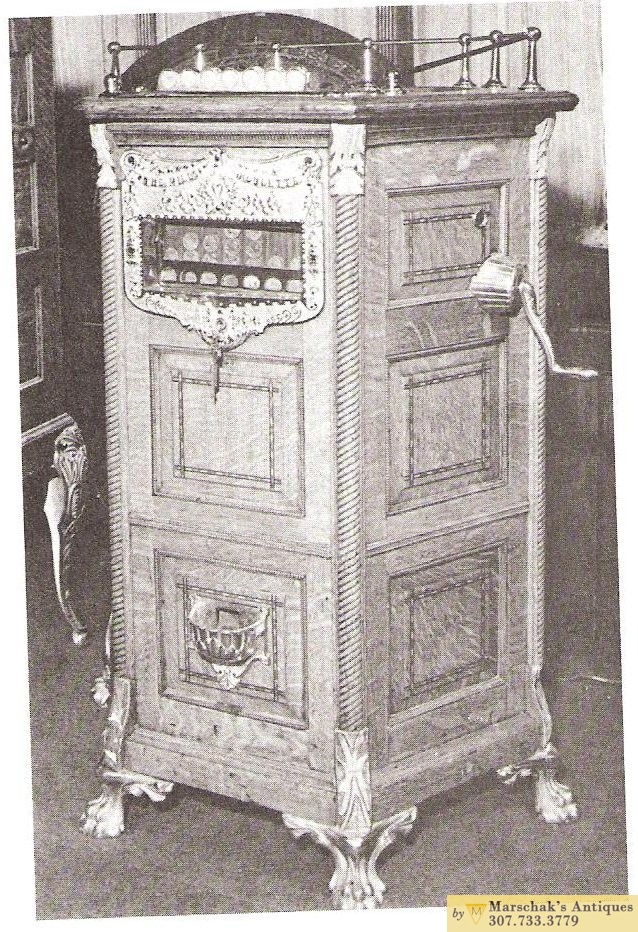
The Mills ROULETTE may just be the most underrated antique slot machine of all. But it’s hard to tell because the few existing machines never make it to the open market. They aren’t for sale, and so far only one has made it to an auction. So there’s been no easy way to establish a price.
The pricing is based on the Caille ROULETTE and PEERLESS values because the only time there was a flurry of selling and buying of these machines almost a decade ago they traded for the same amount the Cailles’ did. But that was a long time ago, and who knows what the Mills ROULETTES would go for if a number of them were put on the block today.
Some people regard this as the prettiest floor model roulette machine because of its almost stark simplicity. Mills engineered the machine from scratch and as we already told you used the mechanism for two machines; the Mills 7-way ROULETTE and the Mills 8-way TWENTIETH CENTURY. There are some other interesting design points. The Mills ROULETTE has a six-sided cabinet that literally encases its mechanism tightly like a pair of panty hose. The Caille machines, which came later, avoided this design problem and made maintenance a lot easier by providing a roomy 8-sided cabinet. Mills even redesigned their ROULETTE in 1904 to get around some of its very real over-engineering problems, although the newer model doesn’t look much different.
Three Mills ROULETTE machines are known for sure, plus a fourth in the hands of a penthouse-dwelling New Yorker who doesn’t even collect slot machines. He just likes it, and won’t sell. A fifth one surfaced in Chicago in the spring of 1969 when someone named “RR.” wrote to the “Action Express” of the Chicago Tribune and said; “I have an Automatic Roulette machine which was manufactured by Mills Novelty Company of Chicago in 1905. After four years of trying to get this repaired I’ve given up. How about you?” The “Action Express” editor told the writer that he (or she?) was in real trouble with an old slot machine and suggested that “you call the Attorney General’s Office and ask about the procedure for unloading the damaging evidence”. Over the years your author has tried repeatedly to find out who “RR” is or was, but the editors won’t budge. Can’t you see that Mills ROULETTE ending up in the Chicago office of the Attorney General and finally in a dump somewhere? So just tell me what dump. We’ll all bring shovels.
Mills SCARAB Counter Roulette
Produced between 1914 and 1916

Here’s another very rare Mills machine that has a unique double history as a machine and as a collectible. Interestingly, it dates from the same period of time as the BROWNIE/SILVER CUP. Its collectible history started in 1975 when a coin machine trade magazine called THE MARKETPLACE reprinted an old photograph that showed five men in bowler hats and pre WWI clothing playing a small payout counter roulette machine. It was described as “What looks like a Caille roulette type counter game.” Then, when Vestal Press reprinted the 1918 Mills catalog a re-produced letterhead listed a machine called SCARAB. With that the search was on. A lot of advanced collectors decided that the SCARAB, what ever it was, was a “Must have” machine, but no one knew anybody who had one. Collectors asked collectors “Have you ever seen a Mills SCARAB?” and the answer was always “No”! One day late in 1975 one collector asked another and the answer was “Yes”! Within a week thirty collectors across the country knew one existed, but not where. When the collector that seemed to know was asked again he said he knew of two of them, and with that one of the owners produced a photograph for the author. You see it here.
The big surprise was that the existing SCARAB is the same as the machine shown in the old photograph so obviously it is older than 1918. The machine is a marvel. It’s counter roulette with a free rolling ball. Pick a color, play by pushing the handle down, and if the ball stops in the right hole on the wheel you get an automatic payout of a token ranging in value of from a dime to a dollar, depending on the color you played. It’s real charm is its richly nickel plated cast iron cabinet loaded with casting detail and its name on front. Actually, the machine works just like the large floor model Mills ROULETTE, with all of that mechanical magnificence packed into a counter cabinet.
It took a while to confirm the device and date it through the discovery of pre WWI Mills paper, but in time that also showed up. A 1915 Mills advertising flyer found in the east described the SCARAB as “A fascinating Roulette machine that possesses all the good features of the ROULETTE. When the color corresponds with the color played, the player receives his reward.” The old paper illustrated both a plain SCARAB and a side vender model call SCARAB GUM VENDER. When the owner of the paper went to get it one morning to send to the collector who first said “Yes”! to the question of the machine’s existence, he found that the cleaning lady had thrown it out and burned it the day before. So the SCARAB remains elusive; both on paper and in real life.
Mills SILVER CUP Counter Dual Wheel
Produced between 1914 and 1916
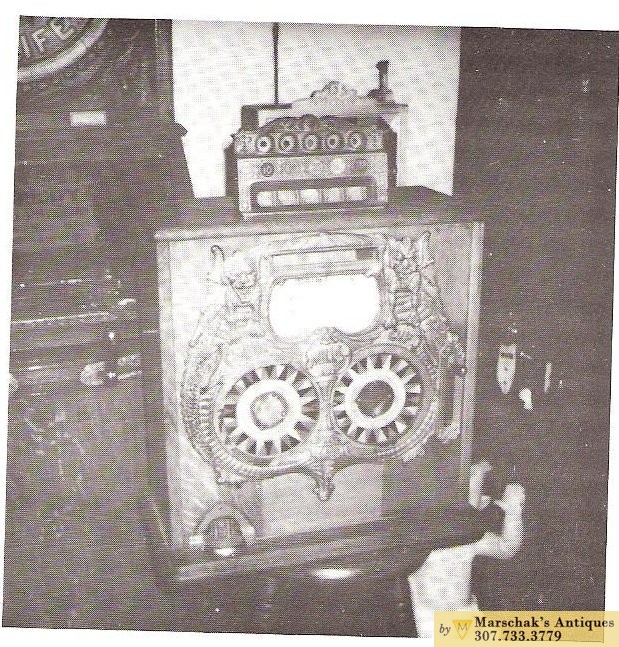
All antique slot machines have their history. Actually have two: their history as a machine and their history as a collectible. This Mills SILVER CUP has a wealth of both.
By the middle of 1975, when most knowledgeable collectors knew about the Mills BROWNIE and were just starting to get turned on by the cast iron Caille SILVER CUP after two or three showed up in a hurry, Collector Bill Krueger was approached by said he had a Mills not a Caille, but a MILL SILVER CUP. Krueger played it cool and didn’t jump right away, trying first to get some idea of the machine’s value. He quickly learned it was a heavy weight piece, so he locked up the deal and put it out for bids. No one knew what it looked like, but the assumption was it was a copy of the Caille which in turn was a copy of the Fey. Brooklyn collector Gold highballed the bid right away at $3,500. That was mighty big money back in 1976. When he got it, it wasn’t what he expected at all. It’s a big machine and a lot bigger than the Caille, In fact, mechanically it is a Mills wooden cabinet BROWNIE with a 5-way coin head and the power drive split to spin two wheels. The incredible part is the front castings; a large owl’s head, with the two spinning wheels the owl’s eyes. There’s no mistaking the identification. The casting says “Mills SILVER CUP!”
It was first assumed that it might have been an experimental model tested in Wisconsin. The Mills Novelty Company often did that. Any machine that showed promise was run off in a quantity of seventy or so, and then put out on location test to see if it worked and to see if people played it. From the very begining in the 1890s until Mills went out of the slot business in Chicago in the 1950s, Wisconsin was one prime testing grounds. No catalogs showed it, yet the serial number is 2802. That means a lot of machines but more likely it means BROWNIES.
Then Brooklyn collector Ira Warren solved the problem. He found an old 1913 Mills catalog, with the SILVER CUP in it. But when he got the catalog and reprinted it, the Mills SILVER CUP shown was a modified cast iron CHECK BOY with two dials, and nothing like the big wooden machine found in Wiszonsin. Bernie Gold told his story of the mystery a cataloged machine that doesn’t exist and an un-cataloged one that does to long time coin machine collector and historian Fred Fried in New York City. Fried replied, “You mean this one?” and produced a Mills advertising flyer from 1915 that showed the double-dial BROWNIE version.
Mills SPECIAL GUM VENDER Bell Machine
Produced between 1911 and 1914
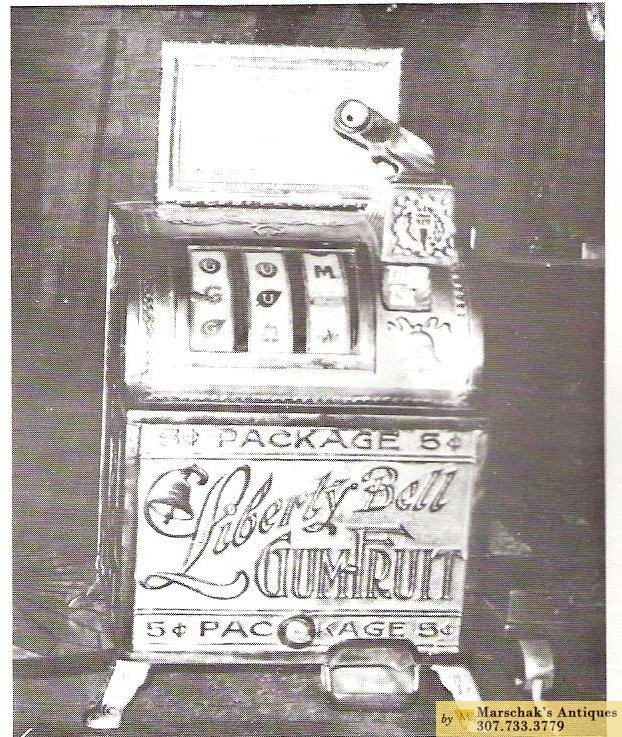
Anybody that has a smattering of interest in pay-out slot machines pays homage to the cast iron Mills LIBERTY BELL and OPERATOR BELL machines. Few will admit they don’t, and the machines have practically a universal appeal. Collectors often like to simplify things in their own minds, and many assume there was only one type of Mills LIBERTY BELL and one type of Mills OPERATORS BELL. Hang onto your hat; there were dozens. The format was so good Mills splintered the models in every which way possible in order to have one or more machines to meet every operating condition known or imagined. The variations in fronts, reels, goosenecks, reward cards and even in the cast iron feet are so numerous one wonders if we’ll ever identify them all. What’s been happening is that collectors that feel they know these machines well are often knocked for a loop when a new one shows up because more often than not it’s different than the ones they know.
The most desirable models among a dazzling array of highly desirable models are the machines that say “Liberty Bell” on the front casting. Many collectors assume that this front casting means that the machine is the Mills LIBERTY BELL, but it ain’t necessarily so. For instance, this machine. The front is super-graphic, acting as a billboard to promote “Liberty Bell Gum Fruit” (not “Bell Fruit Gum;” that generally came later). The reels say “GUM” and have an odd assortment of fruits as symbols, including a spear-mint leaf. In short, this machine doesn’t fit the normal mold associated with the Mills fruit symbol cast iron Bells. That’s because it really is a different breed of cat. It was designed to vend gum in 5 cent pack-ages, and was supplied with a side vender. That didn’t last long when the machine was put on location, and most of the machines that have been found are minus the gum vending attachment. Some don’t even have the drilled holes on the side that permitted attachment of the vender, meaning they started right out as straight cash payout machines, no matter what the front, reward card or reels say. The Mills description, dated 1913, calls it “the new much talked about Mills SPECIAL GUM VENDER (which) can be operated with either nickels or 5 cent size checks. The rewards are paid out in trade checks. Under favorable conditions the SPECIAL can, however, be readily converted into a cash-paying machine.” It would seem most areas where these machines have been found were, as they say, “favorable.” The machine illustrated was found in Hurley, Wisconsin, in 1977. It’s serial is 6,622.
Mills SUPERIOR
Produced between 1904 and 1916
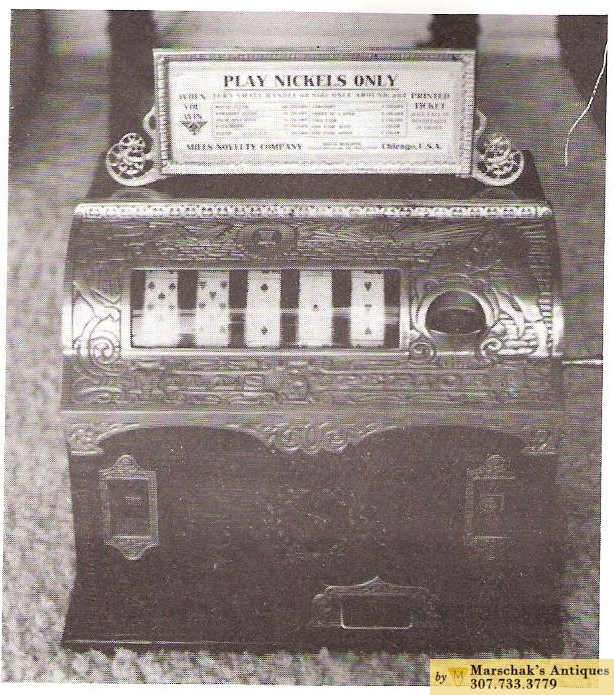
Many collectors regard the Mills SUPERIOR as the most elegant card machine ever made, if not one of the most beautiful slot machines ever produced. It is absolutely stunning! It’s hard to tell when you run across one in the basement storeroom of an old hotel building, or back in a weathered barn, or wherever else old machines like this are found, because the wooden cabinet is often black with filth and the nickel plated trim has tarnished to blackness. But careful cleaning, and a good job of restoration, brings out more wooden warmth and brilliant casting reflections than you’ll find on just about any other machine. As a result, the SUPERIOR is often regarded as the keystone machine in any trade stimulator or coin machine collection.
SUPERIOR has another exciting characteristic, as the machine is its own printing press. The reward card (which has been reproduced; it’s worth framing by itself even if you don’t have the machine) lists the awards in “Free Cigars,” from 1 to 100. With each winning play the machine advances a pre-printed fortune ticket from a roll, which is then rubber stamped with the number of the payout, be it one cigar, or 2, 3, 4, 8, 12, 16, 24 or 100. Most of the printed fortune tickets rolls are long gone, having run out years ago, so finding a SUPERIOR with its fortune tickets is a very exciting event. The original rolls had 1,000 fortune tickets, or enough “to provide for about 25,000 winning plays” according to the Mills literature. A quick calculation suggests that only one play out of twenty-five is a winner, which shows that the house wasn’t giving much away in those days.
The fortune tickets are interesting for another reason; each ticket is coded with the serial number of the machine in which it is to be used. Some of the known Mills SUPERIOR serial numbers are 210,250 and 260. SUPERIOR fortune tickets, if they can be found, can contribute to the machine’s history and help fill out the range of serials.
Mills TWENTIETH CENTURY Floor Wheel
Produced between 1900 and 1916
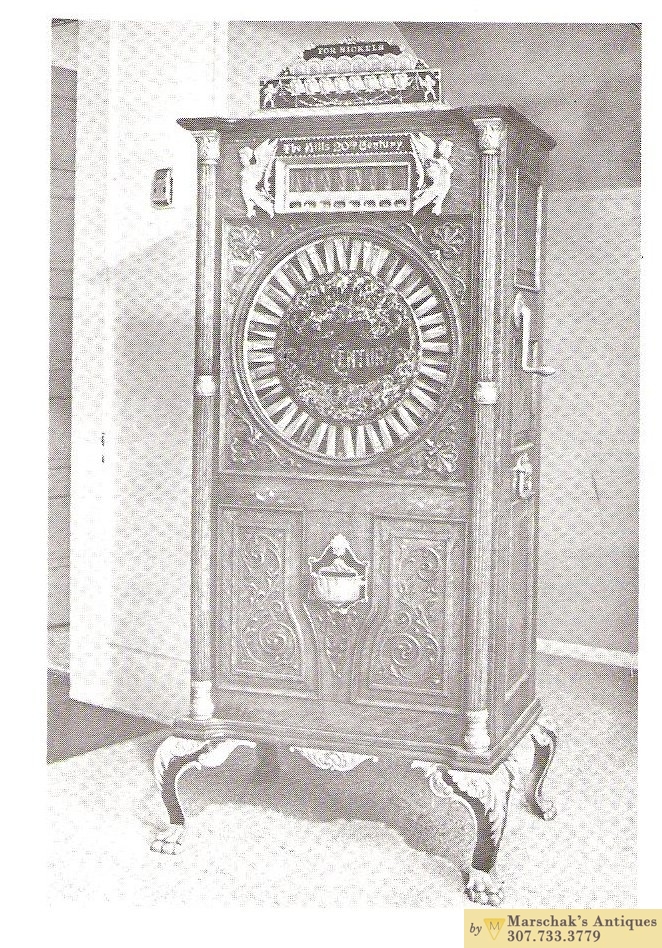
Talk about large and complicated machines; the Mills TWENTIETH CENTURY is right up there. It’s big, entirely different than anything made by anyone else, and prime collectible among floor machine enthusiasts and plain vanilla collectors. While it looks like an overgrown Mills DEWEY, it has an entirely different and far more complicated even though it has fewer parts mechanism, revealed by the fact that the handle is a crank set high on the right side of the machine. The mechanism is spring wound, with the charged springs working everything automatically. According to Mills Novelty at the time, the mechanism was the smallest and simplest of any large machine. Sure, if everything is in working order. But if the springs are rusted out or gone, you don’t know where the hell you are and have to restore by guess and by golly.
The TWENTIETH CENTURY (the nameplate says 20TH CENTURY, but it was often cataloged as the TWENTIETH CENTURY) was the Mills answer to the 8-way machines introduced by Caille-Schiemer and The Automatic Machine And Tool Company. It was obviously the most successful as there’s only one or two of the others still around. While not numbered high, there are quite a number of TWENTIETH CENTURY machines in collections, and they seem to pop up. Oddly, practically everyone is different suggestion a high proliferation of models or custom construction of each one.
The machine was Mills Model 5, and 5M with music. The standard model was 5 cent play, but Mills also made a 20TH CENTURY CHECK, for check play and pay, as well as 25 cent, 50 cent, and $1.00 models. The 50 cent and $1.00 models had a 5-way coin head because the coins were so much bigger.
The neat thing about a TWENTIETH CENTURY is its payout, because the coins are sliced and spit out one at a time. When you hit a top one hundred coin payout on a TWENTIETH CENTURY you’re in for the mechanical thrill of your life. Chunk, chunk, chunk, chunk, and on and on. Imagine that blast of noise in an old saloon; it’s enough to sober up the soggiest drunk in the joint.
A while back there used to be a TWENTIETH CENTURY at most auctions, and they didn’t seem particularly rare. But that seems to have changed, making those available on the open market few and far between. Does that mean that the collectors are holding on to their TWENTIETH CENTURY machines and that its price level is a mystery because not enough have gone on the block to establish a price? If that’s the case, the Mills TWENTIETH CENTURY just might be one of the most underrated machines around.
If you think the TWENTIETH CENTURY is big, you ought to see it as a double. Mills made them, and there’s one or two or more around. But one wonders how a bank of these machines were set up as singles; that handle on the side is ackward.
Mills YOU’RE NEXT
Produced between 1900 and 1908
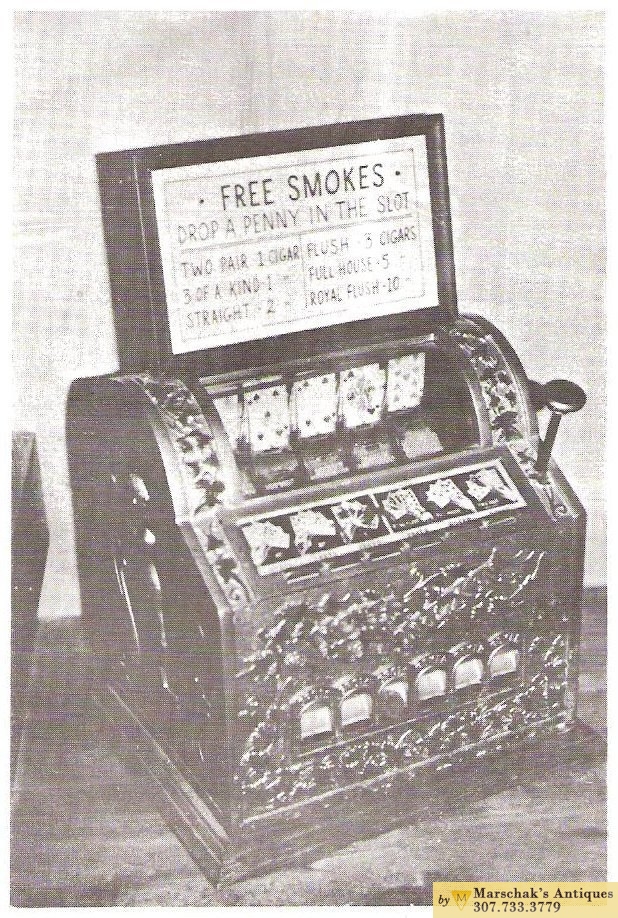
Although their appearance may seem to be incredibly ancient to modern day coin collectors, the card machines that flipped actual playing cards they were called “Card Exhibiting” machines enjoyed a streak of popularity that lasted a quarter of a century. Their five-reel developments in which the cards were either pasted or printed on reel strips lasted even longer. In the main, however, the card exhibitors based on the original Sittman & Pitt MODEL CARD MACHINE were made by more than a dozen small producers across the country, disappearing by World War I, while the reel machines slowly but surely took their place, going fairly strong until World War H.
The major manufacturers tried their hand at both, with the Mills YOU’RE NEXT clearly demonstrating the line of development. The machine started life as the Canda AUTOMATIC CARD MACHINE, and was obviously picked up by Mills when Canda went kaputt. There were a number of other Mills machines that were very similar, including one called KING DODO that had 5-way play so up to five coins could be played at once, a very early approach to the multiplier slot, machines of the present day. The KING DODO cabinet is ornately cast in iron and nickel plated or oxidized, the latter a rich looking copper like finish. The LING DODO name is in script in the casting.
The YOU’RE NEXT machine goes even farther, for it has six coin slots and beautifully artistic illutrations of fanned poker hands over each slot, an idea picked up from the original Canda machine. The real treasures on machines like these are the reward cards, but unfortunately they are often missing with collectors often substituting their own. The recent availability of reproduced reward cards from this period will go a long way toward sprucing up existing machines.
YOU’RE NEXT came in penny or nickel play and has reward cards for cigar or cash payouts. The serial is stamped in its wooden base. All of these machines are rare, with KING DODO models the rarer.
WATLING

Watling BIG SIX Floor Machine
Produced between 1903 and 1916
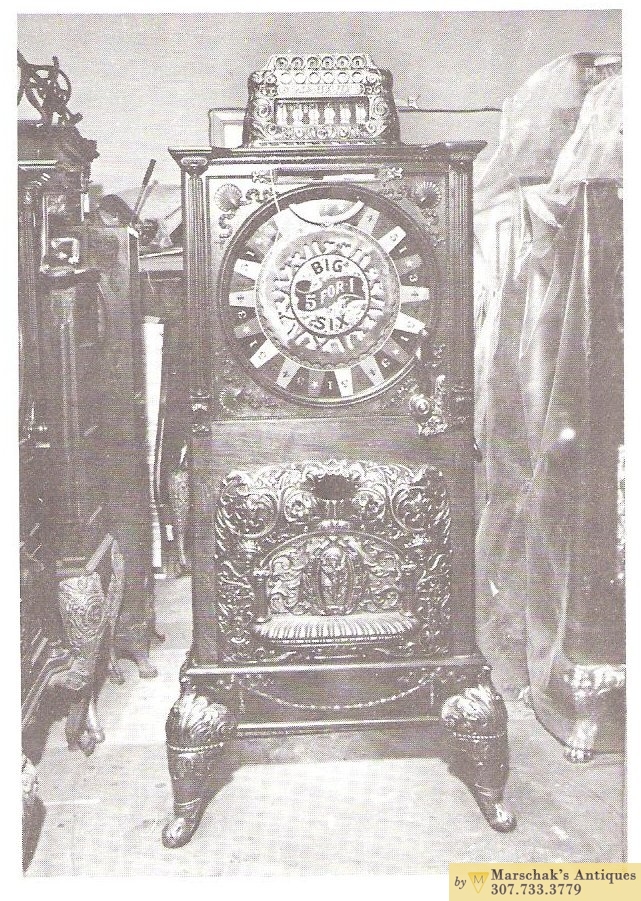
It’s time to give the Watling Manufacturing Com-pany the credit it deserves for producing some of the best looking floor machines ever made. The Watling color wheel and pointer machines made after 1902 had a look of sturdiness and elegance rarely matched by other producers, and only the Caille machines had greater flash. One of the best looking and most de-sirable is the 6-way Watling BIG SIX, a large floor model with thirty-six color stops that each pay 5-for 1. All you have to do is pick the color that wins out of six colors. The machine was made in nickel, quarter and half-dollar models. One of the exciting features of the machine is that the payouts are loud and slow with the coins spitting out one at a time as they are sliced out of the payout tubes.
Caille Bros. also made a BIG SIX machine, but it is the Watling model that is better known. The Wat-ling coin heads are also distinctive, having a rounded bulky look all their own as opposed to the boxy and straight-sided Mills’ heads and the very elaborate Caille Bros. heads. The Watling glass is also distinctive, having a bold silvered look. The Watling BIG SIX seems to have been a popular machine, probably because a return of five coins vs. six colors looked easy to beat compared to the sixty-stop and hundred-stop models of other machines. Nothing could be further from the truth, for the player was always facing five to one odds for every coin played.
The BIG SIX was made in a musical model, as well as a nickel or check-play gum vending model that had a vertical gum vender attached to the side. But the most dazzling Watling models of all, and the ones unmatched by any other producer, were the Watling BIG SIX SPECIAL and FORTY-FIVE SPECIAL. These machines have clear glass in their upper cabinet side panels and a mirror on the inside of the back panel so that the player can watch every action of the reflected mechanism after a coin has been played. Three FORTY-FIVE SPECIAL machines are known to exist, showing up in scattered parts of the country, east to west, so it must have been a popular saloon machine in its day. its day.
The FORTY-FIVE was Watling model No. 14, and the FORTY-FIVE gum vender Model No. 36, so it gives you some idea of the prognosis of Watling machine development.
Watling DERBY Floor Race Game
Produced between 1911 and 1916
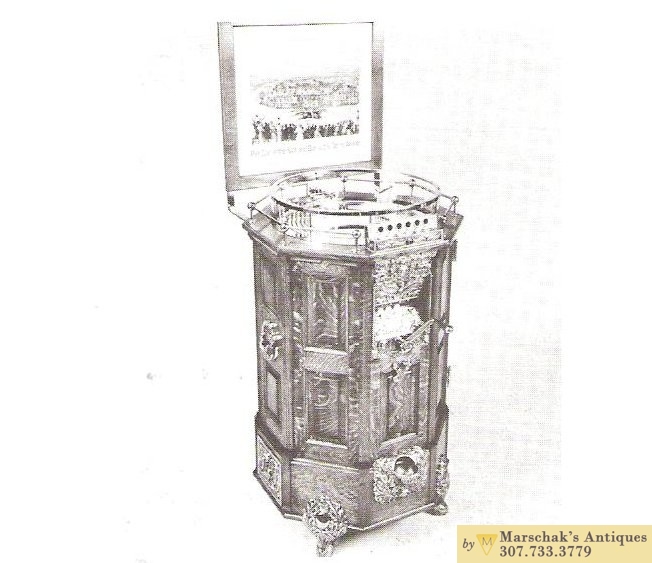
It is said that this is the most valuable antique slot machine in the world. It probably is, and should be, for a lot of reasons, not the least of which is its beauty and playbility. But its intrinsic value goes far beyond that for the Watling DERBY you see here is the fulfillment of a single collector’s dream. It’s a super story.
Back in January 1969 Bill Gersh, editor and publisher of The Marketplace, a coin machine industry newsletter read by virtually everybody in the business, ran some historical pictures of Caille and Watling slot machines that he had in his personal collection. Gersh had been a coin machine reporter, advertising man and columnist since 1929 or thereabouts. The Watling piece he reproduced was from an old advertising flyer given to him by old Tom Watling himself in the early 1930s. It showed a fantastic token payout floor machine called the DERBY. Gersh dated it 1898.
Just about that time budding coin machine collecter Burton A. Burton of Pasadena, CA, was just starting to upgrade his collection from gum machines to heavyweight slots years before they could legally be collected. A smart cookie, Burton put down his $25 ( big money for a collector in those days) for a subscription to The Market-place to get closer to the business and look for machine leads. He saw the DERBY picture and knew he had to have the machine. Except there wasn’t one. No one had every seen such a thing.
But Burton, just about the best early tracker in the hobby, refused to give up. As luck would have it, in that same year of 1969, Burton tracked down the aging but still interested John Watling in Chicago, the last of the coin machine pioneers. Among other things Burton repeatedly asked about the DERBY machine, getting no answers. Then, on one of Burton’s business and collecting trips to Chicago, old John Watling took him out to his brother’s semi-elegant walkup flat on North Pine Street in the West Side Austin neighborhood of the city (strangely, the apartment was on your author’s Austinite paper route as a kid; I remember the man) and produced a DERBY mechanism and one horse — and that’s all, no cabinet, coin head, cabinet castings or marquee. Burton was excited, but all he had was a bushel basket full of junk
Not to worry. By 1972 your author had found a duplicate of the old Watling advertising flyer showing the DERBY. The address on the sheet was 727-729 Jackson Boulevard in Chicago, plus the copy “Old No. 153-159 W. Jackson Boulevard” precisely dating the machine at 1911 as the Chicago street addresses were changed (to number streets on precise grid rather than using the meandering Chicago River as a zero-baseline which meant that 200 North on one street might be 600 North on another) in the summer of 1910. The DERBY flyer also
carried the Patent No. 870,473 which, when tracked down, proved to be a large countertop token payout race game with an elaborate 4-way coin head and operating crank issued to premier coin machine pioneer Gustav F. W. Schultze and the Schultze Novelty Company of San Francisco, California, on November 5, 1907 after Schultze applied for the patent on September 17,1906. At last some rudimentary coin-head-to-mechanism data was available, even though the later and larger Watling DERBY was a 6-way machine. In the meantime Burton had found an old racing print virtually identical to the one on the DERBY marquee in the old picture.
That really did it for Burton. As a Californian he had about 25% of a California-created Schultze machine upgraded by Watling. Now he wanted the rest. It became an obsession. In 1973 and 1974 Burton ran ads any and everywhere that current coin machine operators and vintage machine collectors might see them offering $1,000 for the cabinet alone. Then $2,000. By late 1974 your author had made a Business Reply Card direct mail piece for Burton showing the DERBY with the headline “$10,000 CASH For This Machine”. Burton sent out almost a thousand and didn’t get a single bite. That was the end of the line. Now he knew he had the only one known. Or a small part of one, anyway.
The rest of the story is incredible. Starting with nothing but that one old catalog picture, the patent papers and the racing scene print Burton commissioned Gary Taplan to restore — reconstruct literally — the machine. Alfred Gottfield recreated the castings and metalwork from the pictures and drawings, Gordon Entler produced a cabinet from the same sources, and Taplan served as the project chief and put it all together. Burton won’t say what it cost him, but it’s up there.
Watling DETROIT Floor Wheel
Produced between 1902 and 1912

There was a certain crude charm to the way the Watling Manufacturing Company did things. On one hand they loudly touted the fact that they made “the original and only” version of just about every machine they made, and on the other they copied the hell out of everything on the market. Sometimes it got ludicrous, as in the case of the Watling DETROIT, and other “City Name” machines.
The “City Name” machines are somewhat unique. There aren’t many, and the ones there are can almost identify the maker by the name of the machine. The idea started with the Specialty Manufacturing Company, the first maker of electric floor machines, located in Kala-mazoo, Michigan. Their first5-way machine, produced in 1896, was named the KALAMAZOO, with the name soon becoming a generic for 5-ways made by a lot of producers. The Rosenfield Manufacturing Company in New York City picked up on the idea and named their S-way electric the NEW YORK. When The Caille-Schiemer Company in Detroit made an exposed stop version of their original PUCK in 1898 they named it after the city of manufacture, DETROIT. Likewise, when the Mills Novelty Company of Chicago did the same thing with their DEWEY in 1900 they created the exposed stop aim and ratchet wheel CHICAGO.
These names didn’t go far away from home. Automatic Machine and Tool Company of Chicago made a CHICAGO, and the subsequent Caille companies in Detroit made DETROIT models. It ended there except for one glaring exception; Watling. Only Watling made them both, and only Watling had the audacity to claim to be “the original and only” maker of each machine. There must have been a lot of excitement and even law suits about that in the early 1900s, but that’s too long ago and too unrecorded for us to know the facts at this point in time. What we do know is that Watling, a Chicago maker, made a machine called DETROIT and that in itself is incongruous enough. The most nagging point about all this is that the Watling DETROIT ( even the Watling CHICAGO for that matter, see Page 64 of Volume 2) is so darn good looking it looks a lot better than the Caille-Schiemer and Caille-whatever DETROITS. The super color wheel and dial, rich ornate trim and classic Watling coin head make this DETROIT a machine to be proud of.
This, incidentally, isn’t the only Watling DETROIT. The firm started out in 1902 with a NEW CENTURY DETROIT model described as a “6-slot automatic paying machine without music”. They made it in 50, 250 and 500 play. The “New Century” part of the name was soon dropped with the coin head soon saying THE DETROIT in its front casting and shown in this photo-graph. It was produced this way for many years. An original Watling catalogue from around 1907 said the machine “needs no recommendation. It has proven its
worth and is still as popular as ever. We have built thousands and are still building them. It has front stop wheel showing it is on the square. Also fitted with automatic percentage device. Finished in an elegant quarter-sawed oak cabinet, neatly trimmed. Furnished with or without music. Built for nickel, quarter or half dollar play. Width 24in., depth 14 in., height 66 in., weight 205 lbs., boxed 290 lbs.”
Watling also coded its machines for telegraphed orders, with the “Without Music” DETROIT models called “Maple in nickel play, “Thorn” in quarter and “Birch” in half dollar play. The machine was also made in TWIN DETROIT and TRIPLET DETROIT models, making it a major component in the Watling line.
Lucky owners of later production machines will find a nameplate on the front of the cabinet that says: “Made by Watling Mfg. Co., Manufacturers of Scales and Slot Machines, 153 to 159 W. Jackson Blvd., Chicago, Ill., U.S.A.” That’s a strange place for a machine called DETROIT to come from.
Watling DEWEY Floor Wheel
Produced between 1902 and 1916
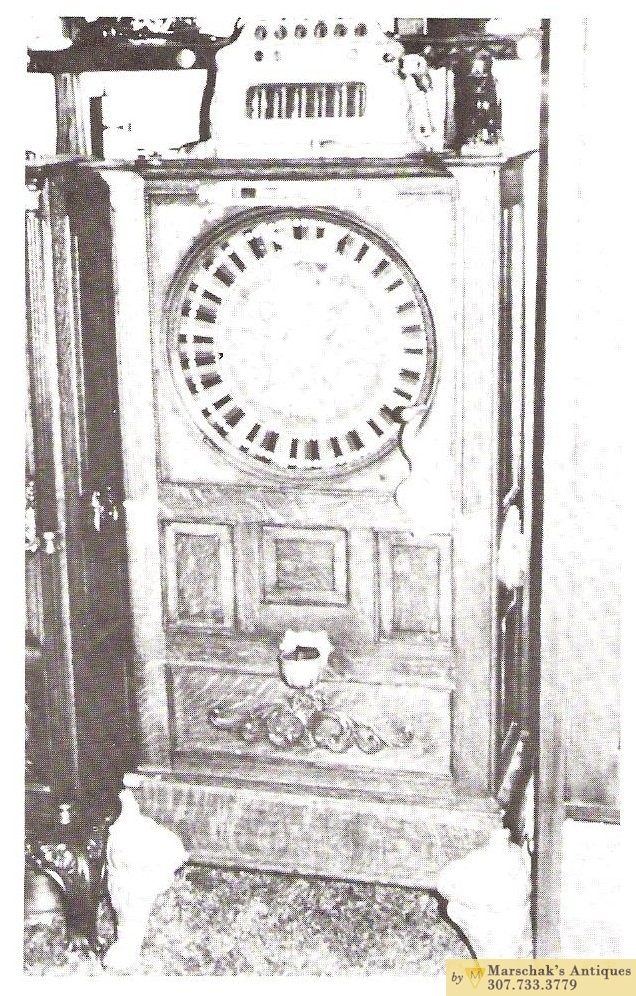
There are DEWEYS and there are DEWEYS. While most DEWEY floor machines were made by Mills there were certainly many others. A lot of them were smaller copy-cat machines, but some are as big and beefy as the Mills original, and equally desirable. Foremost in that class is the Watling DEWEY. It looks a lot like the Mills, but not quite. The legs are stockier and the coin .head is pure Watling. But it’s unique. There are nowhere near as many Watling DEWEY machines as Mills machines, so the collectors that favor unique pieces are prime Watling DEWEY prospects. These collectors will also have a machine with an interesting story behind it.
Watling carried their DEWEY copy a bit far, both in appearance and in claims. They were selling the machine in 1903 for $70 in nickel play, $80 in quarter play and $95 in half-dollar play, so you can see it was a higher priced item than the smaller Watling OWL and JUDGE machines. At the time they called their version the IMPROVED DEWEY to make it look like they did something better with it than Mills did. But they didn’t mess around with its looks. Old advertising for the Watling DEWEY shows it with a stars-and-bars shield design with Admiral George Dew-ey’s portrait in the middle, a straight steal from Mills. This fine touch has been lost over the years, for the surviving examples generally have clear glass if any, with the original smashed long ago.
By 1905 or so Watling was selling the machine as just plain DEWEY, but got nasty in their promotional copy. If you can believe it, here’s what the Watling Manufacturing Company said in a 1910 advertising flyer: “The Watling DEWEY. The old reliable DEW-EY. Everybody knows this machine, of which we are the originators and which has been imitated. But never equalled. The fact that others (read “Mills” for “others”) tried to copy it is the best proof of its worth.” Now where in the world would the Watlings get the audacity to say all that, and did people really believe them? Simple checking proves the claim entirely false. For one thing, Mills started making the DEWEY in 1899, and Watling wasn’t even formed until the end of 1901. Maybe they based their claim on a prior Schall machine, yet even Schall came after Mills in floor machines.
The inescapable conclusion is that they lied. So, they lied. It was a day and age when absurd claims and flat out lies were part of the norm (Old expression: “Play it straight. Lie.”). How business and advertising ever crawled out of that hole I’ll never know. Frankly, if you pulled a stunt like that today.
Watling EXCHANGE Counter Wheel
Produced between 1904 and 1912
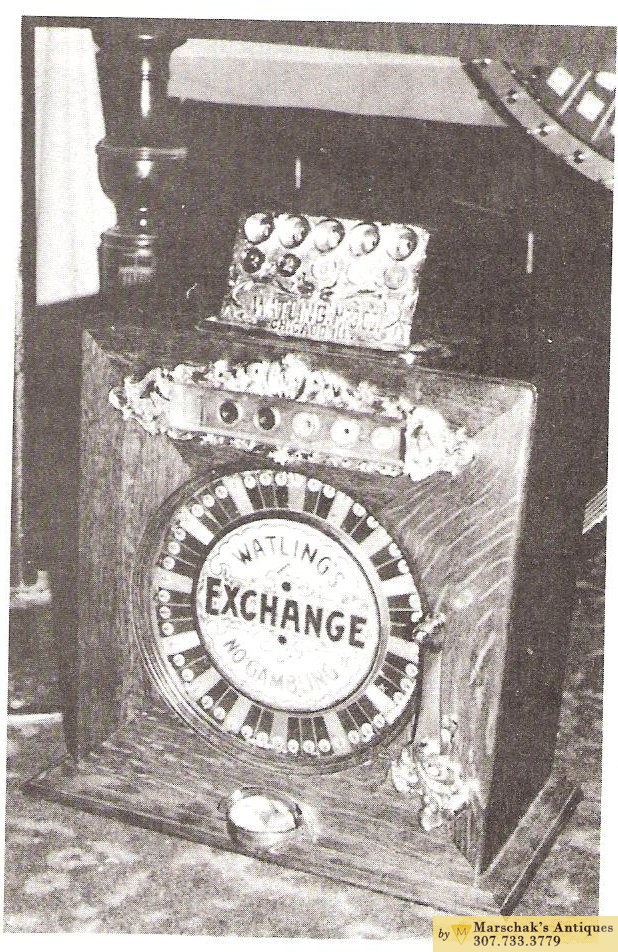
Exchange used to mean place of business, back then. Not exactly a store. More like a company store or a country store where you brought in one thing and traded it for something else, often just for the credit that gave you buying power.
It’s the perfect name for a slot machine, particularly one that takes in one thing and pays out something else. That’s just how the Watling EXCHANGE operates. It looks like any one of a number of 5-way gambling machines, from the Mills BROWNIE which is a lot bigger to the Caille BEN HUR, which is just about the same size. In fact, it’s easy to confuse the Watling EXCHANGE with the Caille BEN HUR. But they are a lot different, for the BEN HUR is a straight cash-payout gambling machine. Not so for the Watling EXCHANGE, for if it’s anything it’s really an automatic payout trade stimulator. Even its glass —when it is intact says “No Gambling”.
So why put a “No Gambling” machine in with automatic payout slots? Because that’s where it belongs, no matter what the payout or what the glass says. All that stuff about being an exchange, and no gambling. was a lot of baloney. True. the payouts aren’t in cash they’re in trade checks or tokens for 100, 250, 500 or $1.00 but this is a coin-op chance machine pure and simple. It’s a 5-way. so you pick your color or colors and play your nickel or nickels. If you lose, that’s it. But if you win, you win “exchange” in the form of the trade checks. Five separate payout tubes in the back dispense the proper tokens. Oftentimes the location, be it a store or a cigar counter ( EXCHANGE was basically not a saloon machine), would have its name on the tokens, with “Good For 50 In Merchandise” or other cash-in or exchange values indicated. So if you win,you buy. A typical machine serial is 1.132 so they must have made a lot of them.
The Watling counter wheel machines are sought after, with their remarkably colorful glass and elaborate coin heads reason enough for their popularity. Typically, this EXCHANGE says “Watling Mfg. Co./Chicago, Ill. on the head with the Watling name also on the glass. There’s a whole family of these machines: EXCHANGE, LINCOLN, JEFFERSON, JACK RABBIT and others, but only the EXCHANGE is a trade machine with tokens. The others are coin payouts.
Watling IMPROVED CHICAGO Floor Wheel
Produced between 1902 and 1911
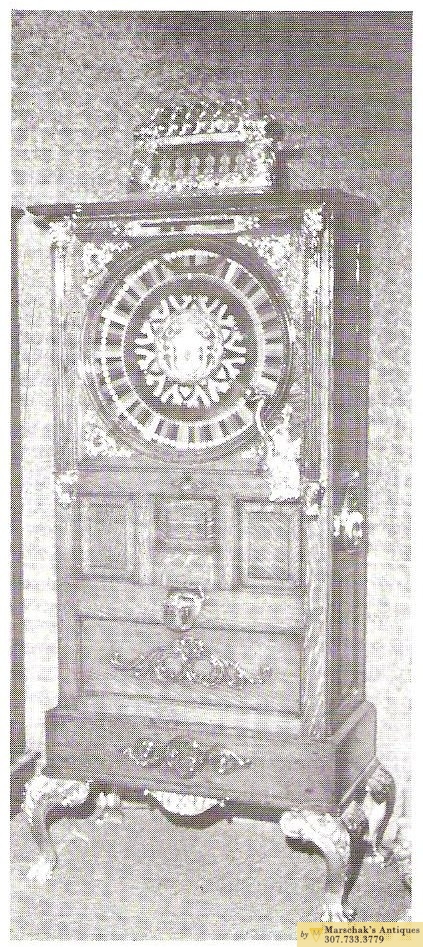
We’re back again with another Watling ripoff of a Mills machine, yet the machine looks so good you have to wonder if you’d rather have the Watling IMPROVED CHICAGO or the Mills CHICAGO original. The Watling name is its own tip off to the fact that the IMPROVED CHICAGO is a copy-cat. Improved means better than what has been or currently is, and newly formed Watling certainly didn’t make a CHICAGO machine before their IMPROVED CHICAGO. Thus, the name suggests an improvement or somebody else machine. Who else but Mills?
The points of comparison with Mills narrows down with the Watling IMPROVED CHICAGO. The cabinet, legs and trim are Millish, and at first glance only the Watling coin head sticks out as really different. A careful look will reveal a lot of other difference, but the front glass won’t help. It has the Chicago “I Will” lady in the center just like Mills does, although the base relief casting of this Grande Old Gal isn’t on the front of the machine. Sorry loss; look at all the tough language she missed in the saloon locations that ran this machine.
Pricewise, the Watling IMPROVED CHICAGO cost even more than their DEWEY did, with 1903 costs at $75 in nickel play; $85 in quarter and $100 in half-dollar play, adding $20 to each price for music. What collector wouldn’t be glad to peel off a century note from an auction budget right now for this thing. But if you look at it reasonably, that’s really not so cheap. The dedicated investor collectors feel that their machines should increase in annual value at a rate in excess of the amount paid in pure interest in a bank. Therefore, if you take the initial cost of this machine at an interest of 10% annually, compounded, you’ll get a fair idea of what it’s really worth. If you take it from a purely financial point of view it comes to over $60,000. Yet, today, it sells for less than a tenth of that. A lot of collectors feel their machines are a much better investment than diamonds, land or common stock. But are they, really? The real jump has come in the last four or five years, and only since then have they become the hot investment property they are today. For instance, if you bought the Watling IMPROVED CHICAGO for $1,000 in 1970 which was a fairly standard price for a floor machine at the time, if not on the high end it would only be worth about $2,500 today. See what’s happened? It sells for three times that much on the market, and I can’t think of any investment that has done that well in the past few years except maybe a house.
Watling JACKPOT Floor Wheel
Produced between 1904 and 1906
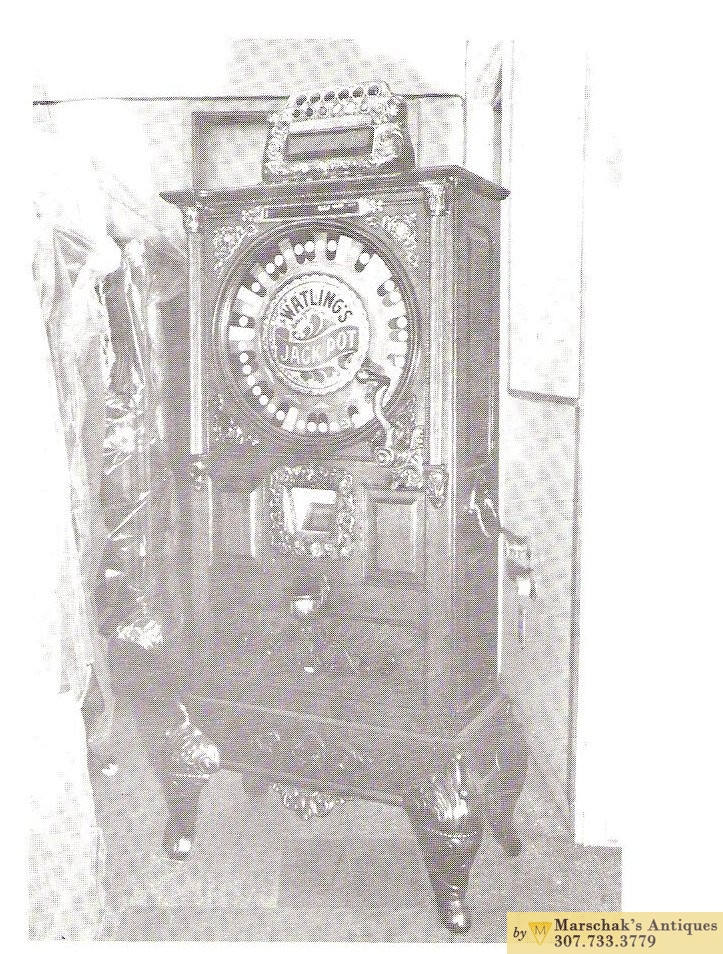
Why should one upright be worth half again as much as another when they look almost alike? Often, rarity has little to do with it. What really sets the value is desirability. You’ll see it work at an auction. Some machines are regarded as more desirable than others, and often a small detail or a graphic element will be worth thousands of dollars to the bidders. The Watling JACKPOT is one of those machines. What seems to make the difference is the fact that the word “Jackpot” appears in the glass, well above the jackpot window in the cabinet. For Watling, this was really a me-too machine. It was built to compete against the jackpot floor machines made by Mills and Caille. Mills called their version the DEWEY JACKPOT, and the glass generally carried the DEWEY name, although JACKPOT was sometimes included. But not elaborately. The Caille version didn’t even use the jackpot name on the machine. Sure, the machine had a visible jackpot casting, but the machine carried the name CENTAUR. Watling, and only Watling, made a big deal out of one of the first popular original words to come out of slot machines. The glass boldly says WATLING’S JACKPOT. It’s stunning. And, obviously, valuable. Watling made no bones about the fact that the 6-way Watling JACKPOT was created to counter the competition. In a 1906 catalog the machine was described as the “Watling JACK POT or CENTAUER”, with the CENTAUR name apparently misspelled on purpose as a cut against Caille. By 1910 Watling described the competitive position of their JACK POT in glowing terms, saying “This beautiful machine leaped into favor promptly, and has held its own with the best.” They added that “Since introducing it, we have added many improvements. It is built with stop wheel in front of dial, also equipped with our extra pay tube, from which the proprietor can refill the jackpot when won out without access to the machine proper, thus holding the players.” The ultimate model was the Watling JACKPOT SPECIAL, a limited production machine with beveled glass sides, a mirrored back and an inside light so you could see the mechanism at work when you played. PRICE GUIDE Would you believe it; a California collector found one in storage in 1978 where it had been stashed away since the San Francisco earthquake. The puzzling part was that the old cloth wrapped electric cord.
Watling JUDGE Floor Machine
Produced between 1902 and 1910
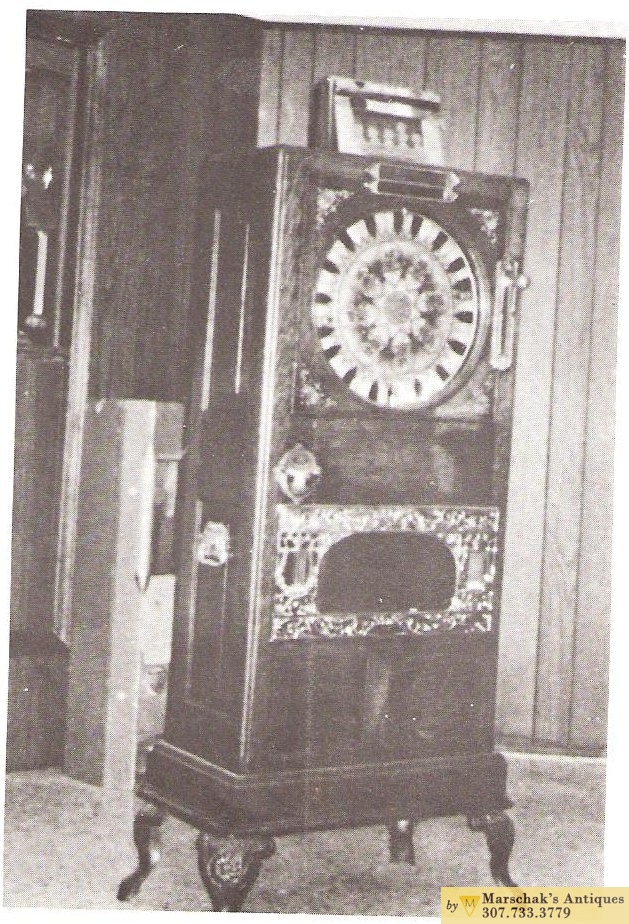
The Watling name has popped up frequently in the previous discussion of floor machines, both as a major producer of such machines and as a copy-cat maker of machines bearing other already popular names. That’s probably slightly unfair, but not completely so. The Watling firm and its predecessor did copy just about every viable machine name that came up, but they also made some original machines of their own. Not nearly as many of the proprietary Watling machines have survived as have the machines with the appropriated names, which suggests that they had a mighty good business going with the latter. Tom Watling and his brother John bought out D. N. Schall and Company at the end of 1901 and picked up the already substantial Schall line of floor and counter machines. They immediately added more, starting out in January 1902 with DEWEY, OWL, IMPROVED CHICAGO, IMPROVED PUCK, JUDGE, FOX and other floor machines in addition to their own MARQUETTE, BUFFALO, UNCLE SAM and further machines. The strange thing is that practically all of the Watling machines with unoriginal names look much alike, with just about the only difference being the 5-way or 6-way coin heads. All of them have generally uninteresting cabinets, similar dials and castings, with the major point of difference being in the glass. You can tell a Watling JUDGE apart from a Watling OWL by the glass, but if the glass is missing, you may as well flip a coin. A restorer can just about make it whatever they want it to be. Another strange thing is that the Watling name is frequently missing, so the machine is often listed as a “Maverick” or an “Unknown”. In most cases, the name was carried only on the paper inside of the cabinet, with this paper often long gone. As frequently happens, when the paper survives, the manufacturer’s name is often scratched out, presumably to prevent identification of the orignal source. Enough machines have been found with this characteristic to suggest that it was a common practice. Copy-cat machines made by White, Berger, Cahill and other firms are much the same, so accurate identification is sometimes difficult.
The mechanisms of the Watling OWL, JUDGE FOX, STAR, et al are usually small, appearing to be Watling BROWNIE mechanisms in large cabinets. The same holds true for the similar Berger and White machines. But Watling seems to have had the edge in copy-cat sales, with one of the 5-way machines having the serial 06580 with a Watling DEWEY numbered 8522. That’s business!
Watling O.K. GUM VENDER Cabinet Bell
Produced between 1911 and 1915
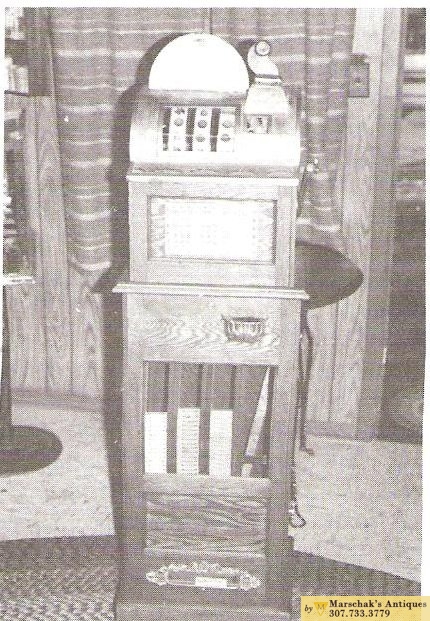
When the three-reel Bell machines first burst upon the scene in 1907 they came out as counter top gambling machines that were one-third to one-fourth the size and weight of the larger and heavier older floor machines, yet they pulled in as much or even more money than the larger cabinet models. Small wonder they were so instantly popular. Logic would suggest that it was a small jump from the counter top Bells of the teens to the counter top jackpot models of the twenties and thirties in a straight-line track of technological development. But such was not the case as an aberration was thrown in the middle of this stream. It was the gum vender.
If you talk with the real early 1900’s old timers in the business and just about all of them have passed to their reward by now, you consistently hear statements that suggest the thwart. In one of my many interviews with Harvey Carr, the 1925 founder of the old coin machine trade publication Automatic Age and the 1930’s and 1960’s publisher and editor of The Coin Machine Journal, he made the statement in November 1976; “The original slot machine was not originally a gambling machine. Those cherries, plums and so forth were to promote sales. Mills was making chewing gum. So what he did was buy the mechanism from Fey ( Charles Fey, San Francisco inventor of the Bell machine in 1905-1906) to sell the gum. By the time I was a kid there was a LIBERTY BELL gum machine in every restaurant, drug store, candy store and cigar shop around.”
At the time I didn’t know what he was talking about and came to the rash conclusion that he was mixed up and didn’t remember events correctly. I should have known better for everything Carr ever told me point-by-point ultimately not only proved to be correct but also very insightful. What changed my mind about the gum vending application of the Bell machine was the slow, sure and steady appearance of very old cabinet Bell machines that indeed vended gum. The proof was in the hardware.
Long regarded as oddities, an attempt was made to play catch up in Volume 3 of this series, with three of these machines illustrated and described; the Caille DELUXE CABINET VENDER of 1910-1914 on Page 59, the Mills NEW GUM VENDER of 1911-1914 on Page 63 and the Mills 1916 FLOOR GUM VENDER of 1915-1917 on Page 67. Now it’s Watling’s turn.
Watling generally copied everybody else when it came to slot machines (or even trade stimulators or arcade machines for that matter. For over twenty years only their scales were really unique). Strangely, this wasn’t completely true in the case of their floor standing gum venders, although they owed more to Caille machines than Mills, just the reverse of the situation with their counter models, The Caille Bros. influence is apparent in the reel symbols.
Watling cataloged their floor model O.K. GUM VENDER in the same 1911 flyer that describes the Watling DERBY of two pages back. This literature even tells how it plays, and how both the operator and the location, or merchant, made a buck. It’s quaint, but to the point. “The operator first places the machine in a restaurant, drug store, ice cream parlor, general store, billiard hall, cigar stand, hotel lobby, saloon or anyplace where the public congregates. He then loads the pay system with premium checks and the gum compartment with gum. The player looks at the (O.K.) indicator which shows just what he will receive for his nickel before putting it in the machine. If the indicator shows the number 2 it indicates he will get a 50 package of gum and two premium checks which are worth 5 (P each in trade (when turned in to the merchant). If the indicator shows the word NO it indicates you will only get a 5, Z package of gum. All premium checks received by the merchant are redeemed at 50 each (by the operator) out of the cash box, then the operator receives the price of the gum sold out of the machine ( out of the cash box), which is 1 a package, and the remainder of the profits is divided with the merchant according to the arrangements made. If the merchant owns the machine he gets all the profits.” Makes you wanna go right out and buy a string. How could you miss?
Watling OWL Floor Wheel
Produced between 1902 and 1910
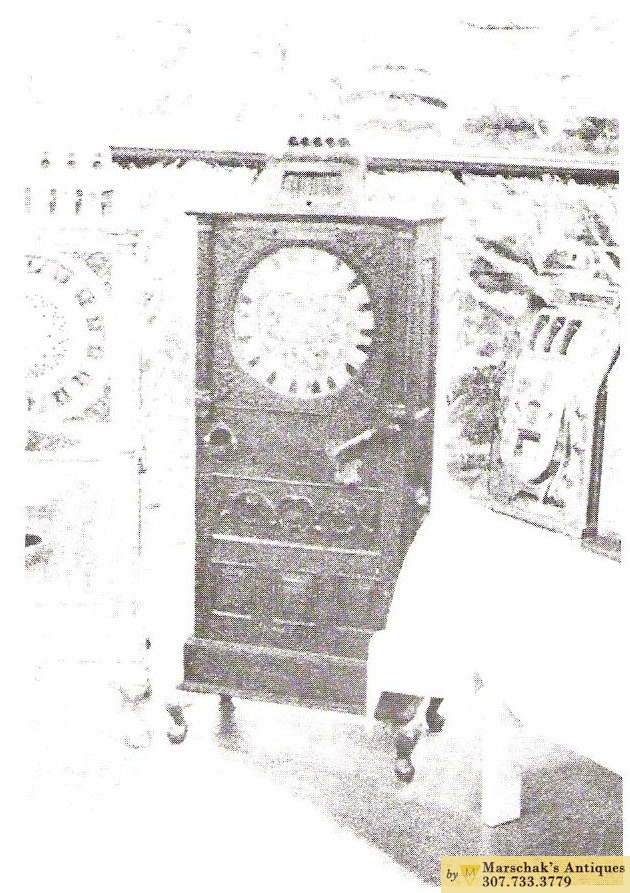
If an idea’s good, it’s worth copying. So when the Berger and White idea of sticking a small BROWNIE mechanism in a floor cabinet to make an upright machine worked out as well as it did, could another copy-cat producer be far behind? Heck no! And guess who? The Watlings, no less. Just as White was getting going with his simple mechanism floor machine line the Watling Manufacturing Company did exactly the same thing, and made their machines equally confusing.
Actually, it even more confusing than that. Watlings’ first OWL machine was a pick-up from D. N. Schall And Company and was practically a board-for-board copy of the Mills OWL. At quick look you can’t even tell them apart, except for the fact that the nameplate lettering “The Owl” is so stylized in Old English you can hardly read it. One of these machines still exists, but it seems to be the only one.
After the Schall OWLS were gone or maybe even before Watling went into a standardized cabinet and legs format for a series of inexpensive small mechanism machines, making the OWL, JUDGE, FOX, CUPID and others. They all have the distinctive Watling 5-way coin head with a slide, and the hardware is identical. The real differences are in the wheel and the glass, although the original decorated glass has usually been replaced with a clear pane, or is just missing. As a result, unless the original glass is still on the machine, or the wheel has distinctive symbols, you don’t know what kind of machine it is.
The paperwork on the inside is just as useless. Watling machines usually have a sheet of instruction paper glued to the back of the door, or on the cabinet wall. This sheet is almost incomprehensible and merely warns about careful loading and machine jams. Muddy looking halftones that claim to be pictures of the key mechanism parts are practically indistinguishable, although they do provide part numbers. But nowhere does the sheet carry the machine name. Oftentimes, the glue used wrecks the paper, or the off years ago. Interestingly, although the Manufacturing Company name and address appear at the bottom of the sheet, in most cases where the sheet still survives and that’s most cases, for some reason this information was scratched out when the machine was used, destroying the maker’s name and most of the instruction sheet at the same time. If some collector ever gets a complete one, here’s hoping it gets reprinted for all of us.
Watling PUCK Floor Wheel
Produced between 1902 and 1907
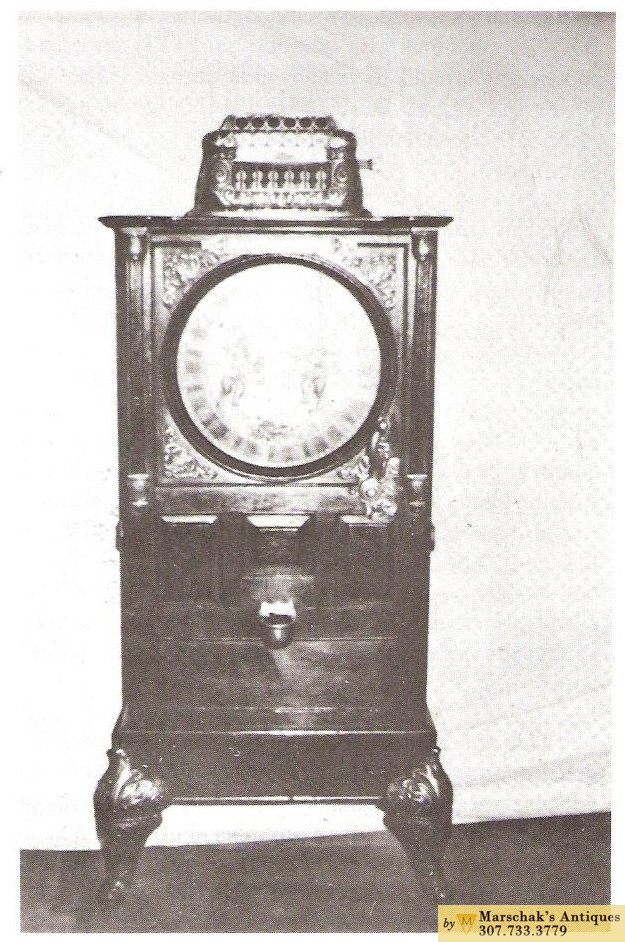
Watling strikes again! This time its with a Caille machine name, only with changes. Actually, Watling didn’t copy the name outright. D.N. Schall and Company did it first with its IMPROVED PUCK, of 1899, later made by Watling in 1902 as “Successors to D.N. Schall and Company”. Caille’s version started with The Illinois Machine Company and Caille-Schiemer, went through The Caille Company and was finally produced in high volumes by The Caille Bros. Co. in Detroit. So it was a distinctly Caille name, through and through.
Until Watling came along with it in 1902. Hear what Watling had to say about its musical version in a direct mail flyer postmarked April 23, 1903: “MUSICAL PUCK. Beware of worthless imitations of our famous machines. Originators and manufacturers of every machine on this card. We do not imitate.” Like hell they didn’t. Maybe the coin head and cabinet were different, and maybe the mechanism was theirs, but the name certainly wasn’t.
Back to the elegant good looks of the Watling machines. Just like the Watling DETROIT, the Watling PUCK looks as good, or better (that’s a matter of opinion, of course), than the Caille original. But there’s something else. Compare this PUCK to the previous Watling DETROIT and you’ll realize you’re looking at practically the same machine. That’s the way Caille did it; the exposed stop DETROIT came out of the hidden stop PUCK. Watling did it too, so even there they held true to the original. What’s more, the Watling catalogue copy of the period suggests vast improvements over the Caille original, and even poses a challenge. It states: “Our IMPROVED PUCK (in their price lists they just call it PUCK) is too familiar to need any introduction, unless we repeat what we have said before that it has been entirely rebuilt and we have eliminated all the delicate and intricate parts and have added the new crank handle as shown (the earlier Caille PUCK has a push down rod playhandle) in cut. We claim it is now one of the simplest machines on the market, paying all prizes in cash from 104 to $2.00 (in nickel play!). We will pay $1,000 to the first person that will show us how to manipulate it, as we claim it cannot be cheated. We guarantee the machine proper for six months.”
Wading made a raft of PUCK models, starting with the NEW CENTURY PUCK, and going to IMPROVED PUCK, PUCK, TWIN PUCK and TRIPLET PUCK, all in plain or musical models. In the early days of slot machine collecting collectors didn’t understand this, and assumed Watling never made such a model. When the first of these machines was discovered and put on the antique market in the middle 1960’s the beautifully etched and decorated glass with two cupid like figures (they were actually figures of Puck) suggested a different name. They
were described and offered to collectors as Watling CUPID machines, with this situation not straightened out until this writing. The Watling CUPID is a considerably different machine. For one thing, it is 5-way. It is described in great detail on Page 55 of Volume 2. No CUPID was ever made with a 6-way coin head, and no Watling PUCK was ever made with a push rod play handle. To add to the confusion, a few years later Watling also made a cast-iron counter-top payout spinning concentric wheels that they also called CUPID. Its rarity makes it worth even more than its namesake floor machine model. So if you have a Watling floor machine with a crank play handle, cupid-decorated glass and a 6-way coin head that you bought as a late model Watling CUPID take another look at it. You’ve got a PUCK, the name of the mischievous sprite in Shakespeare’s play A Midsummer Night’s Dream. If that’s the case, your machine has been playing tricks on you, too.
Watling TOTEM Counter Pointer
Produced between 1912 and 1916
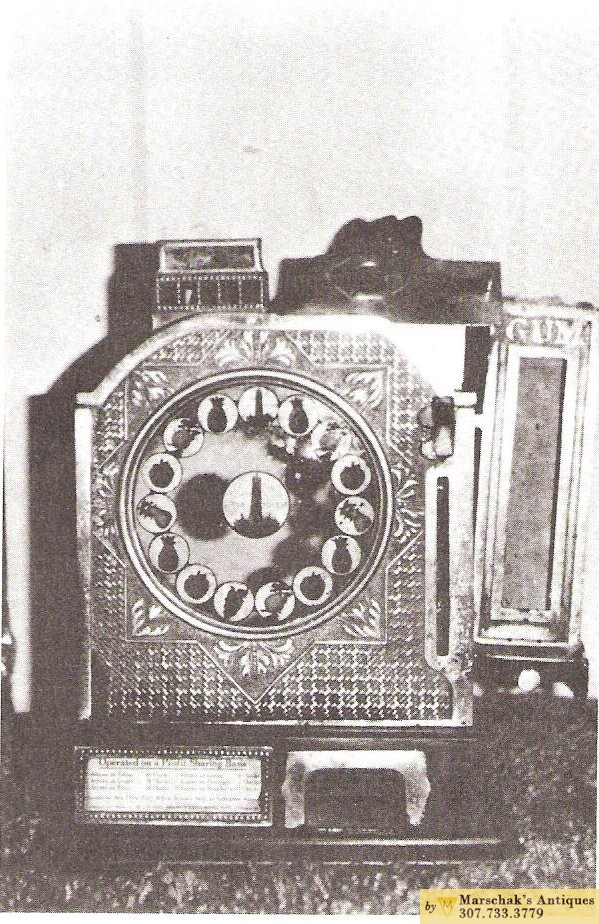
This is what is known in the slot machine collector field as a “heavy piece”. It has nothing to do with its weight (which is heavy, weighing in at just short of fifty pounds) but has everything to do with its value. This is the Watling TOTEM of 1912, and it’s rare. But that’s not all of it.
Watling made a whole line of small single wheel countertop cast iron slot machines that have a similar look, including BILLIKEN, CUPID, PASTIME and TOTEM. They are extremely unique and very colorful. And, best of all, small for cast iron. Most people react the same way; these machines are cute as hell. So collectors want them. But there are few in some cases none to be had. Much like the Caille OPERATOR BELL “Iron Case” machines, they are well known but only a few have been found. Watling called this line “The only single-slot two-arrow machines ever built paying four for one on any winning color”. That’s probably not true, for there are interesting clues to their origin, but until some other examples are found the Watling word is as good as law.
It was to get around the law that these machines were created. You’re looking at a gum vender model, but they also came plain for straight play. The reward card tips the operating plan, saying: “Operated on a Profit Sharing Basis”. That meant that sometimes, when you play, you win and thereby “share” the profit with the location or operator, often one and the same. The symbols, by the way, are marvelous and in vivid colors. They include a multi-colored Totem Pole, plus Pine-apple, Pear, Lemon, Strawberry and a cluster of Grapes. Sure, they’re fruit symbols, but hardly the ones we know. They almost suggest The Caille Bros. Co., but the actual origin is a far cry away. One known TOTEM has the name “G. W. Schultze, S.F.” on it. That’s our friend Gustav F. W. Schultze who created the AUTOMATIC CHECK MACHINE of 1893 described on earlier pages. Maybe this line is an original Schultze design, in spite of the fact that an early Watling catalog says these machines were “invented and made by Watling Manufacturing Co., Chicago, Ill.” Watling also called the TOTEM one of the “smallest self-paying machines ever built”, adding “the mechanism can be removed from the cabinet without removing a screw. Just open the door and slide it out. They can be operated where other machines are not tolerated. The best lawyers claim there is no law to stop their operation when operated as a future pay check paying gum vender”.
OTHER MANUFACTURERS

- Hull’s Chicago Floor Wheel
- Berger UNO Floor Wheel
- Clawson AUTOMATIC DICE
- Eagle SQUARE DEAL GUM VENDER
- Fey LIBERTY BELL
- Fey SILVER CUP
- LEADER Floor Wheel
- Paupa & Hochriem ELK
- Reliance (Caine)
- Royal (Mills) Trader
- Schall (Watling) CUPID
- Schall (Watling) MARQUETTE
- Schiemer - Yates GIBSON GIRL
- Sittman & Pitt LITTLE MODEL
- VICTOR Floor Machine
- Victor LITTLE SIX AMERICA WINS
- Victor TWO BITS
- White AMERICAN BEAUTY
- White CHICAGO RIDGE
- White THE LEADER
Automatic Machine HULL’S CHICAGO Floor Wheel
Produced between 1903 and 1906
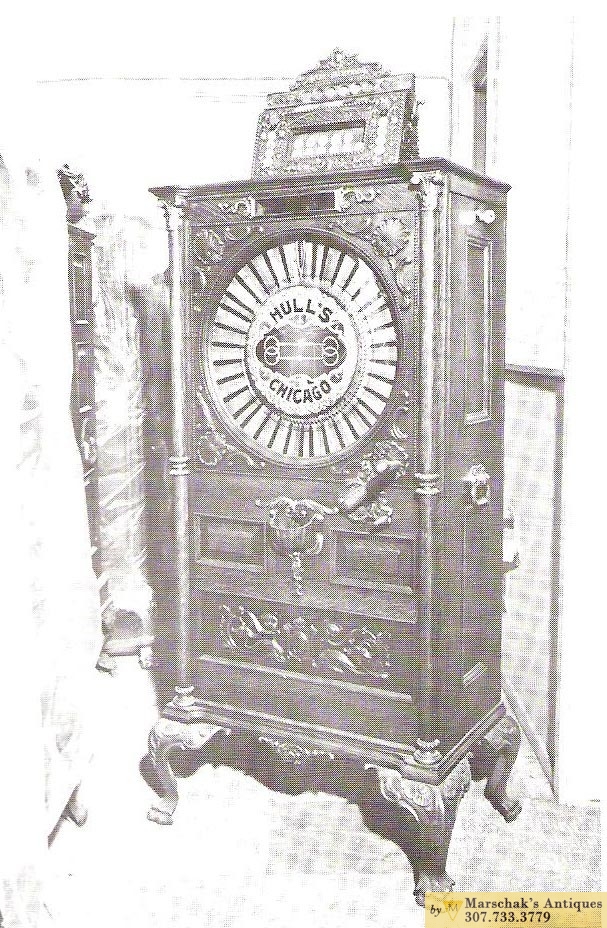 “Who’s Hull?” Back in the late sixties and early seventies, when collectors first started talking to each other about their machines once they got over the idea that anybody they talked to would turn them into the local fuzz, the question kept coming up. It has ever since. It would appear there once was a company named Hull that made floor machines in the early 1900’s. But things aren’t always what they appear to be.
“Who’s Hull?” Back in the late sixties and early seventies, when collectors first started talking to each other about their machines once they got over the idea that anybody they talked to would turn them into the local fuzz, the question kept coming up. It has ever since. It would appear there once was a company named Hull that made floor machines in the early 1900’s. But things aren’t always what they appear to be.
The whole idea of a theoretical “Hull Novelty Company” came out of the fact that a number of surviving floor machines had original glass that prominently displayed the name “Hull.” The best known examples are the HULL’S CHICAGO, the latter pictured. One look tells you that this is an Automatic Machine And Tool Company machine. The cabinet, the castings, the crank coin head and the wheel are all but positive proof that the HULL’S CHICAGO and its compatriots were made in Chicago by the Automatic Machine And Tool Company. One by one the collectors that had the machines came to the same conclusion, particularly after they got a chance to see other machines made by the same manufacturer. One of the machines that surfaced in the middle seventies had a big “H” in the center of the glass the same way John Gabel stuck in a “H” on his LEADER to provide further similarities to Automatic Machine And Tool Company production.
But still the same question: who’s Hull?
The next assumption that gained favor was the possibility that Hull, whoever he was, was an operator and had his glass made to special order. But that idea came a cropper when it was realized that the machines had shown up all over the country; in California, the Dakotas, in Wisconsin and apparently one in Ohio. No operator had a territory that big. Then, to top it all off, one example showed up that had HULS (with one “L”) CHICAGO in the glass. Anyone named Hull wouldn’t accept that on a bet. That led to the assumption that the manufacturer was in charge of distribution and not a buyer named Hull.
Not one to back away from a puzzle the likes of this one, the author checked all possible machine makers or dealers in Chicago between 1899 and 1910 (even though John Gabel stopped making slot machines in 1906), and only came up with three. There was a George H. Hull who worked as a machinist on the same block as the Mills Novelty Company in 1900, but not afterward. Then, between 1907 and 1910, a guy named Cramford L. Hull sold stereopticons on the south side of Chicago. The best bet is 0. C. went to work for John Gabel, and got a chance to put his name on a machine or two of his own, spelled right or not. But even that’s only an assumption. So who’s Hull?
Berger UNO Floor Wheel
Produced between 1900 and 1902
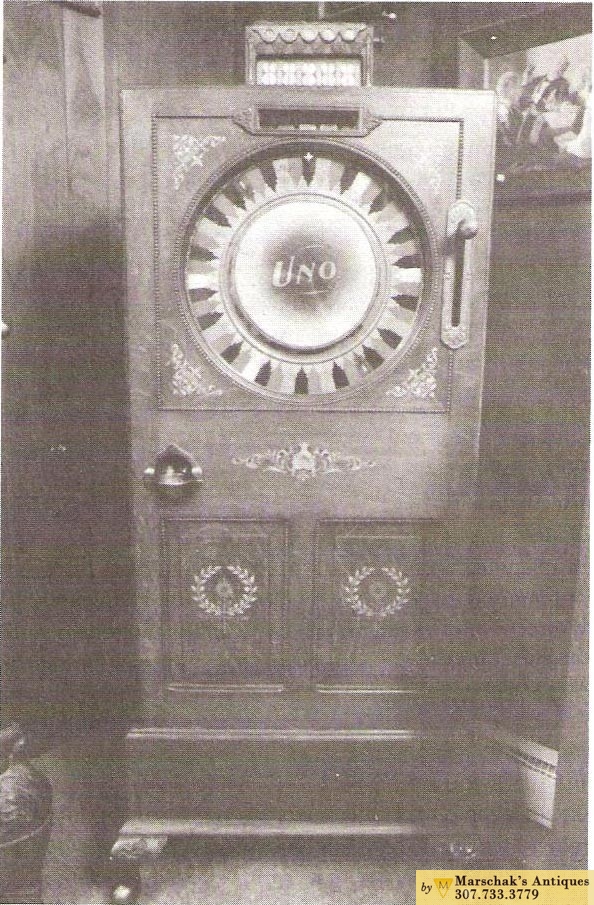 There’s one thing about the UNO name on a slot machine that captures people’s imagination. They like it. And there’s something about UNO floor machines that captures collector attention. No two are alike. Half a dozen makers made UNO machines, and all they copied was the name. Cabinet and graphics wise these machines differ from one another more than any other basic model automatic color wheel floor machine ever made.
There’s one thing about the UNO name on a slot machine that captures people’s imagination. They like it. And there’s something about UNO floor machines that captures collector attention. No two are alike. Half a dozen makers made UNO machines, and all they copied was the name. Cabinet and graphics wise these machines differ from one another more than any other basic model automatic color wheel floor machine ever made.
So maybe the old makers liked the name, too. The UNO machines seem to suggest this. UNO floor machines were made big and small, plain and musical, expensive and cheap. Most of them were 5-way, and most were fairly expensive machines. But not the Berger. They made a cheapie in their basic Plain-Jane cabinet, substituting new glass only in a basic machine that also showed up as the Berger OWL and JUDGE. But don’t get swayed by this. Cheapie then circa 1900 to 1902 is valuable today, and this machine has a classic look all its own. The cabinet, while plain, is beautiful. The decals in this example totally mint are colorful and charming, and do a good job of taking the place of the expensive hand carved trim of earlier Berger machines. That’s why decals were used; to take some of the high cost out of production so the machines could be competitively priced.
But what’s Berger doing with a mechanical machine, anyway? Didn’t they make the electrics? Sure they did, but by the year 1900 the mechanical floor machines based on the Mills OWL were running away with the market. So Berger, who still made the electrics, hedged their bets and came out with a low-cost line of mechanical’s.
The basic cabinets, coin heads and mechanisms were the same. Only the glass changed. So this Berger UNO could just as easily have been an OWL, JUDGE, FOX, LION or STAR with different glass. Lucky for the collector that found this example in 1978 as the glass is UNO and there are no owls on the wheel. How come lucky? Well, out of the whole batch the UNO is preferred, and that’s the way it was found. Either the LION or FOX glass would have been almost as good, but UNO is still the top choice.
Here’s a neat aside. Back in 1901 when this machine was being widely advertised by Berger in THE NATIONAL POLICE GAZETTE, the selling price was $40. Look what’s happened since then. Berger also made the UNO MUSICAL that sold for very little more.
Clawson AUTOMATIC DICE
Produced between 1890 and 1902
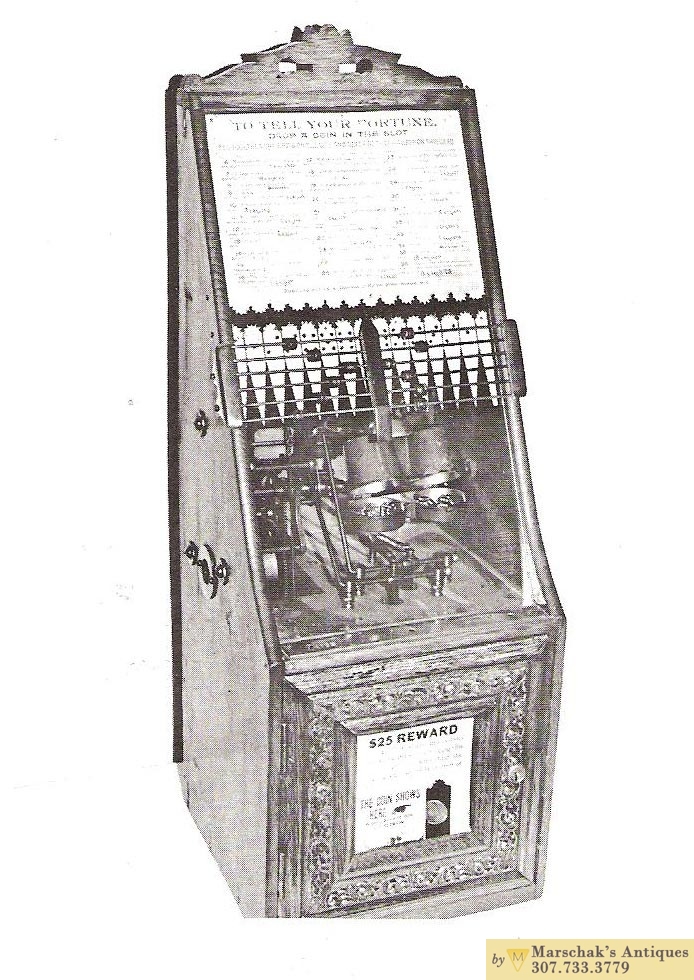 A throw of the dice is as American as a shot and a beer, and saloon patrons imbibed almost as often as not by playing against the barkeep. It was standard barroom fare, until the bartenders got fed up with the constant customer demand for a game for drinks. Clever inventors provided new solutions, with dice becoming the first chance paraphernalia to be mechanized. Clement C. Clawson, an early coin-operated platform scale maker of Newark, New Jersey, created a sophisticated and mechanically complicated coin released dice thrower which he called AUTOMATIC DICE, forming The Clawson Slot Machine Company to manufacture the device. AUTOMATIC DICE was introduced in 1890, quickly finding favor as the first nationally popular coin operated gambling machine, making The Clawson Slot Machine Company the first nationally—known producer of slot machines, with the company name literally giving the machines their class name.
A throw of the dice is as American as a shot and a beer, and saloon patrons imbibed almost as often as not by playing against the barkeep. It was standard barroom fare, until the bartenders got fed up with the constant customer demand for a game for drinks. Clever inventors provided new solutions, with dice becoming the first chance paraphernalia to be mechanized. Clement C. Clawson, an early coin-operated platform scale maker of Newark, New Jersey, created a sophisticated and mechanically complicated coin released dice thrower which he called AUTOMATIC DICE, forming The Clawson Slot Machine Company to manufacture the device. AUTOMATIC DICE was introduced in 1890, quickly finding favor as the first nationally popular coin operated gambling machine, making The Clawson Slot Machine Company the first nationally—known producer of slot machines, with the company name literally giving the machines their class name.
To this day one marvels at the workings of AUTOMATIC DICE. Dropping the nickel starts a pre—wound clockwork mechanism that brings two dice cups down over matching trays holding three dice each, with the
whole assembly then rotating backward with the trays serving as the cup lids. Then, with a quick throw the trays go flat again, and the cups throw the dice back on the trays. And that’s it! The player counts the spots, with the total indicating a win or loss based on a reward card tally, with the bartender paying off in drinks. The marvel of it is that you see it all happen before your eyes, wheel spinning clockwork mechanism and all, as the entire operation takes place behind clear glass.
AUTOMATIC DICE was also made later as AUTOMATIC FORTUNE TELLER in which the reward card theoretically told fortunes by the total spot numbers, a subterfuge to get around anti-gambling laws. A typical AUTOMATIC FORTUNE TELLER serial is 527X. Six to ten of these Clawson dice machines are known to exist, with newly found examples showing up in 1976 and 1977. The rarest variant is the AUTOMATIC SALESMAN of 1893 which automatically pays out a winning token, but to date there are no surviving examples of this model. Other producers imitated the machines, including the M. O. Griswold And Company DICE and the Weston Slot Machine Company variation made in Syracuse, New York, that used small ball hearings in rotating twin pinfields instead of dice. But it’s the Clawson that most collectors seek.
Eagle SQUARE DEAL GUM VENDER Counter Single Reel
Produced between 1911 and 1922
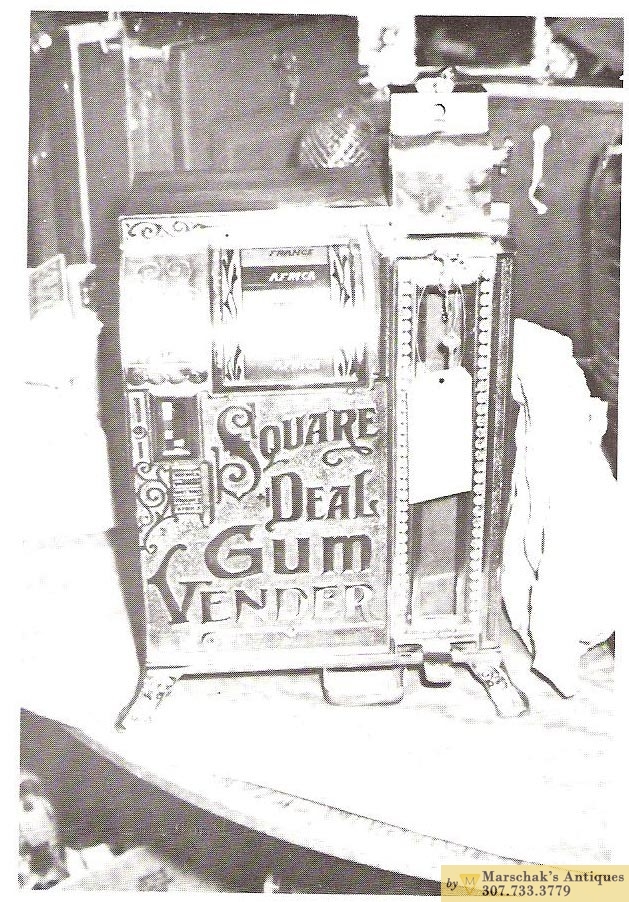 Remember how the McDonald Manufacturing Company became the Victor Novelty Works and then Victor became something else? Well, they became the Eagle Manufacturing Company, and the guy that engineered the deal was a genius type slot machine inventor named Thomas V. Skelly. It was just about the time that the three-reel Bell machine (given its machine class name by Charlie Fey’s LIBERTY BELL as reported in the first volume of these collector guides) was sweeping the business and cast iron machines on short feet were all the vogue.
Remember how the McDonald Manufacturing Company became the Victor Novelty Works and then Victor became something else? Well, they became the Eagle Manufacturing Company, and the guy that engineered the deal was a genius type slot machine inventor named Thomas V. Skelly. It was just about the time that the three-reel Bell machine (given its machine class name by Charlie Fey’s LIBERTY BELL as reported in the first volume of these collector guides) was sweeping the business and cast iron machines on short feet were all the vogue.
The first machine produced by the Eagle Manufacturing Company was a 6-way counter wheel payout called the EAGLE, so you can see where the company name came from (just as Victor’s VICTOR named Victor). A gum vending version was made as the EAGLE GUM VENDER to get around anti-gambling laws. Then, when the single and multiple reel machines got popular, Eagle did the same thing with a tall gum package vender called SQUARE DEAL GUM VENDER. The size it is deceptively large bulk, bright colors and elaborate front castings made this one of the most sought after counter machines known to collectors.
Only three or four of these machines are known to exist in various stages of condition. What most of its owners don’t realize is that while it is decidedly a payout machine it was never intended to pay its winners in cash. The original literature for the machine describes it as “a combination trade check and gum machine allowed by authorities everywhere.” So, you play money, get a package of gum if you pull the slide, and get a payout in tokens if you win. The way to win is to select a color by a lever before you play, picking one of five. Shades of the Victor LITTLE SIX AMERICA WINS; the colors corresponded to countries, only this time any country could be a winner with “America” having just as much a chance as any other. A typical serial number is 30.
By way of a social note, although it came out only a few years after the Victor LITTLE SIX AMERICA WINS it reflected a change in the labor pool. America, Germany, England and France were there as they had been in the past, but Sweden and Ireland were obviously lumped with America to make room for a new addition, a generic and geographic lumping identified as “Africa.”
Fey LIBERTY BELL Bell Machine
Produced between 1905 and 1906
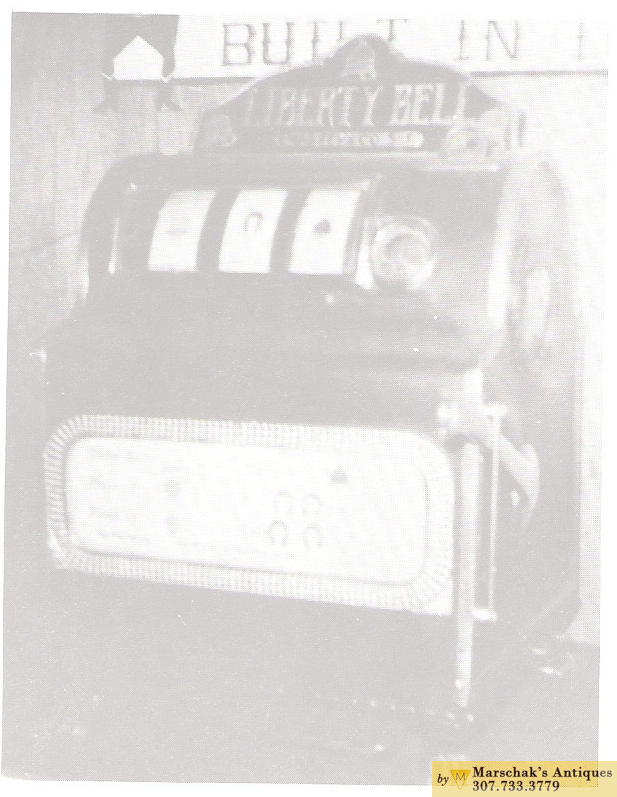 Just about everybody who has any interest in slot machines knows a story or two about the Fey LIBERTY BELL, regarded by many as the “first” slot machine. It wasn’t the first slot by a long shot. It wasn’t the first payout machine, and it wasn’t even the first three reel machine. But it is the first automatic cash payout three reeler made, and as such is the foundation of the slot machine industry. Fey is also rightfully regarded as the “Father” of the industry.
Just about everybody who has any interest in slot machines knows a story or two about the Fey LIBERTY BELL, regarded by many as the “first” slot machine. It wasn’t the first slot by a long shot. It wasn’t the first payout machine, and it wasn’t even the first three reel machine. But it is the first automatic cash payout three reeler made, and as such is the foundation of the slot machine industry. Fey is also rightfully regarded as the “Father” of the industry.
Charlie Fey was a German born machinist that had been making coin machines in San Francisco for almost ten years before he created the LIBERTY BELL around 1905. Because the three reels are far more exciting to anticipate and watch than a single spinning wheel stopping on one color, Fey’s machine was an instant hit on the Barbary Coast; but only there. Fey made the machines for his own operator routes and never sold them on the open market. If the Fey machine is so rare, how can it be listed as a collectible with a value? Miraculously, the Fey LIBERTY BELL is a surviving population machine. Based on the theoretical survival rate of one percent of produced machines, the LIBERTY BELL runs well ahead. It would seem that about fifty or sixty original Fey made LIBERTY BELLS were produced. At least three are known to exist. That’s a five percent survival. Some years ago, only one was known.
Then a second and much later a third one surfaced; not in California, but in Chicago. It seems Fey had shipped them to friends there in the thirties. You keep hearing about more of them off and on, and logically, if they are to be found anywhere, it’ll probably be in the bay area, perhaps in Oakland or San Francisco itself.
Anyone interested in slots should see a LIBERTY BELL, if only to get close to the original invention that brought gambling machines out of the barroom and into the world. Not only can you see one anytime you want to, you can have an enjoyable time while doing it. Just go to Reno, Nevada, and track down the Liberty Belle Saloon and Restaurant. It’s out on South Virginia Street at the edge of town. There Marshall and Franklin Fey, grandsons of Charlie Fey, have encased one of the original LIBERTY BELL machines, and have also filled their dining room with a marvelous collection of antique slots. If there is such a thing as a slot museum, or a shrine, this it it.
Fey SILVER CUP Counter Wheel
Produced between 1910
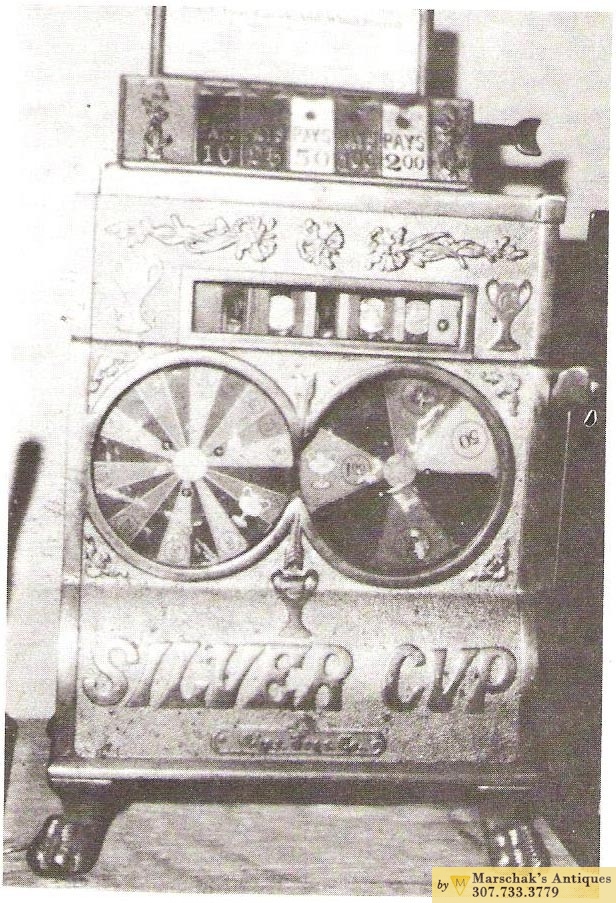 Charlie Fey gets the credit for a lot of things. Most of which he deserves. Some of which he doesn’t. Just about the biggest thing Fey did for slot machines and particularly for slot machine operators has been forgotten over the years and he hasn’t received the credit for it. Yet. Starting now he does.
Charlie Fey gets the credit for a lot of things. Most of which he deserves. Some of which he doesn’t. Just about the biggest thing Fey did for slot machines and particularly for slot machine operators has been forgotten over the years and he hasn’t received the credit for it. Yet. Starting now he does.
Charlie Fey took slot machines off the floor and put them on the counter. That’s super significant for a lot of reasons. The old floor machines were heavy, costly and all but immovable once they were put in place. As a result, they stayed where they were, and were often sold direct to the locations by the makers. Sure, there were OWL and DEWEY operators Charlie Fey was one but the machines were so big and the take usually so modest that operators that were willing to move them from one location to another were few and far between. It was to get around this heavy labor that Fey made his many marvelous counter model payout slot machines, the LIBERTY BELL of 1906 and the SILVER CUP of 1910 being prime examples. With a LIBERTY BELL or SILVER CUP on the bar a location would get as much and usually a lot more play on the smaller machines than they did on the large floor machines. Best of all, the new machines were highly portable. So operators entered the field by droves, set up strings of machines, and all but wiped out the location owned machine.
What Fey really invented with his counter-tops was a new and better way of doing business. People knew it at the time, and that’s why the industry, and particularly the old operators, paid him homage. Today we tend to think of him only in inventive and innovative terms while we marvel at the machines he made or modified. Yet his biggest achievement was in the field of marketing. He literally remade the operator business in his own image, and it worked. The Fey counter machines were clever as hell, but really weren’t engineered very well. Fey did it all by hand, there are no surviving engineering drawings or patents for his machines and just cut and fit until everything worked together. That’s what makes an original old Fey machine such a treasure; his fingerprints are all over it. (Note: Some day someone should dust the old Fey mechanisms for fingerprints. Old grease spots and flat surfaces should have them. Transfer, and frame. What a nifty slot collectible.) The heavy handed castings, lunky coin head and naive graphics of this original Fey SILVER CUP, now owned by Charlie Fey’s grandson, Marshall Fey, of The Liberty Belle Saloon And Restaurant in Reno, Nevada, ( it’s on display there, go in for a corned beef sandwich and look around at some good stuff) makes the point just by appearance. The game is an old and 1912 one, and even some of the older floor machines had it. Pick a color on the 5-way coin head, odds varying. Match the color on the two wheels at the center and you win. Fey miniaturized the idea in an automatic payout counter-top and it took off like a house afire. He even made payout trade checks with the SILVER CUP name on them for his own routes. They’re worth something these days, too. Oh, look below the SILVER CUP name. There’s a panel there that says “Chas. Fey & Co.”. Also note that the feet are identical to the earlier Fey LIBERTY BELL ( See page 33, Vol. 1). Incidentally, the payout cup is missing. It should be flush to the right foot, just like the LIBERTY BELL.
Automatic Machine LEADER Floor Wheel
Produced between 1902 and 1906
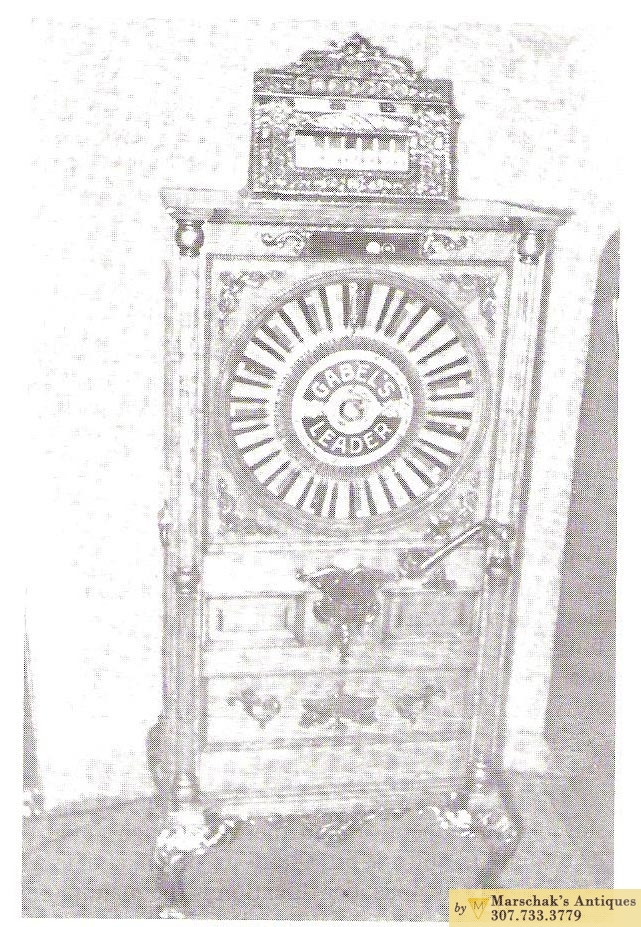 It’s 1902, and we’re back to the Automatic Machine And Tool Company, and already you can see that things have changed a lot. Gone are the original machine ideas and gone are the really unique castings. A fast look at this thing suggests a Mills machine, and when the first rough example of the Automatic Machine LEADER was found it was thought to be a seven coin DEWEY machine. The 7-way coin head makes this machine somewhat of a rarity, and the DEWEY idea was quickly dismissed, except for the fact that the machine looked so much like one.
It’s 1902, and we’re back to the Automatic Machine And Tool Company, and already you can see that things have changed a lot. Gone are the original machine ideas and gone are the really unique castings. A fast look at this thing suggests a Mills machine, and when the first rough example of the Automatic Machine LEADER was found it was thought to be a seven coin DEWEY machine. The 7-way coin head makes this machine somewhat of a rarity, and the DEWEY idea was quickly dismissed, except for the fact that the machine looked so much like one.
How come such a close DEWEY look and why 7-way? The first answer is an easy one. Automatic Machine And Tool Company did the same thing Watling did, and Chas. T. Molitor (Aha! There’s a new manufacturer’s name for you.) and others they copied the Mills DEWEY as closely as they could while still retaining their own parts, castings and coin heads. They even modified their coin heads to make them look a lot like a Mills head, although in the case of the Automatic Machine And Tool Company, the Berger type crank on the side of the coin head is still an obvious give away to the machine’s origin.
Once Automatic Machine And Tool Company had their own DEWEY in hand further development was a natural, leading to the 7-way LEADER. Assuming the use of the name LEADER was original with the Automatic Machine And Tool Company, the first models probably had a highly decorated glass with the machine name on it, and some graphics. None have been found that way, but it’s a fair assumption. What has been found is the machine in the photograph, only when it was first discovered no one had any idea what it was. The cabinet had been painted and in its final state it was painted in black enamel with bright yellow trim. Luckily, the original glass was intact, but also painted. It takes a lot of vision to tackle a machine so far gone, but the restoration job resulted in one of the most magnificent machines in any collection. The glass, suggesting late production, has silvered lettering saying “GABEL’S/LEADER,” the typical John Gabel approach to letting everyone know who made the machine. In the middle of the glass a graphic element consisting of a large “G” (For Gable, who else?) has a pyramid logotype in its center, plus the lettering “Gabel/Trade Mark.” For the detail conscious collectors, the machine serial number is 523.
Other Automatic Machine and Tool Company LEADER machines have been found, but not quite so intact. A complete mechanism plus castings was found in Ohio, minus the cabinet, and a LEADER DOUBLE is rumored to exist in a western state. Unless other collectors have examples, that’s it for the surviving LEADER floor machines.
Paupa & Hochriem ELK Counter Machine
Produced between 1905 and 1907
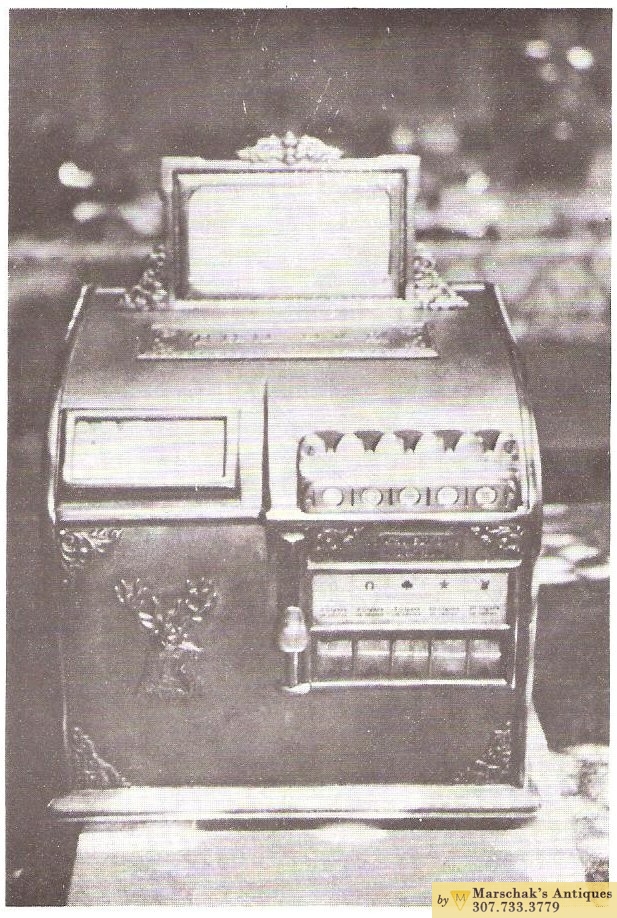 If collectors were to agree on a cast iron classic, the ELK would probably win more votes than any other single machines. First of all, the ELK introduced a new slot machine class; the single reel payout. Secondly, the cabinet work on the ELK is absolutely beautiful. Third and fourth, it’s a payout, and a dozen or two examples are already known in a variety of nickel, oxidized, copperloid and brass finishes.
If collectors were to agree on a cast iron classic, the ELK would probably win more votes than any other single machines. First of all, the ELK introduced a new slot machine class; the single reel payout. Secondly, the cabinet work on the ELK is absolutely beautiful. Third and fourth, it’s a payout, and a dozen or two examples are already known in a variety of nickel, oxidized, copperloid and brass finishes.
The original producer was Paupa and Hochriem, an early Chicago slot machine manufacturer that started business in 1892. The inventor of the machine, and apparently also the creator of the cabinet design, was Gustav F. Hochriem. Hochriem had the audacity to apply for a patent on the machine as a “Vending Machine”. Wonder of all wonders, he got it on June 21, 1904, U. S. Patent No. 763,286. What did it vend? Nickels, of course, for a winner! P & H also made a quarter play version which they called the EAGLE’
The ELK was quickly copied by Mills, Watling and Caille Bros. who came out with their versions in 1906. You can easily tell the difference, however, by a good look at the machines. The cabinet castings on the P & H machine are crisp and sharp; the others are somewhat smoother and less detailed. It’s as if Mills and Caille made their cabinet patterns from the original, losing some of the detail in the process. Also, the early P & H machines had their operating lever in the center, whereas Mills moved it to the right. The ELK was Paupa and Hochriem Model No. 9, stamped with a die on the back of the all metal cabinet. Some of the Mills machines have a “9” stamped on their back, indicating they were part of the P & H inventory picked up by Mills. Typical P & H serial numbers are 21 and 27, although they should go up into the hundreds as the machine was very popular.
If you own an ELK you might want to frame the patent behind it. In about fifteen pages it shows the complete cabinet and mechanism, and is also an invaluable guide for parts and repair. Just send 50 cents to the Patent Office with the patent date, number. and Hochriem name, and you’ll get a set of original slot paper at a bargain.
Examples of all models are known, except the Watling version. If you’ve got an ELK, check it, you might have the only Watling example there is.
Reliance (Caine) RELIANCE
Produced between 1896 and 1910
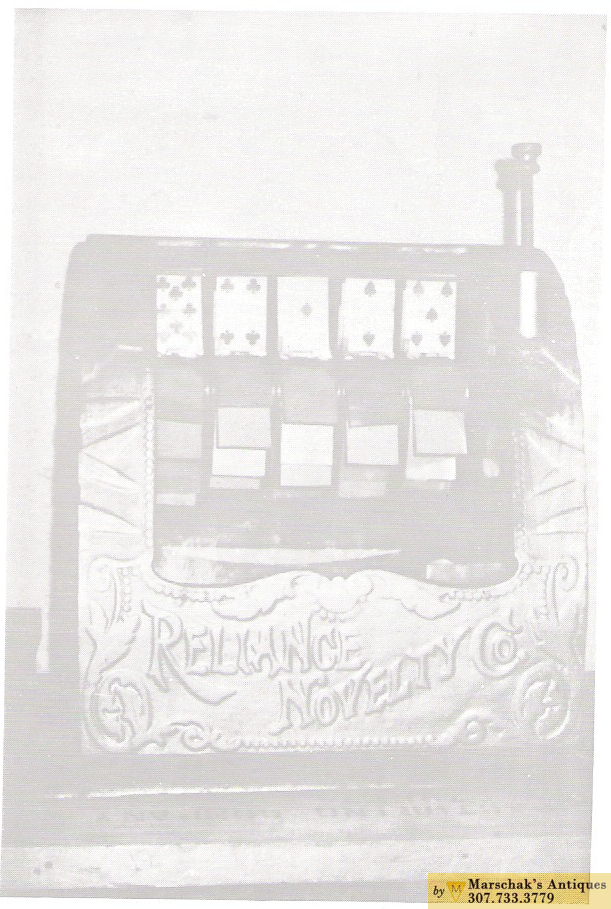 You better not expect to find one of these original Reliance RELIANCE machines unless you live west of Denver. It was created by a San Francisco cigar dealer named Benny Wertheimer in 1896 which makes it an oldie for even California. It was really a beefed up Sittman & Pitt card machine with a bigger and better looking case. Wertheimer formed the Reliance Novelty Company in San Francisco in June 1896 to make and sell the machine along the Pacific coast and in the mining country as well as other machines in later years.
You better not expect to find one of these original Reliance RELIANCE machines unless you live west of Denver. It was created by a San Francisco cigar dealer named Benny Wertheimer in 1896 which makes it an oldie for even California. It was really a beefed up Sittman & Pitt card machine with a bigger and better looking case. Wertheimer formed the Reliance Novelty Company in San Francisco in June 1896 to make and sell the machine along the Pacific coast and in the mining country as well as other machines in later years.
The RELIANCE comes under the collector classification of a “cast iron” machine, a discipline that a select number of advanced collectors follow. They have to be advanced because the machines tend to be very expensive. But some lucky RELIANCE finds have been made by just plain folks at local auctions to become the commanding piece in their collections. In one case the first find was made by a young woman who picked it up for $175 that was around 1973 and it sold at auction for a reasonable price about two years later. A typical original RELIANCE serial is 7919, so a lot of them must have been made and sold in their day.
Reliance apparently sold the machine out around 1904 or so, because that’s about the time that Caille Bros. Co. in Detroit came out with the identical machine. They also called it the RELIANCE, putting the name in big letters on the cabinet casting to replace the former company name. Caille added a swivel base so the bartenders could swing the machine around fast to see if a claimed winner was a liar. The Caille machines seem to be rarer than the older Reliance models, but maybe the collectors just don’t know where all the surviving examples are yet.
We haven’t talked about the Mills Novelty Company yet. We will. They were big. In any event, Mills also made the identical machine after 1904. They didn’t give Caine Bros. the first fall: Mills called their machine VICTOR.
Royal (Mills) Trader
Produced between 1902 and 1908
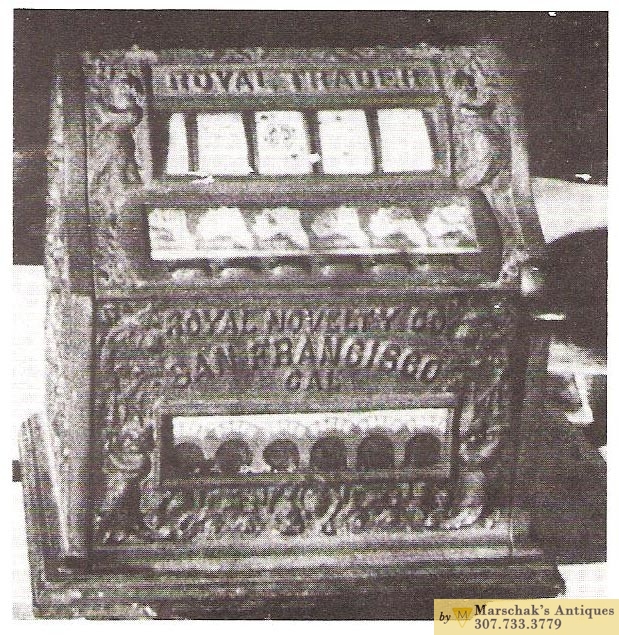 Many a gold and silver miner left his heart in San Francisco as well as his bullion. There was hardly a wilder place at the turn of the century, and pre-earthquake San Francisco remains immortalized in song and legend. The past is prologue, and it is only logical and fitting that the State of California was the first to enact an antique slot machine collecting law. Just in time, too. Coin-operated chance machine collecting had moved rapidly into the big time with the machines major collectibles by 1976 and it’s been all up hill ever since. Since that day, and before, some of the most interesting machines in the country showed up in California. Before the collecting law was passed many of the machines quickly went out of the state. Since that time many of California’s slot machine treasures have hung around home, with many major collections in the far western state. The California made Royal, later Mills, TRADER machine typically demonstrates what happened. The few that were known to collectors in the sixties and seventies were hoarded, with some sold out of state to keep them safe and likewise turn a buck. The Royal Novelty Company was founded in San Francisco just as the year 1900 came around the corner. The firm made machines to both sell and operate, with the Royal TRADER starting out the line. It was practically an exact duplicate of the Mills LITTLE DUKE; card reels, 6-way play, cast iron cabinet and all, even the swivel base. The cabinet castings are loaded with graphics, with the name “ROYAL TRADER” cast in the metal above the reels, and “Royal Novelty Co./San Francisco/Cal.” cast in letters on the front. There was no mistaking whose machine it was.
Many a gold and silver miner left his heart in San Francisco as well as his bullion. There was hardly a wilder place at the turn of the century, and pre-earthquake San Francisco remains immortalized in song and legend. The past is prologue, and it is only logical and fitting that the State of California was the first to enact an antique slot machine collecting law. Just in time, too. Coin-operated chance machine collecting had moved rapidly into the big time with the machines major collectibles by 1976 and it’s been all up hill ever since. Since that day, and before, some of the most interesting machines in the country showed up in California. Before the collecting law was passed many of the machines quickly went out of the state. Since that time many of California’s slot machine treasures have hung around home, with many major collections in the far western state. The California made Royal, later Mills, TRADER machine typically demonstrates what happened. The few that were known to collectors in the sixties and seventies were hoarded, with some sold out of state to keep them safe and likewise turn a buck. The Royal Novelty Company was founded in San Francisco just as the year 1900 came around the corner. The firm made machines to both sell and operate, with the Royal TRADER starting out the line. It was practically an exact duplicate of the Mills LITTLE DUKE; card reels, 6-way play, cast iron cabinet and all, even the swivel base. The cabinet castings are loaded with graphics, with the name “ROYAL TRADER” cast in the metal above the reels, and “Royal Novelty Co./San Francisco/Cal.” cast in letters on the front. There was no mistaking whose machine it was.
That changed when The Mills Novelty Company started making its west coast buys. Mills bought out Royal, or more to the point, the Royal machines, around 1904 picking up the Royal TRADER and another machine called the Royal HYLO. Mills continued to make THE TRADER, with Mills graphics replacing the Royal wording.
There seem to be as many Mills the TRADER machines around as Royal machines, with both regarded as prime collectibles. Their value is about equal.
Schall (Watling) CUPID Floor Wheel
Produced between 1900 and 1907
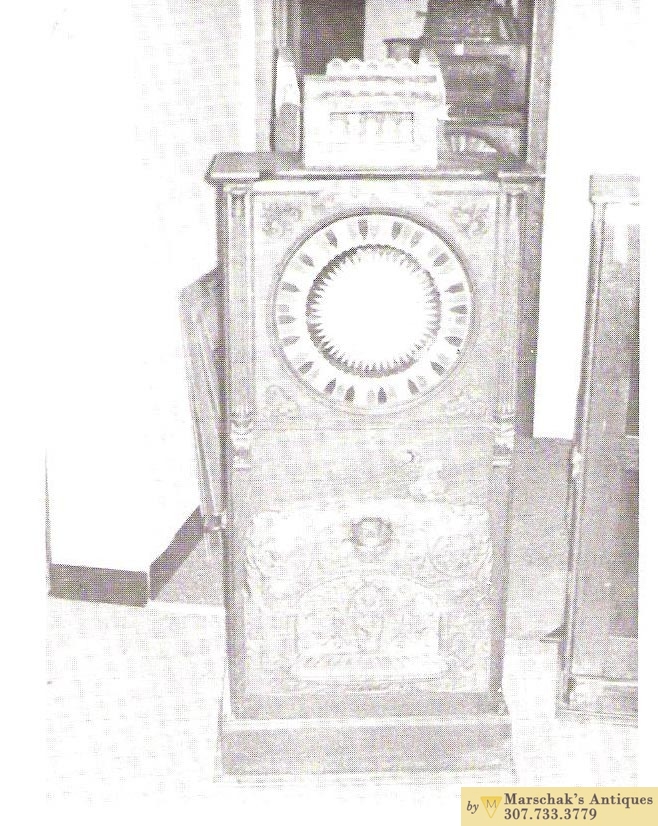 As a premier collectible, the Schall CUPID has a lot going for it. But it’s not particularly its good looks, for other than its glass it doesn’t really look that good. It’s what it is, and what it later became, that makes it a desirable machine. The Schall name is a clue to something. D. N. Schall And Company, as you now know, was the big producer of the middle and late 1890’s counter wheel payout machines. When the floor machines came along, the “Dan Schalls” at the time practically all counter wheels were called that no matter who made them were extinct in one big hurry. When D. N. Schall And Company couldn’t beat ’em, they joined ‘ern and by 1900 Schall was making floor machines. They started out by making their own versions of the OWL and the JUDGE, and quickly beefed up a rapidly expanding line with new machines of their own name and design, of which the CUPID is one.
As a premier collectible, the Schall CUPID has a lot going for it. But it’s not particularly its good looks, for other than its glass it doesn’t really look that good. It’s what it is, and what it later became, that makes it a desirable machine. The Schall name is a clue to something. D. N. Schall And Company, as you now know, was the big producer of the middle and late 1890’s counter wheel payout machines. When the floor machines came along, the “Dan Schalls” at the time practically all counter wheels were called that no matter who made them were extinct in one big hurry. When D. N. Schall And Company couldn’t beat ’em, they joined ‘ern and by 1900 Schall was making floor machines. They started out by making their own versions of the OWL and the JUDGE, and quickly beefed up a rapidly expanding line with new machines of their own name and design, of which the CUPID is one.
CUPID is a 5-way machine, like both the OWL and JUDGE. The glass, which you can’t really see very well in the picture, is an elaborate and attractive cupid, arrows and all. Although the cabinet is fairly plain, heavy castings, carvings and trim help spruce it up. The coin head has a slide, like a Mills, and the handle is in front, also like Mills. But it doesn’t have a Mills look at all, and sits flush on the floor. That’s what really gives the Schall CUPID, and other Schall floor machines, their different look. No nice legs here; this CUPID sits flush. There were quite a number of Schall floor machines that looked like this, and they couldn’t have been much of a threat to Mills or anyone else. The surviving population attests to that fact, for these machines are few and far between.
Schall didn’t survive the heavy slot machine competition as the century turned and December 31, 1899 became January 1, 1900 (a self creating event that’s coming up for a lot of us sooner than you think), but some of the hands did. Brothers John and Tom Watling bought out the Schall operation, and early in 1902 started off like a house afire, dropping the Schall counter wheel machines, going right on with the Schall floor machines, and adding wads of new models. By 1903, according to the Watling literature, the Watling Manufacturing Company in Chicago offered more. floor machines in wider model variations than anybody, Mills and Caille included.
The former Schall CUPID is one of the bridge machines. The conversion from Schall to Watling was instant, with Watling taking the existing Schall machines and slapping on a new “Watling Mfg. Co.”
Schall (Watling) MARQUETTE Floor Wheel
Produced between 1900 and 1905
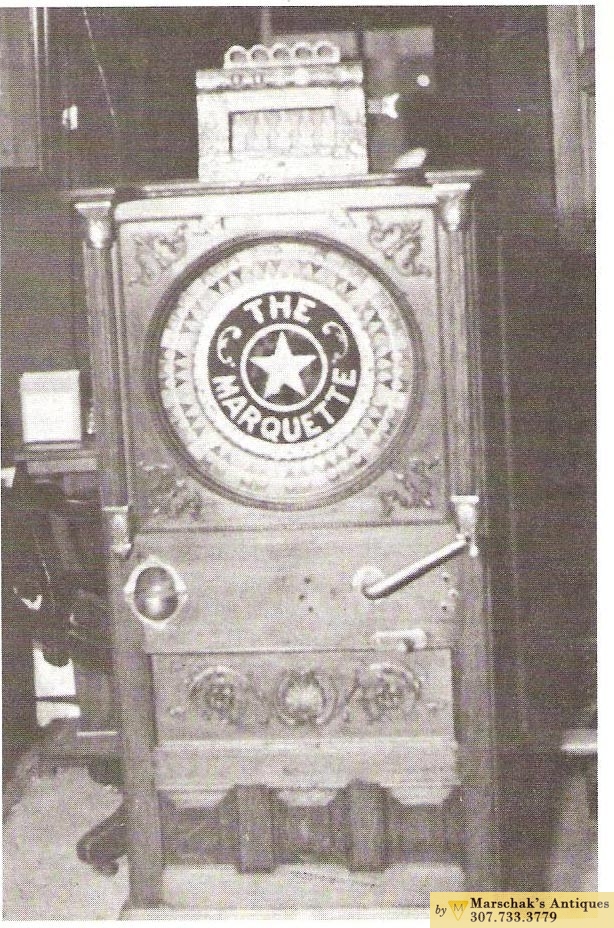 That’s enough time in the economic stratosphere. It’s time to come back down to earth after drooling over the Mills DUPLEX. So face it. You’ll never own one unless you find one, or unless your state lottery ticket puts you in the winner’s circle. Let’s assume you can live with that fact, but want an old color wheel floor machine. So, what kind to get?
That’s enough time in the economic stratosphere. It’s time to come back down to earth after drooling over the Mills DUPLEX. So face it. You’ll never own one unless you find one, or unless your state lottery ticket puts you in the winner’s circle. Let’s assume you can live with that fact, but want an old color wheel floor machine. So, what kind to get?
There’s a lot to choose from. That’s surprising, but true. At the rate these machines are still being discovered, or collectors finally reveal their off-beat holdings, one wonders if we’ll ever have a total tally on what’s out there. When volume 1 came out some collectors were absolutely sure all the old floor machines had been described. Volume 2 floored them. So here’s volume 3 with another dozen or so and there’s just as many in the wings for future volumes.
So what’s desirable? All of them are, of course, but it’s the Watlings that seem to pull the most punch. Dedicated Mills collectors who like the efficient good looks of their floor machines, and Caille buffs who dig the fantastic castings and elaborate trim of their floor models, will probably be gunning for me with that statement. But it’s true! The discovery of another Mills DEWEY or OWL or ON-THE-SQUARE is exciting. Same for another Caille PUCK, DETROIT or, cherish the thought, a BLACK CAT. That’s news. But the discovery of any Watling goes beyond that. It’s an event!
Why is that? Well, for one thing, there seems to be some magic in the Watling name. It’s super nostalgia. Also, the Watling floor machines have a special look all their own. Even a Watling IMPROVED CHICAGO that looks like a Mills CHICAGO has more going for it than the Mills model for a lot of people. Watlings are well, how else can you say it, they’re Watlings.
It wasn’t always that way. The Watlings claimed that they started their company in 1889. They didn’t. What happened was that old Tom Watling and his brother John (John Watling, Tom’s eldest son, was named after his uncle) worked for D.N. Schall And Company in the late 1890s and bought out the firm at the end of 1901. They started to make their own machines in 1902, first using up their Schall inventory. Schall started to make the 5-way MARQUETTE in 1900 in “Plain” and “MUSICAL MARQUETTE” models using a copy-cat version of the Mills slide coin head. Watling kept selling the same machine until they
Schiemer — Yates GIBSON GIRL Floor Wheel
Produced between 1905 and 1906
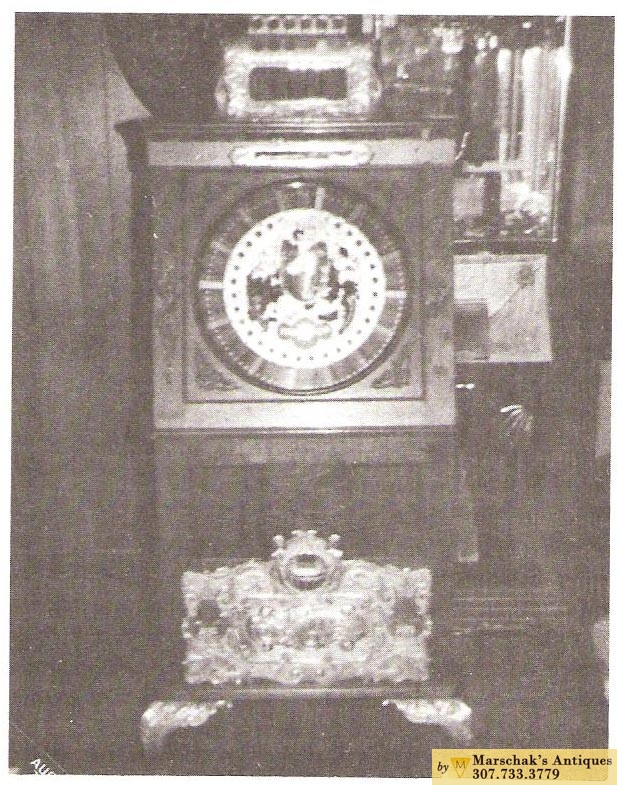 When will it end? When will we stop finding old floor machines, and when will we stop finding machines no one ever heard of before? Beats me! I’d have thought years ago that we’d reached the end and that the salad days of antique slot machine discovery were over. Boy, have I been wrong. These words are being written in early October, 1980, and I’ve got to say that right up to this minute I still get over half a dozen letters or telephone calls a week about slot machine “finds”. On the average, two, maybe even three, of them are for machines no one ever heard of before, or are known from old ads and catalogs but hadn’t previously been found.
When will it end? When will we stop finding old floor machines, and when will we stop finding machines no one ever heard of before? Beats me! I’d have thought years ago that we’d reached the end and that the salad days of antique slot machine discovery were over. Boy, have I been wrong. These words are being written in early October, 1980, and I’ve got to say that right up to this minute I still get over half a dozen letters or telephone calls a week about slot machine “finds”. On the average, two, maybe even three, of them are for machines no one ever heard of before, or are known from old ads and catalogs but hadn’t previously been found.
Where do they come from, and why now? Antique coin machine dealer Ira Warren of New Rochelle, New York, may have the answer. After finding half a dozen 1890’s and early 1900’s machines in just a few months in the summer of 1980, and one at a time at that, Ira opined, “It’s the way our society thinks. A lot of people still have these things. In the basement, or the garage or barn, or still in a store. But they don’t want to move them or clean them up, or even think about them. Tens of dollars don’t interest them. Even hundreds of dollars. That isn’t much these days. But thousands? Now you’re talking something different and you’ll get their attention, and they’ll do the work.” So out they come, these old mechanical treasures of the past. And as long as collectors are willing to pay to pull them out of their lethargy they’ll keep coming.
And we’ll keep learning new things. Like this Schiemer-Yates GIBSON GIRL floor machine. Schiemer-Yates? GIBSON GIRL? Slant front floor machine? Super cabinet and wheel graphics? Holy smoke, what’s this?
I had the same reaction when the machine first showed up. It’s a fantastic slant front that looks like a Caille Bros. VENUS or VICTOR (You’ll see them come up in a few pages) yet has a distinctive look all its own. Whether you know it or not, slant fronts are super prime floor machine collectibles, and not that many of them are known. Until this beauty showed up it was believed that the Caille VENUS and VICTOR models were the only ones ever made. But obviously not.
This machine was found by a Michigan collector in 1977. It has no maker or model names on it, but the castings carry the pattern marks ” S-Y Co.”. That’s enough to go on, for only one early floor machine maker had the initials S.Y., and the firm was quickly identified by the author as the Schiemer-Yates And Company of Detroit, in business from December 12, 1901 until it was absorbed by The Caille Bros. Co. around late
1906. Machinist and wealthy financier Jacob Schiemer was an old and previous partner of Art and Adolph Caille. Robert C. Yates was Art and Adolphs’ brother-in-law. So Jake and Bob went off on their own for a while, and obviously created the slant front format. Their machines were advertised in THE NATIONAL POLICE GAZETTE in April, 1906. But not this one. The glass is fantastic, very colorful, with a marvelous black-and-white halftone of a contemporary poster girl taken from the art of Charles Dana Gibson, whose “Gibson Girl” paintings and drawings personified the ideal American girl of the 1890’s and early 1900’s. So you’ve got to take a chance some time and come up with a machine name where none exists. If floor machine motifs most often reflect machine names we opt for GIBSON GIRL for this one. That’ll do until something more definitive comes along:
Sittman & Pitt LITTLE MODEL CARD MACHINE
Produced between 1891 and 1910
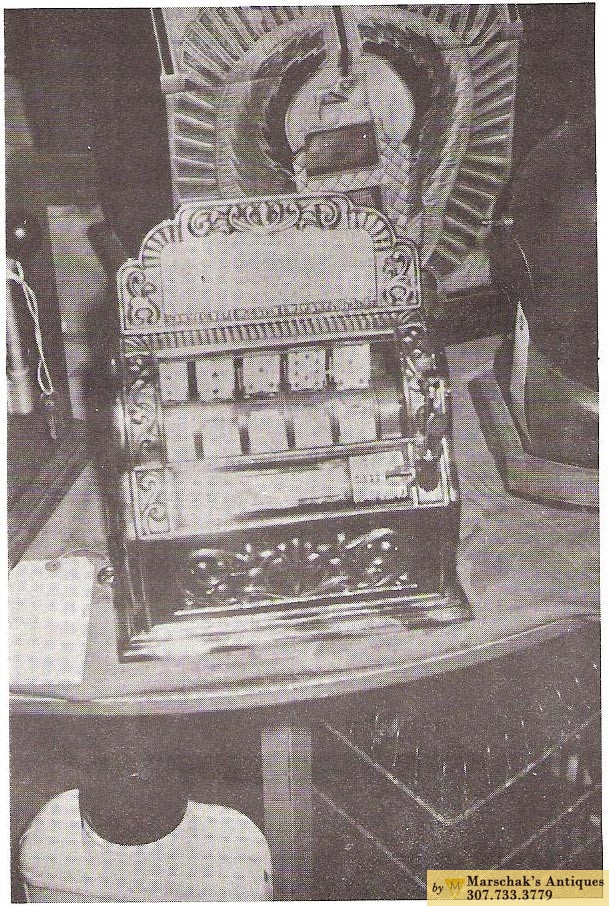 There were certainly coin operated chance machines and trade stimulators before the Sittman & Pitt, but none achieved either the notoriety or the sales success of the LITTLE MODEL CARD MACHINE, the first nationally popular slot machine. The LITTLE MODEL is the oldest coin operated chance machine that can be found in some numbers, as well as in a variety of sizes and styles. The first version came out in 1891, produced by the newly formed Sittman & Pitt firm of Brooklyn, New York. Marketing of the device was left up to wholesalers, saloon equipment dealers, and the catalogue houses that catered to saloons, billiard parlors and pool halls, as well as barber shops, cigar stores, hotels and restaurants. Most of the latter slapped brass nameplates with their own firm name on everything they sold or had the actual cabinets cast to order, no matter who manufactured the product. It was a form of advertising typical of the times, but one that has led to great confusion over eighty years later.
There were certainly coin operated chance machines and trade stimulators before the Sittman & Pitt, but none achieved either the notoriety or the sales success of the LITTLE MODEL CARD MACHINE, the first nationally popular slot machine. The LITTLE MODEL is the oldest coin operated chance machine that can be found in some numbers, as well as in a variety of sizes and styles. The first version came out in 1891, produced by the newly formed Sittman & Pitt firm of Brooklyn, New York. Marketing of the device was left up to wholesalers, saloon equipment dealers, and the catalogue houses that catered to saloons, billiard parlors and pool halls, as well as barber shops, cigar stores, hotels and restaurants. Most of the latter slapped brass nameplates with their own firm name on everything they sold or had the actual cabinets cast to order, no matter who manufactured the product. It was a form of advertising typical of the times, but one that has led to great confusion over eighty years later.
When it first came out the Sittman & Pitt machine was called POKER SOLITAIRE, the idea being that a player could play a hand of poker against the house. It was soon just known as the CARD MACHINE. Five revolving drums had actual miniature playing cards of “Little Duke” size attached at their base, remaining loose at the top. When a coin was dropped and the lever pushed the drums spun and freely flipped the cards, with all five rows soon coming to a somewhat haphazard stop to display a poker hand. A large decorated nickel plated cast iron marquee frame holding a paper reward card offered “Free Cigars” in quantities based on the winning show.
By 1894 the machine had been improved and simplified and was being sold as the LITTLE MODEL CARD MACHINE with a later and a larger version called the MODEL CARD MACHINE. Both can be found with “Monarch, S.F.” “Ogden & Co., Chicago, Ills.” and “Samuel Nafew Co., New York U.S.A.” nameplates or cast cabinets with and without added wooden cash box bases. The larger machine MODEL CARD MACHINE is the rarest version. Unfortunately, the marquees are usually missing from most of these machines.
VICTOR Floor Machine
Produced between 1902 and 1906
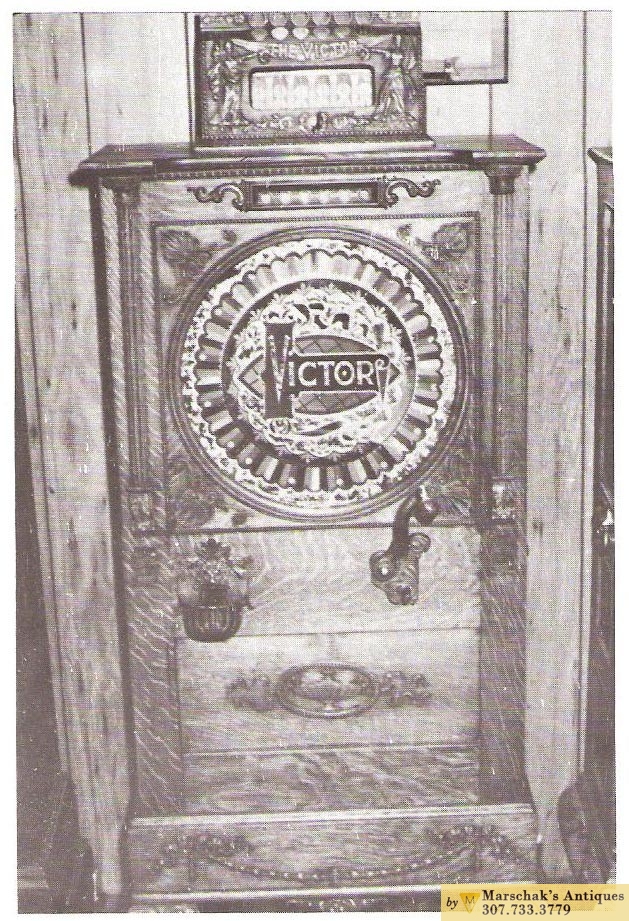 Mills, Caille and Watling weren’t the only producers of popular floor machines; there were at least a dozen other well known firms in the color machine business that made a lot of different models that prospered. One of the next best known is the Victor Novelty Works of Chicago, founded in 1904 and selling well until it became the Eagle Manufacturing Company in 1909, a producer of cast iron counter machines. The heritage of Victor went back to two earlier machine producers of the 1890’s. Collectors that have examples of the Victor 6 way VICTOR often like their machines better than a DEWEY. The machine isn’t quite as big as a DEWEY, but it has much more elegant carving and often better wood work. The VICTOR coin detector is another unique feature, as well as a brightly trimmed glass. Part of the appeal is the uniqueness of the machine. A number of glass variations are known, going from the name VICTOR etched in the glass to a large “V” etched over a footabll, the latter to signify both the Victor name and the Roman symbol for five, or nickel play. Some of the machines still show the artistic decal of the manufacturer on the cabinet, consisting of a silver knight in armour astride a horse with the firm name in a banner. Most Victor machines are commonly known as VICTORS to collectors, because of the name cast in the coin head, although quite a variety were produced and still survive. Known existing examples include a number of VICTOR models in plain and musical cabinets, the 6 way Victor FOUR BITS half-dollar model, the 6 way Victor JACKPOT, 6 way NATIONAL, 6 way SQUARE DEAL and a number of Victor DOUBLES and at least one TRIPLE model.
Mills, Caille and Watling weren’t the only producers of popular floor machines; there were at least a dozen other well known firms in the color machine business that made a lot of different models that prospered. One of the next best known is the Victor Novelty Works of Chicago, founded in 1904 and selling well until it became the Eagle Manufacturing Company in 1909, a producer of cast iron counter machines. The heritage of Victor went back to two earlier machine producers of the 1890’s. Collectors that have examples of the Victor 6 way VICTOR often like their machines better than a DEWEY. The machine isn’t quite as big as a DEWEY, but it has much more elegant carving and often better wood work. The VICTOR coin detector is another unique feature, as well as a brightly trimmed glass. Part of the appeal is the uniqueness of the machine. A number of glass variations are known, going from the name VICTOR etched in the glass to a large “V” etched over a footabll, the latter to signify both the Victor name and the Roman symbol for five, or nickel play. Some of the machines still show the artistic decal of the manufacturer on the cabinet, consisting of a silver knight in armour astride a horse with the firm name in a banner. Most Victor machines are commonly known as VICTORS to collectors, because of the name cast in the coin head, although quite a variety were produced and still survive. Known existing examples include a number of VICTOR models in plain and musical cabinets, the 6 way Victor FOUR BITS half-dollar model, the 6 way Victor JACKPOT, 6 way NATIONAL, 6 way SQUARE DEAL and a number of Victor DOUBLES and at least one TRIPLE model.
The serials on Victor machines run much lower than that of the Mills or Caille machines for the simple reason that nowhere near as many were produced. A plain VICTOR carries the serial 136 with a later musical model identified as E 548. Most of the floor machines were made in the 1904-1907 period, with later Victor production concentrated on counter slots and vending machines. The firm also got involved in other developments, including coin operated phonographs and record changing devices, finally going out of business when the competition got too tough.
Victor LITTLE SIX AMERICA WINS Counter Wheel
Produced between 1908 and 1910
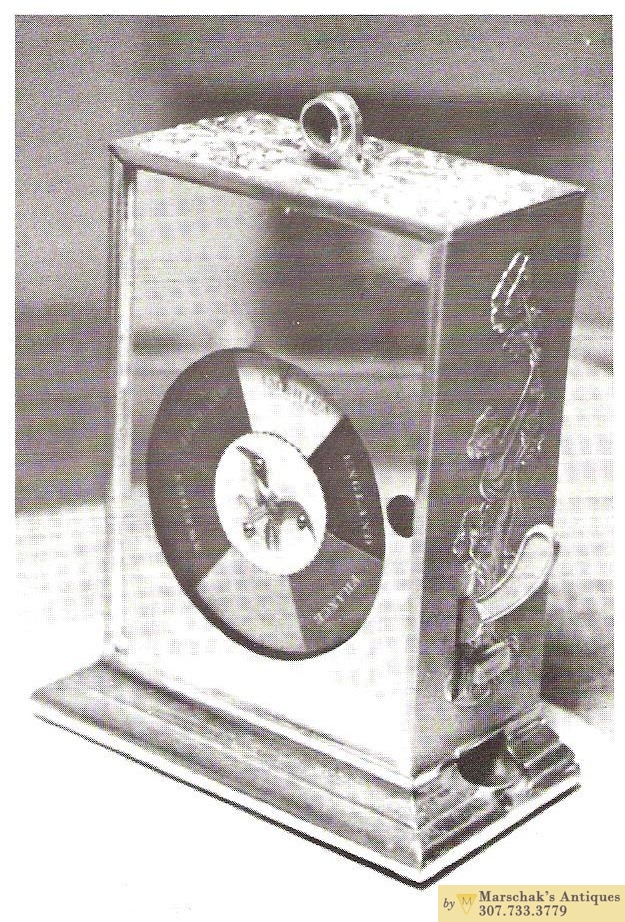 Spinning wheel slot machines started out on the counter with the Schultze, Schall, Cowper and Paupa And Hochriem machines of the middle and late 1890’s, then sat on the floor in big cabinets for a decade or so, only to move back to the counter when floor space began to get costly. There were exceptions both ways, of course, but in general that was the prognosis.
Spinning wheel slot machines started out on the counter with the Schultze, Schall, Cowper and Paupa And Hochriem machines of the middle and late 1890’s, then sat on the floor in big cabinets for a decade or so, only to move back to the counter when floor space began to get costly. There were exceptions both ways, of course, but in general that was the prognosis.
Victor was one of the first to make a machine small enough to move back on the bar. One of the first machines to make the break was the very liberal BIG SIX. Mills made a counter version of their model similar to their BROWNIE and called it the LITTLE SIX. Victor followed the trend with its own LITTLE SIX, and then miniaturized the large color wheel even more to create the LITTLE SIX AMERICA WINS. By making it small they were able to make the cabinet in cast iron rather than wood. Actually, it was almost a necessity, for the machine is so small it needed something to add weight so the customers wouldn’t walk away with the game.
The Victor LITTLE SIX AMERICA WINS doesn’t work the same way as the BIG SIX. It’s single coin head actually just a coin slot, and the forerunner of the gooseneck permitted only one winning color or symbol. The selected winner was “America,” hence the name. But the way Victor characterized “America” and identified the other five symbols and colors on the wheel is quite interesting and characteristic of the times.
At the time the machine was made the United States popularly called “America” was largely a nation of immigrant workers. When someone asked a person’s nationality, they generally replied with the name of the country they came from, whether they were American citizens or not. What the Victor Novelty Works did was pie slice the wheel into six segments, one for the five major ethnic groups then making up the working society of the country, making the sixth their new found homeland, and therefore the winner. So, even if a player hit a loser, stops on the colors for France, Germany, Sweden, Ireland or England gave someone in the bar something to cheer about.
The machine originally came with a beautiful etched glass carrying its name, and at least one has been found that way. Others had this ornate glass replaced years ago with a clear pane or a mirrored pane as shown in the photograph.
Victor TWO BITS Floor Wheel
Produced between 1904 and 1908
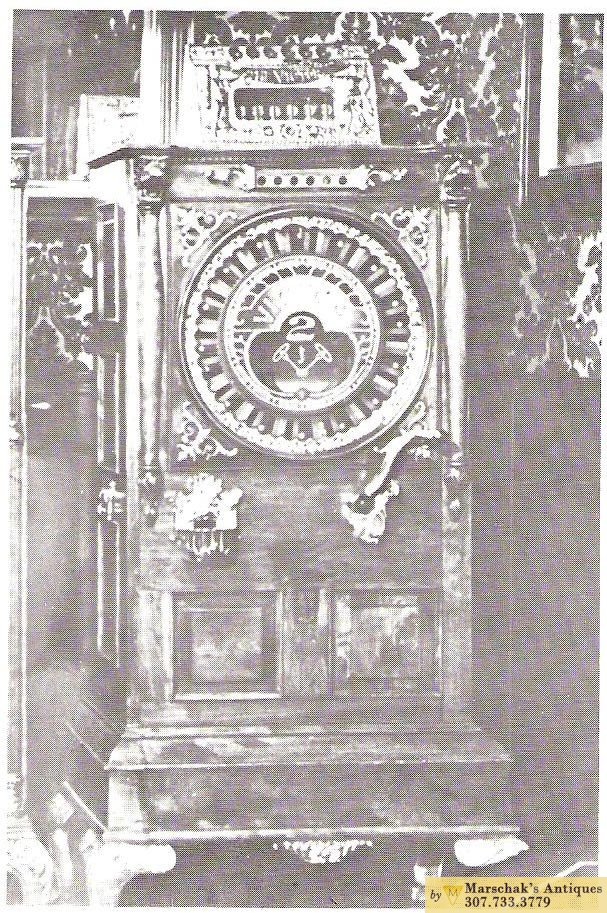 Remember the McDonald BANNER some pages back? And remember that the McDonald Manufacturing Company became something else? What it became was the Victor Novelty Works, and it happened in the fall of 1904. Victor had a lot going for it as a maker of floor machines, joining the other big time producers of the day including Mills, Caille, Watling, Automatic Machine And Tool Company and White. The best thing that Victor had going was the fact that it was in Chicago where all of the other major producers were, with the single exception of Caille Bros. Co. in Detroit. That meant they were very close to every new idea in the business so they could react quickly. It also meant that every idea they had was stolen in an instant.
Remember the McDonald BANNER some pages back? And remember that the McDonald Manufacturing Company became something else? What it became was the Victor Novelty Works, and it happened in the fall of 1904. Victor had a lot going for it as a maker of floor machines, joining the other big time producers of the day including Mills, Caille, Watling, Automatic Machine And Tool Company and White. The best thing that Victor had going was the fact that it was in Chicago where all of the other major producers were, with the single exception of Caille Bros. Co. in Detroit. That meant they were very close to every new idea in the business so they could react quickly. It also meant that every idea they had was stolen in an instant.
In its few short years of existence (we’ll get to that later) Victor built up quite a line, and matched most of the machines made by the others. The 6 way Victor TWO BITS is a classic example. It covered off a whole bunch of 25 cent play competitive machines, from the DEWEY and CHICAGO machines of Mills and Watling to the PUCK and ECLIPSE machines of Caille and everything in between. Victor used the same double horse bit (to denote “two bits”) symbol used by Mills, Watling and Automatic Machine And Tool Company on their front glass, and added enough trim and plating to out-Caille the Caille machines. The result was a marked degree of popularity, and a substantial number of surviving machines.
The Victor TWO BITS and other Victor floor machines have another characteristic favored by collectors, and that’s their mechanisms. Those that know Victor machines prefer them over a Mills DEWEY and swear by the mechanisms, regarding them as far less troublesome and easy to keep operating. That kind of thinking gets to the very core of slot machine collecting. Antique slot machines are more than just art for they are also mechanical art. The collectors revel in their pieces both as art and as machines. That is the basic difference between an art collector and a slot collector, for the latter’s artwork works. The drive train of an old slot is just as important as its appearance, and the symmetry of all the parts in motion can only be compared to a living painting that moves. The industrial arts of America are only now PRICE GUIDE
coming into their own, and slot machine collecting is right at the top of this resurrection. In 1909 Victor evolved into another company, just as McDonald had previously merged into Victor. The firm’s short history paralleled the prime selling days of the automatic color wheel floor machine. You’ll be surprised at what it became.
White AMERICAN BEAUTY Floor Wheel
Produced between 1902 and 1905
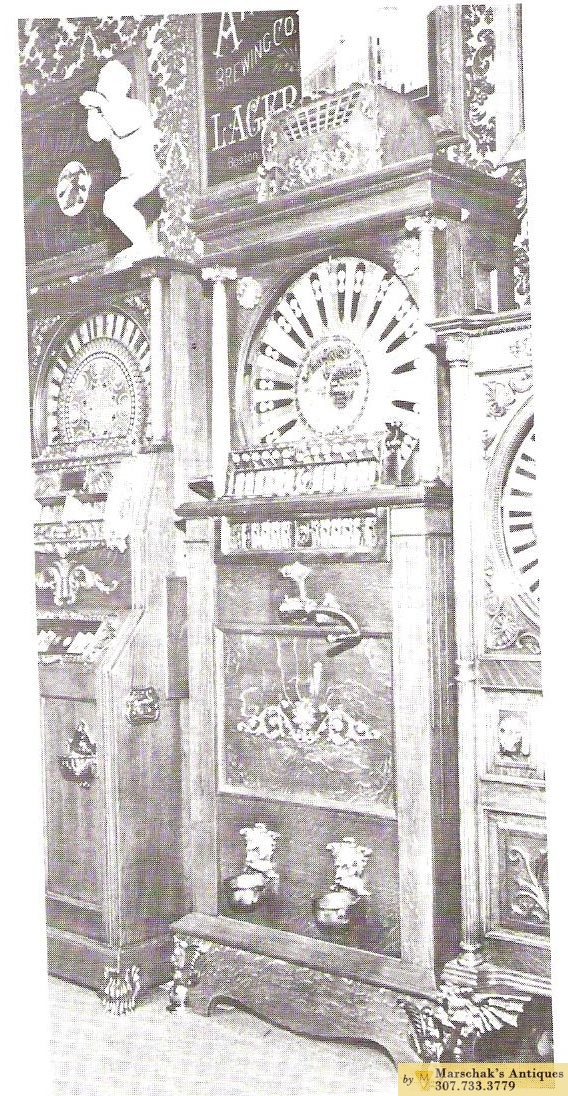 If you ever had any doubts about the position of the White Manufacturing Company as a big time producer of classy and expensive machines one look at an AMERICAN BEAUTY will leave you awed. It is, in a word, awesome. The machine is staggeringly large, and staggeringly beautiful. There’s nothing else like it, and it’s even bigger than a Mills DUPLEX. You can barely see the smaller DUPLEX standing next to it at the left in this picture from Roy Arrington’s collection some years back.
If you ever had any doubts about the position of the White Manufacturing Company as a big time producer of classy and expensive machines one look at an AMERICAN BEAUTY will leave you awed. It is, in a word, awesome. The machine is staggeringly large, and staggeringly beautiful. There’s nothing else like it, and it’s even bigger than a Mills DUPLEX. You can barely see the smaller DUPLEX standing next to it at the left in this picture from Roy Arrington’s collection some years back.
If the White AMERICAN BEAUTY can be compared to anything it is a Mills DUPLEX (the latter machine is covered in Volume 3 of this series of slot collector books) as both of them are “double” machines. The White AMERICAN BEAUTY is a 12 way machine, actually made up of two Berger type six slot coin heads connected to one coin head crank and one playing handle. It’s hard to imagine twelve players clustering around one of these monsters as the early advertising suggests, but you can sure picture one or maybe two players loading up that massive coin head with coins to increase their chances to win. It’s a lot like playing the multiple coin or multiplier machines in Nevada and Jersey today.
Educated guesses say that there are about ten AMERICAN BEAUTY machines in existence, and perhaps more. The machine was built for the bigger and more elegant saloons of its day, and gathered a lot of attention. Most of those that have been found were still in the buildings they ran in three generations ago. That’s not strange, because these buggers are just too big to move on a whim. Just looking at one practically says “saloon,” and if you remember when Steve McQueen got his start on television so many years ago, you might remember that a White AMERICAN BEAUTY was sitting along the wall of most any saloon that McQueen bought a drink in, or plugged a guy with his funny sawed off gun.
The White AMERICAN BEAUTY is a mechanical machine, and came in straight play or as the MUSI.CAL AMERICAN BEAUTY, which makes it an entertainment center in itself. Both models are known to exist. But are you ready for this? When White took over Berger they made all the Berger and later White machines in both mechanical and electrical models, giving them different names. So what is the electrical version of the AMERICAN BEAUTY called, and does anyone have one? The thought of it is mind-boggling.
White CHICAGO RIDGE Floor Wheel
Produced between 1902 and 1904
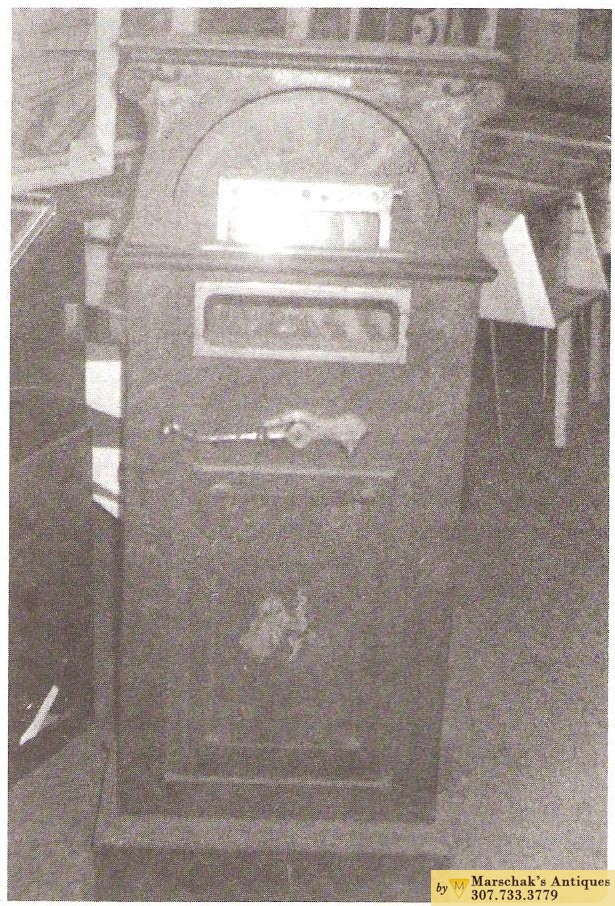 This is just about it for the electrics, the end of the line. After Berger became White, White rattled along a few more years as a slot machine producer and then settled back into the jobbing business, selling other people’s vending machines.
This is just about it for the electrics, the end of the line. After Berger became White, White rattled along a few more years as a slot machine producer and then settled back into the jobbing business, selling other people’s vending machines.
But not before they had a final crack at the floor machine business. Mills, Caille and Watling had it just about wrapped up, but a few sporadic efforts here and there did moderately well, in spite of the big competition, and White seems to have gotten their fair secondary supplier share based on surviving examples.
The original Berger CHICAGO RIDGE of 1897 and afterward was the most successful electric ever made, so the name was golden. You’ll find a complete description of this machine in volume 1. Berger made improvements over the years, but it wasn’t until White took over that the big changes were made in the CHICAGO RIDGE. The Berger’s have a large push slide 5 way coin head that looks like the one on the Paupa And Hochriem THE ALPHONSO. White, on the other hand, upgraded this component by substituting the 5 way side crank coin head patented by Berger in 1901 and used on the Berger DEWEY. The White version is even more elaborate and fool proof and is a commanding element in front of the color wheel.
White also created a completely new cabinet with a flat top, probably so players could set their steins of beer on top when they were ready to drop a few nickles. One can just imagine how ackward that old “Round Top” Berger CHICAGO RIDGE was in a saloon when a two fisted drinker was ready to play.
Other touches are fairly standard; the decals on front and at the upper corners, and the typically White long arm playing handle. Yet in spite of all this extra effort attention the new CHICAGO RIDGE died aborning. Electrics were all but turned off in the public eye by 1902 as the all mechanical automatic color wheels were doing a bang up job of catching the loose nickels that swirled around a saloon or pool hall. White even came back with an IMPROVED CHICAGO RIDGE that had a fully automatic coin head just drop in the nickel(s) and play; no push rod or head crank. But even that couldn’t fly in the face of mechanical success. Switch off’.
White THE LEADER Floor Wheel
Produced between 1902 and 1904
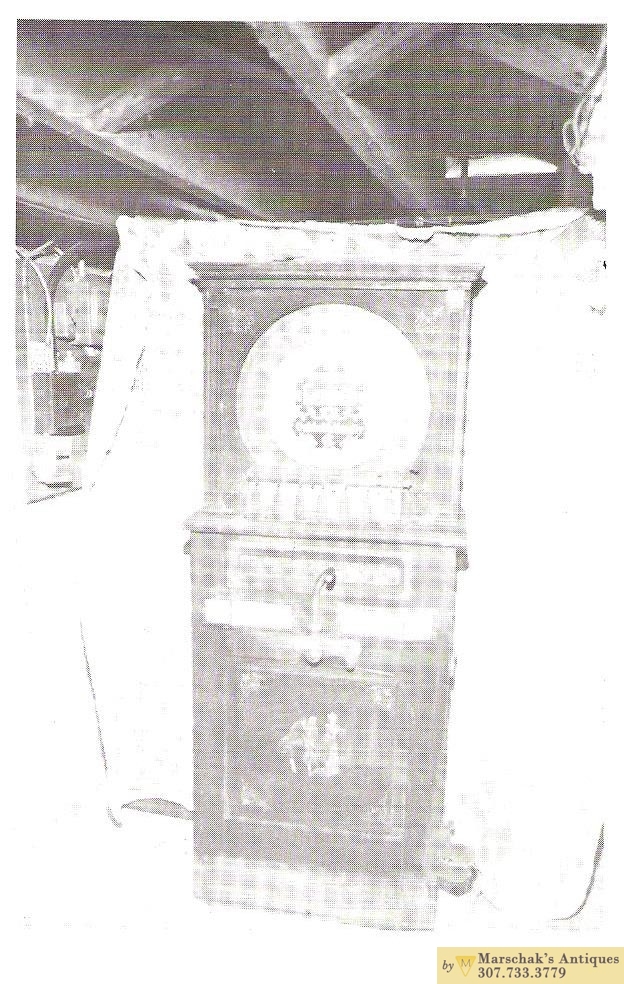 Whenever you start thinking that everyone else has all the machines and that you’ll never be able to afford a big, old time floor machine for your collection, consider this: the large floor machine in the photograph hitherto unknown by name or manufacturer was found in storage by a Wisconsin collector in the summer of 1978. It’s all there, the glass is intact, and once new dry cell batteries were connected, and a little oil was put on the bone dry age old bearings, it worked!
Whenever you start thinking that everyone else has all the machines and that you’ll never be able to afford a big, old time floor machine for your collection, consider this: the large floor machine in the photograph hitherto unknown by name or manufacturer was found in storage by a Wisconsin collector in the summer of 1978. It’s all there, the glass is intact, and once new dry cell batteries were connected, and a little oil was put on the bone dry age old bearings, it worked!
Batteries? Yes, it’s an electric. Actually, the White THE LEADER was theoretically known for some time, but its name was unknown. As we said before, the White Manufacturing Company of Chicago made a long line of floor machines in both mechanical models, picking up many from the old Berger line. One of the better known Berger electrical machines was a seven coin monster called the OOM—PAUL. What wasn’t known was the name of the adaptation by White in either the mechanical or electrical version. Two or three partial examples have been found, but the glass has either been missing, or the cabinet was mostly gone. As a result, they were all “mystery,” or unidentified, machines. An intact discovery was needed; and here it is.
The machine was found in the effects of an old slot machine operator, and there is enough detail on it to tell us quite a bit about its origin and usage. The first and obvious identification is the manufacturer. The Berger/White play handle is obvious, and the typical White decal on the cabinet goes right along with what is known and what we have learned to expect, although it is a bit formal showing a queenly scene from the 18th century. The 7 way coin head is old style Berger with a crank. What is different. and most interesting is the glass. The name THE LEADER is large and highly visible, followed by the identification “Oshkosh Novelty Co.” almost as big. Obviously Oshkosh Novelty liked to blast their name other machines have shown up with similar glass and obviously White was perfectly willing to customize their machines for their operator customers provided the order was big enough. The tricky part is knowing when an operator’s name appears on a machine, and when a manufacturer’s name is shown. That takes knowledge, and research.
The mechanical counterpart to this machine remains to be found, and named. Actually, as valuable as the White THE LEADER is in its electric version, the unnamed mechanical version would be worth even more. Incidentally the serial number of this machine is 26, pressed into the wooden cabinet.

